Euphoric Recall is a reader-supported publication. To receive new posts and support my work, consider becoming a free or paid subscriber.
*Note that Taibbi accidentally skips/mixes up some of his numbers, but all the tweets in this post are laid out as they were presented. Also, given the length, the easiest way to jump to a new “part” is to search using CTRL+F. Use roman numerals (i.e. “Part XV”)
Part I

Matt Taibbi@mtaibbi
1. Thread: THE TWITTER FILES
11:34 PM · Dec 2, 2022
132K Reposts · 380K Likes

Matt Taibbi@mtaibbi
2. What you’re about to read is the first installment in a series, based upon thousands of internal documents obtained by sources at Twitter.
11:39 PM · Dec 2, 2022
15.5K Reposts · 109K Likes

Matt Taibbi@mtaibbi
3. The “Twitter Files” tell an incredible story from inside one of the world’s largest and most influential social media platforms. It is a Frankensteinian tale of a human-built mechanism grown out the control of its designer.
11:41 PM · Dec 2, 2022
14.4K Reposts · 103K Likes

Matt Taibbi@mtaibbi
4. Twitter in its conception was a brilliant tool for enabling instant mass communication, making a true real-time global conversation possible for the first time.
11:43 PM · Dec 2, 2022
11.2K Reposts · 89.3K Likes

Matt Taibbi@mtaibbi
5. In an early conception, Twitter more than lived up to its mission statement, giving people “the power to create and share ideas and information instantly, without barriers.”
11:45 PM · Dec 2, 2022
10.7K Reposts · 84.3K Likes

Matt Taibbi@mtaibbi
6. As time progressed, however, the company was slowly forced to add those barriers. Some of the first tools for controlling speech were designed to combat the likes of spam and financial fraudsters.
11:46 PM · Dec 2, 2022
11.2K Reposts · 86.5K Likes

Matt Taibbi@mtaibbi
7. Slowly, over time, Twitter staff and executives began to find more and more uses for these tools. Outsiders began petitioning the company to manipulate speech as well: first a little, then more often, then constantly.
11:47 PM · Dec 2, 2022
15K Reposts · 99.1K Likes

Matt Taibbi@mtaibbi
8. By 2020, requests from connected actors to delete tweets were routine. One executive would write to another: “More to review from the Biden team.” The reply would come back: “Handled.”

11:52 PM · Dec 2, 2022
39.5K Reposts · 155K Likes

Matt Taibbi@mtaibbi
9. Celebrities and unknowns alike could be removed or reviewed at the behest of a political party:

11:56 PM · Dec 2, 2022
22.7K Reposts · 113K Likes

Matt Taibbi@mtaibbi
10.Both parties had access to these tools. For instance, in 2020, requests from both the Trump White House and the Biden campaign were received and honored. However:
11:58 PM · Dec 2, 2022
13K Reposts · 85.5K Likes

Matt Taibbi@mtaibbi
11. This system wasn't balanced. It was based on contacts. Because Twitter was and is overwhelmingly staffed by people of one political orientation, there were more channels, more ways to complain, open to the left (well, Democrats) than the right. opensecrets.org/orgs/twitter/s…

12:02 AM · Dec 3, 2022
24.5K Reposts · 116K Likes

Matt Taibbi@mtaibbi
12. The resulting slant in content moderation decisions is visible in the documents you’re about to read. However, it’s also the assessment of multiple current and former high-level executives.
12:04 AM · Dec 3, 2022
12.3K Reposts · 86K Likes

Matt Taibbi@mtaibbi
Okay, there was more throat-clearing about the process, but screw it, let's jump forward
12:05 AM · Dec 3, 2022
8.34K Reposts · 73.6K Likes

Matt Taibbi@mtaibbi
16. The Twitter Files, Part One: How and Why Twitter Blocked the Hunter Biden Laptop Story
12:06 AM · Dec 3, 2022
17.6K Reposts · 91.4K Likes

Matt Taibbi@mtaibbi
17. On October 14, 2020, the New York Post published BIDEN SECRET EMAILS, an expose based on the contents of Hunter Biden’s abandoned laptop:
nypost.com
Smoking-gun email reveals how Hunter Biden introduced Ukrainian businessman to VP dad

12:07 AM · Dec 3, 2022
24.8K Reposts · 103K Likes

Matt Taibbi@mtaibbi
18. Twitter took extraordinary steps to suppress the story, removing links and posting warnings that it may be “unsafe.” They even blocked its transmission via direct message, a tool hitherto reserved for extreme cases, e.g. child pornography.
12:08 AM · Dec 3, 2022
24K Reposts · 115K Likes

Matt Taibbi@mtaibbi
19. White House spokeswoman Kaleigh McEnany was locked out of her account for tweeting about the story, prompting a furious letter from Trump campaign staffer Mike Hahn, who seethed: “At least pretend to care for the next 20 days.”

12:09 AM · Dec 3, 2022
22.7K Reposts · 116K Likes

Matt Taibbi@mtaibbi
20.This led public policy executive Caroline Strom to send out a polite WTF query. Several employees noted that there was tension between the comms/policy teams, who had little/less control over moderation, and the safety/trust teams:

12:12 AM · Dec 3, 2022
11.7K Reposts · 73.5K Likes

Matt Taibbi@mtaibbi
21. Strom’s note returned the answer that the laptop story had been removed for violation of the company’s “hacked materials” policy: https://t.co/EdTa2xbXn1

12:13 AM · Dec 3, 2022
12.6K Reposts · 73.6K Likes

Matt Taibbi@mtaibbi
22. Although several sources recalled hearing about a “general” warning from federal law enforcement that summer about possible foreign hacks, there’s no evidence - that I've seen - of any government involvement in the laptop story. In fact, that might have been the problem...
12:18 AM · Dec 3, 2022
11.4K Reposts · 75.3K Likes

Matt Taibbi@mtaibbi
23. The decision was made at the highest levels of the company, but without the knowledge of CEO Jack Dorsey, with former head of legal, policy and trust Vijaya Gadde playing a key role.
12:19 AM · Dec 3, 2022
16.7K Reposts · 90.4K Likes

Matt Taibbi@mtaibbi
24. “They just freelanced it,” is how one former employee characterized the decision. “Hacking was the excuse, but within a few hours, pretty much everyone realized that wasn’t going to hold. But no one had the guts to reverse it.”
12:19 AM · Dec 3, 2022
14.2K Reposts · 83.6K Likes

Matt Taibbi@mtaibbi
25.You can see the confusion in the following lengthy exchange, which ends up including Gadde and former Trust and safety chief Yoel Roth. Comms official Trenton Kennedy writes, “I'm struggling to understand the policy basis for marking this as unsafe”:

12:21 AM · Dec 3, 2022
14.8K Reposts · 79.5K Likes

Matt Taibbi@mtaibbi
26. By this point “everyone knew this was fucked,” said one former employee, but the response was essentially to err on the side of… continuing to err.

12:24 AM · Dec 3, 2022
14.3K Reposts · 77.1K Likes

Matt Taibbi@mtaibbi
27. Former VP of Global Comms Brandon Borrman asks, “Can we truthfully claim that this is part of the policy?”

12:26 AM · Dec 3, 2022
11.3K Reposts · 69.4K Likes

Matt Taibbi@mtaibbi
28. To which former Deputy General Counsel Jim Baker again seems to advise staying the non-course, because “caution is warranted”:

12:28 AM · Dec 3, 2022
11.1K Reposts · 65.9K Likes

Matt Taibbi@mtaibbi
29. A fundamental problem with tech companies and content moderation: many people in charge of speech know/care little about speech, and have to be told the basics by outsiders. To wit:
12:30 AM · Dec 3, 2022
10.9K Reposts · 72.6K Likes

Matt Taibbi@mtaibbi
30. In one humorous exchange on day 1, Democratic congressman Ro Khanna reaches out to Gadde to gently suggest she hop on the phone to talk about the “backlash re speech.” Khanna was the only Democratic official I could find in the files who expressed concern.

12:31 AM · Dec 3, 2022
11.3K Reposts · 68K Likes

Matt Taibbi@mtaibbi
Gadde replies quickly, immediately diving into the weeds of Twitter policy, unaware Khanna is more worried about the Bill of Rights:

12:32 AM · Dec 3, 2022
10.9K Reposts · 64.6K Likes

Matt Taibbi@mtaibbi
32.Khanna tries to reroute the conversation to the First Amendment, mention of which is generally hard to find in the files:

12:34 AM · Dec 3, 2022
14K Reposts · 76.9K Likes

Matt Taibbi@mtaibbi
33.Within a day, head of Public Policy Lauren Culbertson receives a ghastly letter/report from Carl Szabo of the research firm NetChoice, which had already polled 12 members of congress – 9 Rs and 3 Democrats, from “the House Judiciary Committee to Rep. Judy Chu’s office.”

12:38 AM · Dec 3, 2022
10.3K Reposts · 62K Likes

Matt Taibbi@mtaibbi
34.NetChoice lets Twitter know a “blood bath” awaits in upcoming Hill hearings, with members saying it's a "tipping point," complaining tech has “grown so big that they can’t even regulate themselves, so government may need to intervene.”

12:42 AM · Dec 3, 2022
8.92K Reposts · 50.5K Likes

Matt Taibbi@mtaibbi
35.Szabo reports to Twitter that some Hill figures are characterizing the laptop story as “tech’s Access Hollywood moment”:

12:43 AM · Dec 3, 2022
8.61K Reposts · 50.2K Likes

Matt Taibbi@mtaibbi
36.Twitter files continued:
"THE FIRST AMENDMENT ISN’T ABSOLUTE”
Szabo’s letter contains chilling passages relaying Democratic lawmakers’ attitudes. They want “more” moderation, and as for the Bill of Rights, it's "not absolute"

12:45 AM · Dec 3, 2022
22.3K Reposts · 79.2K Likes

Matt Taibbi@mtaibbi
An amazing subplot of the Twitter/Hunter Biden laptop affair was how much was done without the knowledge of CEO Jack Dorsey, and how long it took for the situation to get "unfucked" (as one ex-employee put it) even after Dorsey jumped in.
12:55 AM · Dec 3, 2022
13K Reposts · 76.7K Likes

Matt Taibbi@mtaibbi
There are multiple instances in the files of Dorsey intervening to question suspensions and other moderation actions, for accounts across the political spectrum
1:10 AM · Dec 3, 2022
7.12K Reposts · 47.7K Likes

Matt Taibbi@mtaibbi
The problem with the "hacked materials" ruling, several sources said, was that this normally required an official/law enforcement finding of a hack. But such a finding never appears throughout what one executive describes as a "whirlwind" 24-hour, company-wide mess.

1:30 AM · Dec 3, 2022
8.5K Reposts · 43.7K Likes

Matt Taibbi@mtaibbi
It's been a whirlwind 96 hours for me, too. There is much more to come, including answers to questions about issues like shadow-banning, boosting, follower counts, the fate of various individual accounts, and more. These issues are not limited to the political right.
1:35 AM · Dec 3, 2022
12.8K Reposts · 87K Likes

Matt Taibbi@mtaibbi
Good night, everyone. Thanks to all those who picked up the phone in the last few days.
1:37 AM · Dec 3, 2022
4.74K Reposts · 81.7K Likes
Part II

Bari Weiss@bariweiss
THREAD: THE TWITTER FILES PART TWO.
TWITTER’S SECRET BLACKLISTS.
12:15 AM · Dec 9, 2022
88.3K Reposts · 248K Likes

Bari Weiss@bariweiss
1. A new #TwitterFiles investigation reveals that teams of Twitter employees build blacklists, prevent disfavored tweets from trending, and actively limit the visibility of entire accounts or even trending topics—all in secret, without informing users.
12:20 AM · Dec 9, 2022
31.3K Reposts · 122K Likes

Bari Weiss@bariweiss
2. Twitter once had a mission “to give everyone the power to create and share ideas and information instantly, without barriers.” Along the way, barriers nevertheless were erected.
12:24 AM · Dec 9, 2022
12.9K Reposts · 81.5K Likes

Bari Weiss@bariweiss
3. Take, for example, Stanford’s Dr. Jay Bhattacharya (@DrJBhattacharya) who argued that Covid lockdowns would harm children. Twitter secretly placed him on a “Trends Blacklist,” which prevented his tweets from trending.

12:30 AM · Dec 9, 2022
29.5K Reposts · 113K Likes

Bari Weiss@bariweiss
4. Or consider the popular right-wing talk show host, Dan Bongino (@dbongino), who at one point was slapped with a “Search Blacklist.”

12:33 AM · Dec 9, 2022
18K Reposts · 84.4K Likes

Bari Weiss@bariweiss
5. Twitter set the account of conservative activist Charlie Kirk (@charliekirk11) to “Do Not Amplify.”

12:36 AM · Dec 9, 2022
18.2K Reposts · 85K Likes

Bari Weiss@bariweiss
6. Twitter denied that it does such things. In 2018, Twitter's Vijaya Gadde (then Head of Legal Policy and Trust) and Kayvon Beykpour (Head of Product) said: “We do not shadow ban.” They added: “And we certainly don’t shadow ban based on political viewpoints or ideology.”
12:40 AM · Dec 9, 2022
18.9K Reposts · 99.7K Likes

Bari Weiss@bariweiss
7. What many people call “shadow banning,” Twitter executives and employees call “Visibility Filtering” or “VF.” Multiple high-level sources confirmed its meaning.
12:41 AM · Dec 9, 2022
15.1K Reposts · 83.4K Likes

Bari Weiss@bariweiss
8. “Think about visibility filtering as being a way for us to suppress what people see to different levels. It’s a very powerful tool,” one senior Twitter employee told us.
12:43 AM · Dec 9, 2022
12.9K Reposts · 74.5K Likes

Bari Weiss@bariweiss
9. “VF” refers to Twitter’s control over user visibility. It used VF to block searches of individual users; to limit the scope of a particular tweet’s discoverability; to block select users’ posts from ever appearing on the “trending” page; and from inclusion in hashtag searches.
12:47 AM · Dec 9, 2022
12.6K Reposts · 70K Likes

Bari Weiss@bariweiss
10. All without users’ knowledge.
12:47 AM · Dec 9, 2022
10.6K Reposts · 68.8K Likes

Bari Weiss@bariweiss
11. “We control visibility quite a bit. And we control the amplification of your content quite a bit. And normal people do not know how much we do,” one Twitter engineer told us. Two additional Twitter employees confirmed.
12:48 AM · Dec 9, 2022
13.8K Reposts · 73K Likes

Bari Weiss@bariweiss
12. The group that decided whether to limit the reach of certain users was the Strategic Response Team - Global Escalation Team, or SRT-GET. It often handled up to 200 "cases" a day.
12:50 AM · Dec 9, 2022
11K Reposts · 64.1K Likes

Bari Weiss@bariweiss
13. But there existed a level beyond official ticketing, beyond the rank-and-file moderators following the company’s policy on paper. That is the “Site Integrity Policy, Policy Escalation Support,” known as “SIP-PES.”
12:54 AM · Dec 9, 2022
9.77K Reposts · 58.6K Likes

Bari Weiss@bariweiss
14. This secret group included Head of Legal, Policy, and Trust (Vijaya Gadde), the Global Head of Trust & Safety (Yoel Roth), subsequent CEOs Jack Dorsey and Parag Agrawal, and others.
12:55 AM · Dec 9, 2022
13.1K Reposts · 67.5K Likes

Bari Weiss@bariweiss
15. This is where the biggest, most politically sensitive decisions got made. “Think high follower account, controversial,” another Twitter employee told us. For these “there would be no ticket or anything.”
12:57 AM · Dec 9, 2022
10.5K Reposts · 61.7K Likes

Bari Weiss@bariweiss
16. One of the accounts that rose to this level of scrutiny was @libsoftiktok—an account that was on the “Trends Blacklist” and was designated as “Do Not Take Action on User Without Consulting With SIP-PES.”

1:00 AM · Dec 9, 2022
15.9K Reposts · 75.6K Likes

Bari Weiss@bariweiss
17. The account—which Chaya Raichik began in November 2020 and now boasts over 1.4 million followers—was subjected to six suspensions in 2022 alone, Raichik says. Each time, Raichik was blocked from posting for as long as a week.
1:03 AM · Dec 9, 2022
9.81K Reposts · 61.3K Likes

Bari Weiss@bariweiss
18. Twitter repeatedly informed Raichik that she had been suspended for violating Twitter’s policy against “hateful conduct.”
1:04 AM · Dec 9, 2022
8.59K Reposts · 56.3K Likes

Bari Weiss@bariweiss
19. But in an internal SIP-PES memo from October 2022, after her seventh suspension, the committee acknowledged that “LTT has not directly engaged in behavior violative of the Hateful Conduct policy." See here:

1:08 AM · Dec 9, 2022
11.7K Reposts · 63.5K Likes

Bari Weiss@bariweiss
20. The committee justified her suspensions internally by claiming her posts encouraged online harassment of “hospitals and medical providers” by insinuating “that gender-affirming healthcare is equivalent to child abuse or grooming.”
1:09 AM · Dec 9, 2022
9.64K Reposts · 59.7K Likes

Bari Weiss@bariweiss
21. Compare this to what happened when Raichik herself was doxxed on November 21, 2022. A photo of her home with her address was posted in a tweet that has garnered more than 10,000 likes.
1:11 AM · Dec 9, 2022
9.89K Reposts · 60K Likes

Bari Weiss@bariweiss
22. When Raichik told Twitter that her address had been disseminated she says Twitter Support responded with this message: "We reviewed the reported content, and didn't find it to be in violation of the Twitter rules." No action was taken. The doxxing tweet is still up.

1:16 AM · Dec 9, 2022
12.4K Reposts · 64.8K Likes

Bari Weiss@bariweiss
23. In internal Slack messages, Twitter employees spoke of using technicalities to restrict the visibility of tweets and subjects. Here’s Yoel Roth, Twitter’s then Global Head of Trust & Safety, in a direct message to a colleague in early 2021:

1:18 AM · Dec 9, 2022
8.51K Reposts · 49.8K Likes

Bari Weiss@bariweiss
24. Six days later, in a direct message with an employee on the Health, Misinformation, Privacy, and Identity research team, Roth requested more research to support expanding “non-removal policy interventions like disabling engagements and deamplification/visibility filtering.”

1:19 AM · Dec 9, 2022
8.53K Reposts · 48.9K Likes

Bari Weiss@bariweiss
25. Roth wrote: “The hypothesis underlying much of what we’ve implemented is that if exposure to, e.g., misinformation directly causes harm, we should use remediations that reduce exposure, and limiting the spread/virality of content is a good way to do that.”
1:20 AM · Dec 9, 2022
7.35K Reposts · 46.4K Likes

Bari Weiss@bariweiss
26. He added: “We got Jack on board with implementing this for civic integrity in the near term, but we’re going to need to make a more robust case to get this into our repertoire of policy remediations – especially for other policy domains.”
1:21 AM · Dec 9, 2022
7.92K Reposts · 47.8K Likes

Bari Weiss@bariweiss
27. There is more to come on this story, which was reported by @AbigailShrier @ShellenbergerMD @NellieBowles @IsaacGrafstein and the team The Free Press @TheFP.
Keep up with this unfolding story here and at our brand new website: thefp.com.
1:27 AM · Dec 9, 2022
9.41K Reposts · 52.2K Likes

Bari Weiss@bariweiss
28. The authors have broad and expanding access to Twitter’s files. The only condition we agreed to was that the material would first be published on Twitter.
1:28 AM · Dec 9, 2022
7.09K Reposts · 50.9K Likes

Bari Weiss@bariweiss
29. We're just getting started on our reporting. Documents cannot tell the whole story here. A big thank you to everyone who has spoken to us so far. If you are a current or former Twitter employee, we'd love to hear from you. Please write to: tips@thefp.com
1:38 AM · Dec 9, 2022
8.17K Reposts · 56.3K Likes

Bari Weiss@bariweiss
30. Watch @mtaibbi for the next installment.
1:40 AM · Dec 9, 2022
7.96K Reposts · 58.7K Likes
Part III

Matt Taibbi@mtaibbi
1. THREAD: The Twitter Files
THE REMOVAL OF DONALD TRUMP
Part One: October 2020-January 6th
11:04 PM · Dec 9, 2022
22K Reposts · 54.8K Likes

Matt Taibbi@mtaibbi
2. The world knows much of the story of what happened between riots at the Capitol on January 6th, and the removal of President Donald Trump from Twitter on January 8th...
11:06 PM · Dec 9, 2022
3.85K Reposts · 20.4K Likes

Matt Taibbi@mtaibbi
3. We’ll show you what hasn’t been revealed: the erosion of standards within the company in months before J6, decisions by high-ranking executives to violate their own policies, and more, against the backdrop of ongoing, documented interaction with federal agencies.
11:07 PM · Dec 9, 2022
4.82K Reposts · 23K Likes

Matt Taibbi@mtaibbi
4. This first installment covers the period before the election through January 6th. Tomorrow, @ShellenbergerMD will detail the chaos inside Twitter on January 7th. On Sunday, @bariweiss will reveal the secret internal communications from the key date of January 8th.
11:10 PM · Dec 9, 2022
5.04K Reposts · 22.1K Likes

Matt Taibbi@mtaibbi
@ShellenbergerMD @bariweiss 5. Whatever your opinion on the decision to remove Trump that day, the internal communications at Twitter between January 6th-January 8th have clear historical import. Even Twitter’s employees understood in the moment it was a landmark moment in the annals of speech.

11:14 PM · Dec 9, 2022
4.3K Reposts · 19.4K Likes

Matt Taibbi@mtaibbi
@ShellenbergerMD @bariweiss 6. As soon as they finished banning Trump, Twitter execs started processing new power. They prepared to ban future presidents and White Houses – perhaps even Joe Biden. The “new administration,” says one exec, “will not be suspended by Twitter unless absolutely necessary.”

11:19 PM · Dec 9, 2022
4.33K Reposts · 17.5K Likes

Matt Taibbi@mtaibbi
@ShellenbergerMD @bariweiss 7. Twitter executives removed Trump in part over what one executive called the “context surrounding”: actions by Trump and supporters “over the course of the election and frankly last 4+ years.” In the end, they looked at a broad picture. But that approach can cut both ways.

11:24 PM · Dec 9, 2022
3.7K Reposts · 15.7K Likes

Matt Taibbi@mtaibbi
@ShellenbergerMD @bariweiss 8. The bulk of the internal debate leading to Trump’s ban took place in those three January days. However, the intellectual framework was laid in the months preceding the Capitol riots.
11:25 PM · Dec 9, 2022
3.65K Reposts · 17K Likes

Matt Taibbi@mtaibbi
@ShellenbergerMD @bariweiss 9. Before J6, Twitter was a unique mix of automated, rules-based enforcement, and more subjective moderation by senior executives. As @bariweiss reported, the firm had a vast array of tools for manipulating visibility, most all of which were thrown at Trump (and others) pre-J6.
11:29 PM · Dec 9, 2022
3.72K Reposts · 16.1K Likes

Matt Taibbi@mtaibbi
@ShellenbergerMD @bariweiss 10. As the election approached, senior executives – perhaps under pressure from federal agencies, with whom they met more as time progressed – increasingly struggled with rules, and began to speak of “vios” as pretexts to do what they’d likely have done anyway.
11:31 PM · Dec 9, 2022
4.22K Reposts · 18.9K Likes

Matt Taibbi@mtaibbi
@ShellenbergerMD @bariweiss 11. After J6, internal Slacks show Twitter executives getting a kick out of intensified relationships with federal agencies. Here’s Trust and Safety head Yoel Roth, lamenting a lack of “generic enough” calendar descriptions to concealing his “very interesting” meeting partners.

11:35 PM · Dec 9, 2022
5.06K Reposts · 17.3K Likes

Matt Taibbi@mtaibbi
@ShellenbergerMD @bariweiss 12. These initial reports are based on searches for docs linked to prominent executives, whose names are already public. They include Roth, former trust and policy chief Vijaya Gadde, and recently plank-walked Deputy General Counsel (and former top FBI lawyer) Jim Baker.
11:37 PM · Dec 9, 2022
3.02K Reposts · 14.2K Likes

Matt Taibbi@mtaibbi
@ShellenbergerMD @bariweiss 13. One particular slack channel offers an unique window into the evolving thinking of top officials in late 2020 and early 2021.
11:38 PM · Dec 9, 2022
2.48K Reposts · 12.4K Likes

Matt Taibbi@mtaibbi
@ShellenbergerMD @bariweiss 14. On October 8th, 2020, executives opened a channel called “us2020_xfn_enforcement.” Through J6, this would be home for discussions about election-related removals, especially ones that involved “high-profile” accounts (often called “VITs” or “Very Important Tweeters”).

11:40 PM · Dec 9, 2022
3.22K Reposts · 12.8K Likes

Matt Taibbi@mtaibbi
@ShellenbergerMD @bariweiss 15. There was at least some tension between Safety Operations – a larger department whose staffers used a more rules-based process for addressing issues like porn, scams, and threats – and a smaller, more powerful cadre of senior policy execs like Roth and Gadde.
11:41 PM · Dec 9, 2022
2.72K Reposts · 12.9K Likes

Matt Taibbi@mtaibbi
@ShellenbergerMD @bariweiss 16. The latter group were a high-speed Supreme Court of moderation, issuing content rulings on the fly, often in minutes and based on guesses, gut calls, even Google searches, even in cases involving the President.

11:46 PM · Dec 9, 2022
4.1K Reposts · 14.7K Likes

Matt Taibbi@mtaibbi
@ShellenbergerMD @bariweiss 17. During this time, executives were also clearly liaising with federal enforcement and intelligence agencies about moderation of election-related content. While we’re still at the start of reviewing the #TwitterFiles, we’re finding out more about these interactions every day.
11:47 PM · Dec 9, 2022
3.77K Reposts · 15.1K Likes

Matt Taibbi@mtaibbi
@ShellenbergerMD @bariweiss 18. Policy Director Nick Pickles is asked if they should say Twitter detects “misinfo” through “ML, human review, and **partnerships with outside experts?*” The employee asks, “I know that’s been a slippery process… not sure if you want our public explanation to hang on that.”
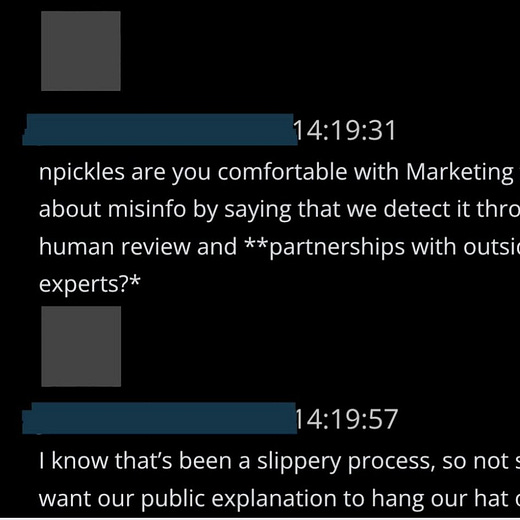
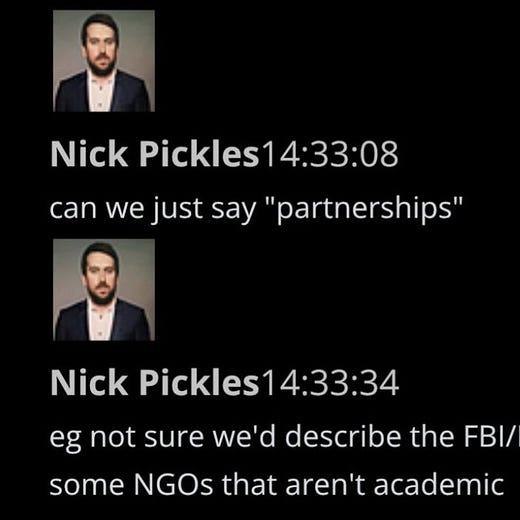
11:51 PM · Dec 9, 2022
2.92K Reposts · 11.7K Likes

Matt Taibbi@mtaibbi
@ShellenbergerMD @bariweiss 19. Pickles quickly asks if they could “just say “partnerships.” After a pause, he says, “e.g. not sure we’d describe the FBI/DHS as experts.”

11:52 PM · Dec 9, 2022
3.39K Reposts · 12.7K Likes

Matt Taibbi@mtaibbi
@ShellenbergerMD @bariweiss 20. This post about the Hunter Biden laptop situation shows that Roth not only met weekly with the FBI and DHS, but with the Office of the Director of National Intelligence (DNI):

11:54 PM · Dec 9, 2022
4.97K Reposts · 14.7K Likes

Matt Taibbi@mtaibbi
@ShellenbergerMD @bariweiss 21. Roth’s report to FBI/DHS/DNI is almost farcical in its self-flagellating tone:
“We blocked the NYP story, then unblocked it (but said the opposite)… comms is angry, reporters think we’re idiots… in short, FML” (fuck my life).

11:56 PM · Dec 9, 2022
2.92K Reposts · 11.2K Likes

Matt Taibbi@mtaibbi
@ShellenbergerMD @bariweiss 23. Some of Roth’s later Slacks indicate his weekly confabs with federal law enforcement involved separate meetings. Here, he ghosts the FBI and DHS, respectively, to go first to an “Aspen Institute thing,” then take a call with Apple.

11:58 PM · Dec 9, 2022
2.95K Reposts · 11.2K Likes

Matt Taibbi@mtaibbi
@ShellenbergerMD @bariweiss 24. Here, the FBI sends reports about a pair of tweets, the second of which involves a former Tippecanoe County, Indiana Councilor and Republican named @JohnBasham claiming “Between 2% and 25% of Ballots by Mail are Being Rejected for Errors.”

12:00 AM · Dec 10, 2022
3.13K Reposts · 11.3K Likes

Matt Taibbi@mtaibbi
@ShellenbergerMD @bariweiss @JohnBasham The FBI's second report concerned this tweet by @JohnBasham:

12:02 AM · Dec 10, 2022
3.28K Reposts · 11.5K Likes

Matt Taibbi@mtaibbi
@ShellenbergerMD @bariweiss @JohnBasham 25. The FBI-flagged tweet then got circulated in the enforcement Slack. Twitter cited Politifact to say the first story was “proven to be false,” then noted the second was already deemed “no vio on numerous occasions.”

12:03 AM · Dec 10, 2022
2.53K Reposts · 10.2K Likes

Matt Taibbi@mtaibbi
@ShellenbergerMD @bariweiss @JohnBasham 26. The group then decides to apply a “Learn how voting is safe and secure” label because one commenter says, “it’s totally normal to have a 2% error rate.” Roth then gives the final go-ahead to the process initiated by the FBI:

12:04 AM · Dec 10, 2022
2.63K Reposts · 10.3K Likes

Matt Taibbi@mtaibbi
@ShellenbergerMD @bariweiss @JohnBasham 27. Examining the entire election enforcement Slack, we didn’t see one reference to moderation requests from the Trump campaign, the Trump White House, or Republicans generally. We looked. They may exist: we were told they do. However, they were absent here.
12:05 AM · Dec 10, 2022
4.07K Reposts · 13.6K Likes

Matt Taibbi@mtaibbi
@ShellenbergerMD @bariweiss @JohnBasham 31. In one case, former Arizona governor Mike Huckabee joke-tweets about mailing in ballots for his “deceased parents and grandparents.”

12:07 AM · Dec 10, 2022
2.2K Reposts · 9.77K Likes

Matt Taibbi@mtaibbi
@ShellenbergerMD @bariweiss @JohnBasham 32. This inspires a long Slack that reads like an @TitaniaMcGrath parody. “I agree it’s a joke,” concedes a Twitter employee, “but he’s also literally admitting in a tweet a crime.”
12:08 AM · Dec 10, 2022
2.31K Reposts · 10.6K Likes

Matt Taibbi@mtaibbi
@ShellenbergerMD @bariweiss @JohnBasham @TitaniaMcGrath The group declares Huck’s an “edge case,” and though one notes, “we don’t make exceptions for jokes or satire,” they ultimately decide to leave him be, because “we’ve poked enough bears.”
12:09 AM · Dec 10, 2022
2.23K Reposts · 10.3K Likes

Matt Taibbi@mtaibbi
@ShellenbergerMD @bariweiss @JohnBasham @TitaniaMcGrath 33. "Could still mislead people... could still mislead people," the humor-averse group declares, before moving on from Huckabee

12:11 AM · Dec 10, 2022
2.35K Reposts · 9.74K Likes

Matt Taibbi@mtaibbi
@ShellenbergerMD @bariweiss @JohnBasham @TitaniaMcGrath 33. Roth suggests moderation even in this absurd case could depend on whether or not the joke results in “confusion.” This seemingly silly case actually foreshadows serious later issues:

12:14 AM · Dec 10, 2022
2.1K Reposts · 8.43K Likes

Matt Taibbi@mtaibbi
@ShellenbergerMD @bariweiss @JohnBasham @TitaniaMcGrath 34. In the docs, execs often expand criteria to subjective issues like intent (yes, a video is authentic, but why was it shown?), orientation (was a banned tweet shown to condemn, or support?), or reception (did a joke cause “confusion”?). This reflex will become key in J6.
12:16 AM · Dec 10, 2022
2.3K Reposts · 9.11K Likes

Matt Taibbi@mtaibbi
@ShellenbergerMD @bariweiss @JohnBasham @TitaniaMcGrath 35. In another example, Twitter employees prepare to slap a “mail-in voting is safe” warning label on a Trump tweet about a postal screwup in Ohio, before realizing “the events took place,” which meant the tweet was “factually accurate”:
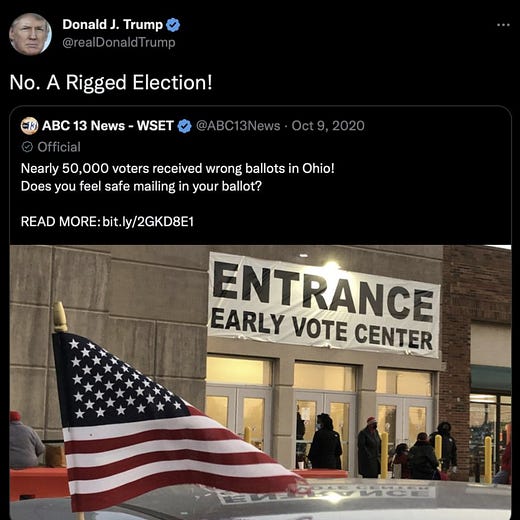
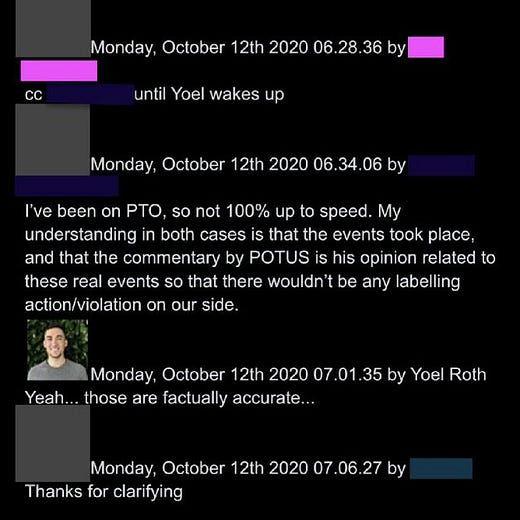
12:18 AM · Dec 10, 2022
3.02K Reposts · 9.87K Likes

Matt Taibbi@mtaibbi
@ShellenbergerMD @bariweiss @JohnBasham @TitaniaMcGrath 36. “VERY WELL DONE ON SPEED” Trump was being “visibility filtered” as late as a week before the election. Here, senior execs didn’t appear to have a particular violation, but still worked fast to make sure a fairly anodyne Trump tweet couldn’t be “replied to, shared, or liked”:
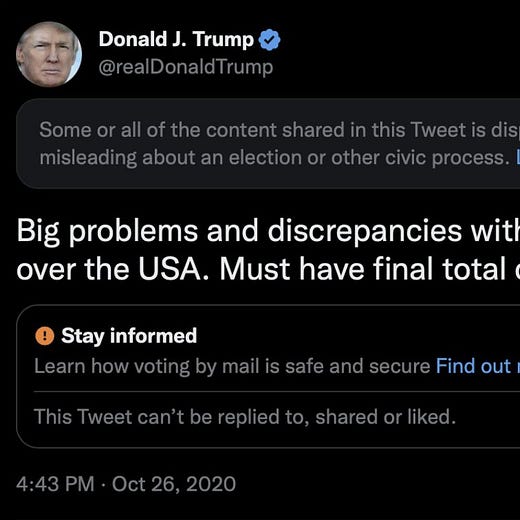
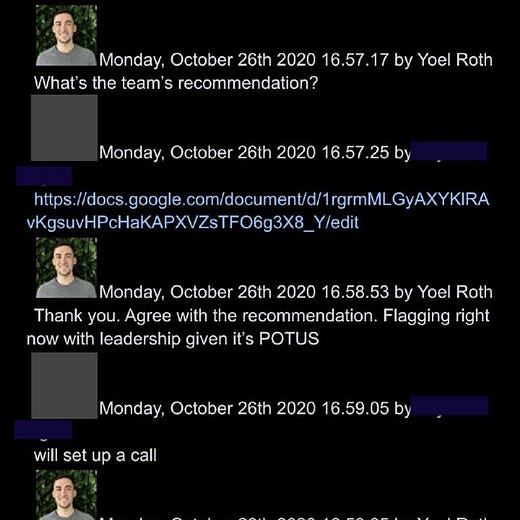
12:20 AM · Dec 10, 2022
3.68K Reposts · 10.2K Likes

Matt Taibbi@mtaibbi
@ShellenbergerMD @bariweiss @JohnBasham @TitaniaMcGrath "VERY WELL DONE ON SPEED": the group is pleased the Trump tweet is dealt with quickly

12:23 AM · Dec 10, 2022
2.22K Reposts · 7.84K Likes

Matt Taibbi@mtaibbi
@ShellenbergerMD @bariweiss @JohnBasham @TitaniaMcGrath 37. A seemingly innocuous follow-up involved a tweet from actor @RealJamesWoods, whose ubiquitous presence in argued-over Twitter data sets is already a #TwitterFiles in-joke.

12:24 AM · Dec 10, 2022
2.87K Reposts · 9.81K Likes

Matt Taibbi@mtaibbi
@ShellenbergerMD @bariweiss @JohnBasham @TitaniaMcGrath @RealJamesWoods 38. After Woods angrily quote-tweeted about Trump’s warning label, Twitter staff – in a preview of what ended up happening after J6 – despaired of a reason for action, but resolved to “hit him hard on future vio.”

12:27 AM · Dec 10, 2022
2.74K Reposts · 8.83K Likes

Matt Taibbi@mtaibbi
@ShellenbergerMD @bariweiss @JohnBasham @TitaniaMcGrath @RealJamesWoods 39. Here a label is applied to Georgia Republican congresswoman Jody Hice for saying, “Say NO to big tech censorship!” and, “Mailed ballots are more prone to fraud than in-person balloting… It’s just common sense.”

12:28 AM · Dec 10, 2022
2.27K Reposts · 8.31K Likes

Matt Taibbi@mtaibbi
@ShellenbergerMD @bariweiss @JohnBasham @TitaniaMcGrath @RealJamesWoods 40. Twitter teams went easy on Hice, only applying “soft intervention,” with Roth worrying about a “wah wah censorship” optics backlash:

12:29 AM · Dec 10, 2022
2.05K Reposts · 7.54K Likes

Matt Taibbi@mtaibbi
@ShellenbergerMD @bariweiss @JohnBasham @TitaniaMcGrath @RealJamesWoods 41. Meanwhile, there are multiple instances of involving pro-Biden tweets warning Trump “may try to steal the election” that got surfaced, only to be approved by senior executives. This one, they decide, just “expresses concern that mailed ballots might not make it on time.”
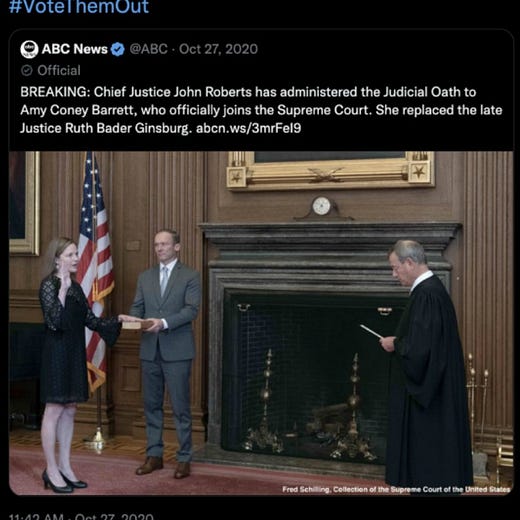
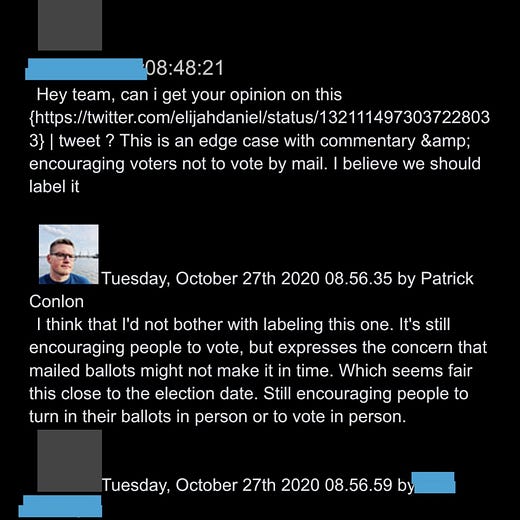
12:32 AM · Dec 10, 2022
2.6K Reposts · 8.32K Likes

Matt Taibbi@mtaibbi
@ShellenbergerMD @bariweiss @JohnBasham @TitaniaMcGrath @RealJamesWoods 42. “THAT’S UNDERSTANDABLE”: Even the hashtag #StealOurVotes – referencing a theory that a combo of Amy Coney Barrett and Trump will steal the election – is approved by Twitter brass, because it’s “understandable” and a “reference to… a US Supreme Court decision.”
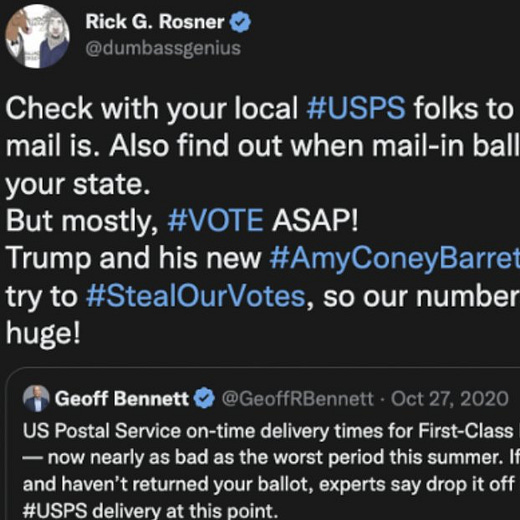
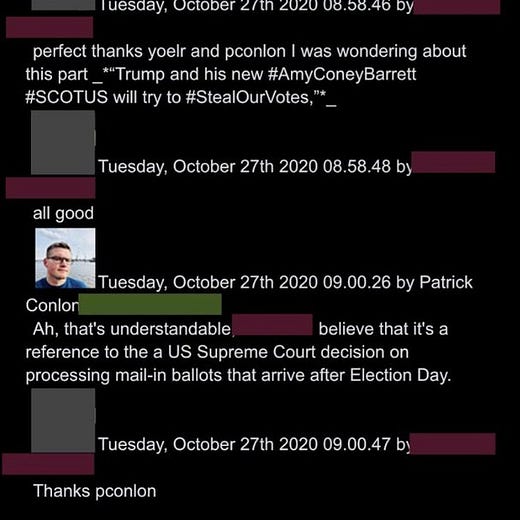
12:36 AM · Dec 10, 2022
2.24K Reposts · 7.62K Likes

Matt Taibbi@mtaibbi
@ShellenbergerMD @bariweiss @JohnBasham @TitaniaMcGrath @RealJamesWoods 43. In this exchange, again unintentionally humorous, former Attorney General Eric Holder claimed the U.S. Postal Service was “deliberately crippled,”ostensibly by the Trump administration. He was initially hit with a generic warning label, but it was quickly taken off by Roth:
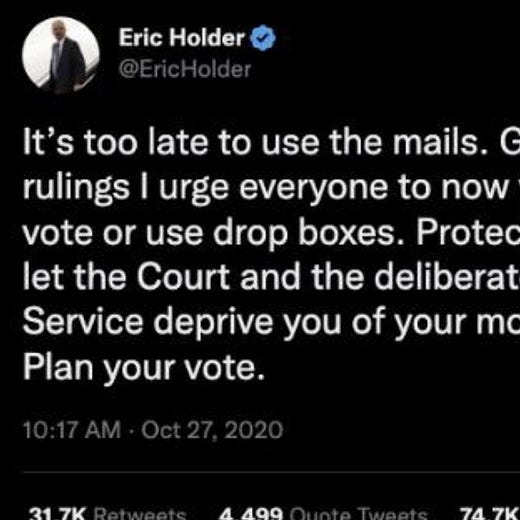

12:39 AM · Dec 10, 2022
2.16K Reposts · 7.31K Likes

Matt Taibbi@mtaibbi
@ShellenbergerMD @bariweiss @JohnBasham @TitaniaMcGrath @RealJamesWoods 44. Later in November 2020, Roth asked if staff had a “debunk moment” on the “SCYTL/Smartmantic vote-counting” stories, which his DHS contacts told him were a combination of “about 47” conspiracy theories:

12:41 AM · Dec 10, 2022
1.78K Reposts · 6.44K Likes

Matt Taibbi@mtaibbi
@ShellenbergerMD @bariweiss @JohnBasham @TitaniaMcGrath @RealJamesWoods 45. On December 10th, as Trump was in the middle of firing off 25 tweets saying things like, “A coup is taking place in front of our eyes,” Twitter executives announced a new “L3 deamplification” tool. This step meant a warning label now could also come with deamplification:

12:43 AM · Dec 10, 2022
2.04K Reposts · 6.62K Likes

Matt Taibbi@mtaibbi
@ShellenbergerMD @bariweiss @JohnBasham @TitaniaMcGrath @RealJamesWoods 46. Some executives wanted to use the new deamplification tool to silently limit Trump’s reach more right away, beginning with the following tweet:

12:44 AM · Dec 10, 2022
2.04K Reposts · 6.77K Likes

Matt Taibbi@mtaibbi
@ShellenbergerMD @bariweiss @JohnBasham @TitaniaMcGrath @RealJamesWoods 47. However, in the end, the team had to use older, less aggressive labeling tools at least for that day, until the “L3 entities” went live the following morning.

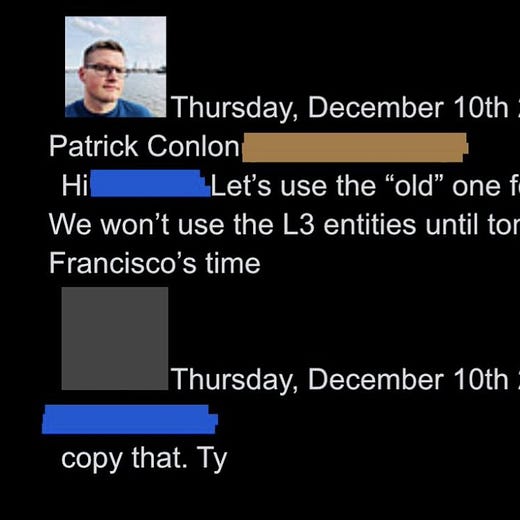
12:46 AM · Dec 10, 2022
1.56K Reposts · 5.95K Likes

Matt Taibbi@mtaibbi
@ShellenbergerMD @bariweiss @JohnBasham @TitaniaMcGrath @RealJamesWoods 48. The significance is that it shows that Twitter, in 2020 at least, was deploying a vast range of visible and invisible tools to rein in Trump’s engagement, long before J6. The ban will come after other avenues are exhausted
12:48 AM · Dec 10, 2022
2.57K Reposts · 8.21K Likes

Matt Taibbi@mtaibbi
@ShellenbergerMD @bariweiss @JohnBasham @TitaniaMcGrath @RealJamesWoods 49. In Twitter docs execs frequently refer to “bots,” e.g. “let’s put a bot on that.” A bot is just any automated heuristic moderation rule. It can be anything: every time a person in Brazil uses “green” and “blob” in the same sentence, action might be taken.

12:51 AM · Dec 10, 2022
1.7K Reposts · 6.05K Likes

Matt Taibbi@mtaibbi
@ShellenbergerMD @bariweiss @JohnBasham @TitaniaMcGrath @RealJamesWoods 50. In this instance, it appears moderators added a bot for a Trump claim made on Breitbart. The bot ends up becoming an automated tool invisibly watching both Trump and, apparently, Breitbart (“will add media ID to bot”). Trump by J6 was quickly covered in bots.


12:54 AM · Dec 10, 2022
1.98K Reposts · 6.01K Likes

Matt Taibbi@mtaibbi
@ShellenbergerMD @bariweiss @JohnBasham @TitaniaMcGrath @RealJamesWoods 51. There is no way to follow the frenzied exchanges among Twitter personnel from between January 6thand 8th without knowing the basics of the company’s vast lexicon of acronyms and Orwellian unwords.
12:55 AM · Dec 10, 2022
1.66K Reposts · 6.38K Likes

Matt Taibbi@mtaibbi
@ShellenbergerMD @bariweiss @JohnBasham @TitaniaMcGrath @RealJamesWoods 52. To “bounce” an account is to put it in timeout, usually for a 12-hour review/cool-off:

12:55 AM · Dec 10, 2022
1.55K Reposts · 5.63K Likes

Matt Taibbi@mtaibbi
@ShellenbergerMD @bariweiss @JohnBasham @TitaniaMcGrath @RealJamesWoods 53. “Interstitial,” one of many nouns used as a verb in Twitterspeak (“denylist” is another), means placing a physical label atop a tweet, so it can’t be seen.
12:58 AM · Dec 10, 2022
1.4K Reposts · 5.29K Likes

Matt Taibbi@mtaibbi
@ShellenbergerMD @bariweiss @JohnBasham @TitaniaMcGrath @RealJamesWoods 54. PII has multiple meanings, one being “Public Interest Interstitial,” i.e. a covering label applied for “public interest” reasons. The post below also references “proactive V,” i.e. proactive visibility filtering.

12:59 AM · Dec 10, 2022
1.28K Reposts · 4.78K Likes

Matt Taibbi@mtaibbi
@ShellenbergerMD @bariweiss @JohnBasham @TitaniaMcGrath @RealJamesWoods 55. This is all necessary background to J6. Before the riots, the company was engaged in an inherently insane/impossible project, trying to create an ever-expanding, ostensibly rational set of rules to regulate every conceivable speech situation that might arise between humans.
1:00 AM · Dec 10, 2022
1.83K Reposts · 6.27K Likes

Matt Taibbi@mtaibbi
@ShellenbergerMD @bariweiss @JohnBasham @TitaniaMcGrath @RealJamesWoods This project was preposterous yet its leaders were unable to see this, having become infected with groupthing, coming to believe – sincerely – that it was Twitter's responsibility to control, as much as possible, what people could talk about, how often, and with whom.
1:00 AM · Dec 10, 2022
2.15K Reposts · 7.08K Likes

Matt Taibbi@mtaibbi
@ShellenbergerMD @bariweiss @JohnBasham @TitaniaMcGrath @RealJamesWoods 57. The firm’s executives on day 1 of the January 6th crisis at least tried to pay lip service to its dizzying array of rules. By day 2, they began wavering. By day 3, a million rules were reduced to one: what we say, goes
1:01 AM · Dec 10, 2022
2.1K Reposts · 6.95K Likes

Matt Taibbi@mtaibbi
@ShellenbergerMD @bariweiss @JohnBasham @TitaniaMcGrath @RealJamesWoods 56. When panic first breaks out on J6 there’s a fair share of WTF-type posts, mixed in with frantic calls for Twitter to start deploying its full arsenal of moderation tools. “What is the right remediation? Do we interstitial the video?” asks one employee, in despair:

1:03 AM · Dec 10, 2022
1.14K Reposts · 3.88K Likes

Matt Taibbi@mtaibbi
@ShellenbergerMD @bariweiss @JohnBasham @TitaniaMcGrath @RealJamesWoods 57. This “Freedom or Death” tweet from #StopTheSteal gadfly Mike Coudrey elicits heated reactions:

1:04 AM · Dec 10, 2022
1.15K Reposts · 4.12K Likes

Matt Taibbi@mtaibbi
@ShellenbergerMD @bariweiss @JohnBasham @TitaniaMcGrath @RealJamesWoods 58. Roth groans about Coudrey: “THIS asshole,” but still seems determined to stick at least superficially to rules, itching to act “if” this “constitutes incitement.”

1:05 AM · Dec 10, 2022
1.18K Reposts · 3.99K Likes

Matt Taibbi@mtaibbi
@ShellenbergerMD @bariweiss @JohnBasham @TitaniaMcGrath @RealJamesWoods 59. At 2:39 p.m. PST, a comms official asked Roth to confirm or deny a story that they’d restricted Trump’s ability to tweet. Roth says, “We have not.”

1:07 AM · Dec 10, 2022
1.27K Reposts · 4.18K Likes

Matt Taibbi@mtaibbi
@ShellenbergerMD @bariweiss @JohnBasham @TitaniaMcGrath @RealJamesWoods 60. Minutes later, Roth executed the historic act of “bouncing” Trump, i.e. putting him in timeout. “I hope you… are appropriately CorpSec’d,” says a colleague.

1:09 AM · Dec 10, 2022
1.4K Reposts · 4.35K Likes

Matt Taibbi@mtaibbi
@ShellenbergerMD @bariweiss @JohnBasham @TitaniaMcGrath @RealJamesWoods This theme of Policy perhaps being stressed by queries from Communications executives – who themselves have to answer the public’s questions – occasionally appears. Two days later, you see chatter about pulling Comms out of the loop:

1:11 AM · Dec 10, 2022
1.1K Reposts · 3.82K Likes

Matt Taibbi@mtaibbi
@ShellenbergerMD @bariweiss @JohnBasham @TitaniaMcGrath @RealJamesWoods 61. The first company-wide email from Gadde on January 6th announced that 3 Trump tweets had been bounced, but more importantly signaled a determination to use legit “violations” as a guide for any possible permanent suspension:

1:13 AM · Dec 10, 2022
1.41K Reposts · 4.3K Likes

Matt Taibbi@mtaibbi
@ShellenbergerMD @bariweiss @JohnBasham @TitaniaMcGrath @RealJamesWoods 62. “WHAT THE ACTUAL FUCK?” Safe to say Trump’s “Go home with love & in peace” tweet mid-riot didn’t go over well at Twitter HQ:
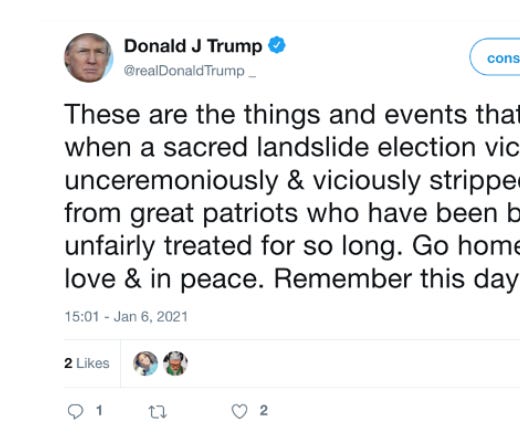

1:15 AM · Dec 10, 2022
2.46K Reposts · 6.04K Likes

Matt Taibbi@mtaibbi
@ShellenbergerMD @bariweiss @JohnBasham @TitaniaMcGrath @RealJamesWoods 63. A few last notes about January 6th. Roth at one point looked and found Trump had a slew of duplicate bot applications:

1:24 AM · Dec 10, 2022
913 Reposts · 2.98K Likes

Matt Taibbi@mtaibbi
@ShellenbergerMD @bariweiss @JohnBasham @TitaniaMcGrath @RealJamesWoods 64. By the end of the first day, the top execs are still trying to apply rules. By the next day, they will contemplate a major change in approach. Watch @ShellenbergerMD this weekend for the play-by-play of how all that went down.
1:26 AM · Dec 10, 2022
929 Reposts · 3.33K Likes

Matt Taibbi@mtaibbi
@ShellenbergerMD @bariweiss @JohnBasham @TitaniaMcGrath @RealJamesWoods 65. By January 8th, which @bariweiss will describe Sunday, Twitter will be receiving plaudits from “our partners” in Washington, and the sitting U.S. president will no longer be heard on the platform.
1:26 AM · Dec 10, 2022
1.2K Reposts · 3.53K Likes

Matt Taibbi@mtaibbi
@ShellenbergerMD @bariweiss @JohnBasham @TitaniaMcGrath @RealJamesWoods 66. Lastly, people on the left, right, and in between want to know what else is in the #TwitterFiles, from suppression/shadow-banning of leftists to lab-leak theorists, or amplification of military propaganda or conservative accounts. We know everyone has questions.
1:28 AM · Dec 10, 2022
866 Reposts · 3.44K Likes

Matt Taibbi@mtaibbi
@ShellenbergerMD @bariweiss @JohnBasham @TitaniaMcGrath @RealJamesWoods 67. And while we’ve stumbled on tidbits here and there about topics ranging from COVID to foreign policy, the reality is the data sets are enormous and we’re still working through them.
More is coming. Good night, all.
1:29 AM · Dec 10, 2022
974 Reposts · 5.27K Likes
Part IV

Michael Shellenberger@ShellenbergerMD
1. TWITTER FILES, PART 4
The Removal of Donald Trump: January 7
As the pressure builds, Twitter executives build the case for a permanent ban
11:28 PM · Dec 10, 2022
346 Reposts · 735 Likes

Michael Shellenberger@ShellenbergerMD
On Jan 7, senior Twitter execs:
- create justifications to ban Trump
- seek a change of policy for Trump alone, distinct from other political leaders
- express no concern for the free speech or democracy implications of a ban
This #TwitterFiles is reported with @lwoodhouse
11:29 PM · Dec 10, 2022
82 Reposts · 249 Likes

Michael Shellenberger@ShellenbergerMD
For those catching up, please see:
Part 1, where @mtaibbi documents how senior Twitter executives violated their own policies to prevent the spread of accurate information about Hunter Biden’s laptop;

Matt Taibbi @mtaibbi
1. Thread: THE TWITTER FILES
11:30 PM · Dec 10, 2022
47 Reposts · 159 Likes

Michael Shellenberger@ShellenbergerMD
Part 2, where @bariweiss shows how senior Twitter execs created secret blacklists to “de-amplify” disfavored Twitter users, not just specific tweets;

Bari Weiss @bariweiss
THREAD: THE TWITTER FILES PART TWO.
TWITTER’S SECRET BLACKLISTS.
11:32 PM · Dec 10, 2022
17 Reposts · 51 Likes

Michael Shellenberger@ShellenbergerMD
And Part 3, where @mtaibbi documents how senior Twitter execs censored tweets by Trump in the run-up to the Nov 2020 election while regularly engaging with representatives of U.S. government law enforcement agencies.

Matt Taibbi @mtaibbi
1. THREAD: The Twitter Files
THE REMOVAL OF DONALD TRUMP
Part One: October 2020-January 6th
11:32 PM · Dec 10, 2022
25 Reposts · 93 Likes

Michael Shellenberger@ShellenbergerMD
For years, Twitter had resisted calls to ban Trump.
“Blocking a world leader from Twitter,” it wrote in 2018, “would hide important info... [and] hamper necessary discussion around their words and actions.”

Twitter Public Policy @Policy
Blocking a world leader from Twitter or removing their controversial Tweets would hide important information people should be able to see and debate. It would also not silence that leader, but it would certainly hamper necessary discussion around their words and actions.
11:35 PM · Dec 10, 2022
46 Reposts · 124 Likes

Michael Shellenberger@ShellenbergerMD
But after the events of Jan 6, the internal and external pressure on Twitter CEO @jack grows.
Former First Lady @MichelleObama , tech journalist @karaswisher , @ADL , high-tech VC @ChrisSacca , and many others, publicly call on Twitter to permanently ban Trump.
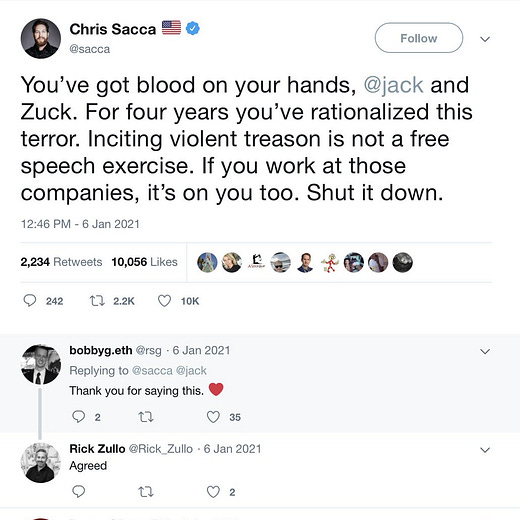
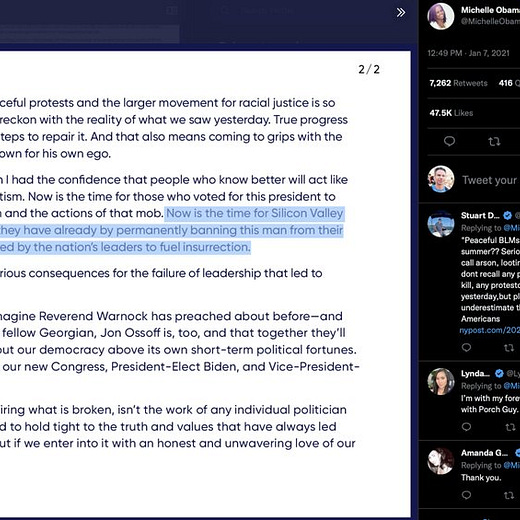
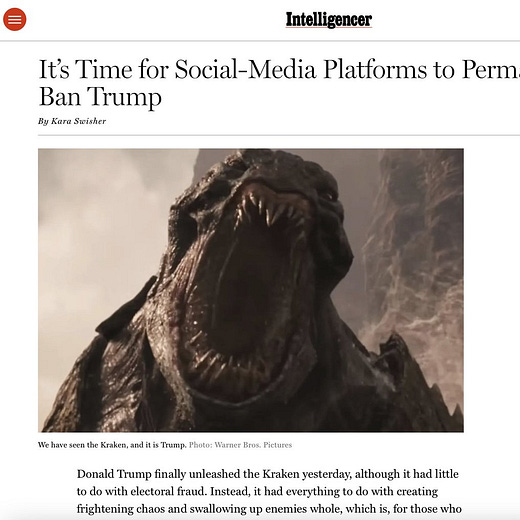
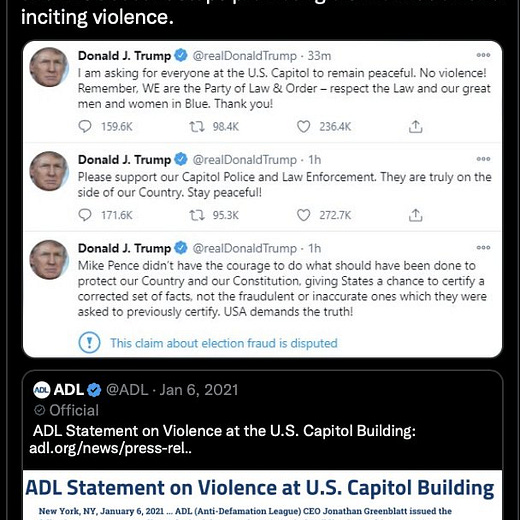
11:44 PM · Dec 10, 2022
20 Reposts · 46 Likes

Michael Shellenberger@ShellenbergerMD
Dorsey was on vacation in French Polynesia the week of January 4-8, 2021. He phoned into meetings but also delegated much of the handling of the situation to senior execs @yoyoel , Twitter’s Global Head of Trust and Safety, and @vijaya Head of Legal, Policy, & Trust.
11:48 PM · Dec 10, 2022
14 Reposts · 32 Likes

Michael Shellenberger@ShellenbergerMD
As context, it's important to understand that Twitter’s staff & senior execs were overwhelmingly progressive.
In 2018, 2020, and 2022, 96%, 98%, & 99% of Twitter staff's political donations went to Democrats.

Matt Taibbi @mtaibbi
11. This system wasn't balanced. It was based on contacts. Because Twitter was and is overwhelmingly staffed by people of one political orientation, there were more channels, more ways to complain, open to the left (well, Democrats) than the right. https://t.co/sa1uVRNhuH https://t.co/K1xmqQ0TrD
11:52 PM · Dec 10, 2022
295 Reposts · 795 Likes

Michael Shellenberger@ShellenbergerMD
In 2017, Roth tweeted that there were “ACTUAL NAZIS IN THE WHITE HOUSE.”
In April 2022, Roth told a colleague that his goal “is to drive change in the world,” which is why he decided not to become an academic.
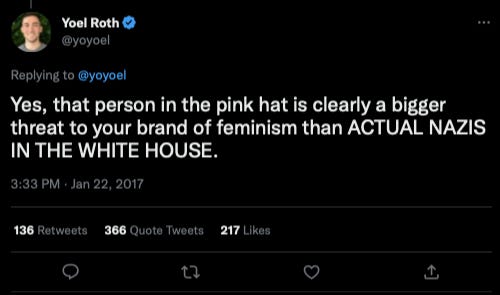
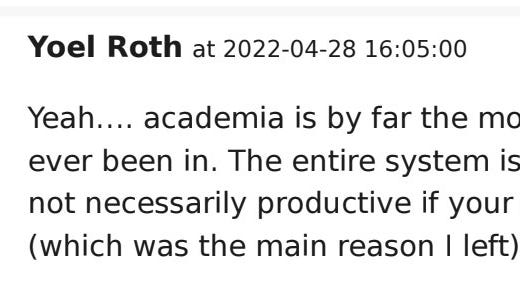
11:54 PM · Dec 10, 2022
171 Reposts · 412 Likes

Michael Shellenberger@ShellenbergerMD
On January 7, @jack emails employees saying Twitter needs to remain consistent in its policies, including the right of users to return to Twitter after a temporary suspension
After, Roth reassures an employee that "people who care about this... aren't happy with where we are"

11:59 PM · Dec 10, 2022
41 Reposts · 82 Likes

Michael Shellenberger@ShellenbergerMD
Around 11:30 am PT, Roth DMs his colleagues with news that he is excited to share.
“GUESS WHAT,” he writes. “Jack just approved repeat offender for civic integrity.”
The new approach would create a system where five violations ("strikes") would result in permanent suspension.

12:09 AM · Dec 11, 2022
260 Reposts · 743 Likes

Michael Shellenberger@ShellenbergerMD
“Progress!” exclaims a member of Roth’s Trust and Safety Team.
The exchange between Roth and his colleagues makes clear that they had been pushing @jack for greater restrictions on the speech Twitter allows around elections.
12:12 AM · Dec 11, 2022
210 Reposts · 686 Likes

Michael Shellenberger@ShellenbergerMD
The colleague wants to know if the decision means Trump can finally be banned. The person asks, "does the incitement to violence aspect change that calculus?”
Roth says it doesn't. "Trump continues to just have his one strike" (remaining).

12:17 AM · Dec 11, 2022
77 Reposts · 147 Likes

Michael Shellenberger@ShellenbergerMD
Roth's colleague's query about "incitement to violence" heavily foreshadows what will happen the following day.
On January 8, Twitter announces a permanent ban on Trump due to the "risk of further incitement of violence."

12:24 AM · Dec 11, 2022
38 Reposts · 72 Likes

Michael Shellenberger@ShellenbergerMD
On J8, Twitter says its ban is based on "specifically how [Trump's tweets] are being received & interpreted."
But in 2019, Twitter said it did "not attempt to determine all potential interpretations of the content or its intent.”
https://t.co/2jW1s5pH4W
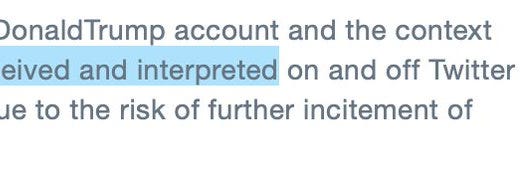

12:31 AM · Dec 11, 2022
76 Reposts · 186 Likes

Michael Shellenberger@ShellenbergerMD
The *only* serious concern we found expressed within Twitter over the implications for free speech and democracy of banning Trump came from a junior person in the organization. It was tucked away in a lower-level Slack channel known as “site-integrity-auto."

12:38 AM · Dec 11, 2022
260 Reposts · 743 Likes

Michael Shellenberger@ShellenbergerMD
"This might be an unpopular opinion but one off ad hoc decisions like this that don’t appear rooted in policy are imho a slippery slope... This now appears to be a fiat by an online platform CEO with a global presence that can gatekeep speech for the entire world..."

12:40 AM · Dec 11, 2022
327 Reposts · 1.17K Likes

Michael Shellenberger@ShellenbergerMD
Twitter employees use the term "one off" frequently in their Slack discussions. Its frequent use reveals significant employee discretion over when and whether to apply warning labels on tweets and "strikes" on users. Here are typical examples.
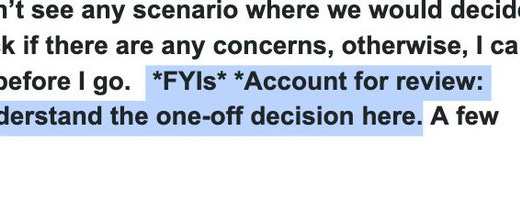
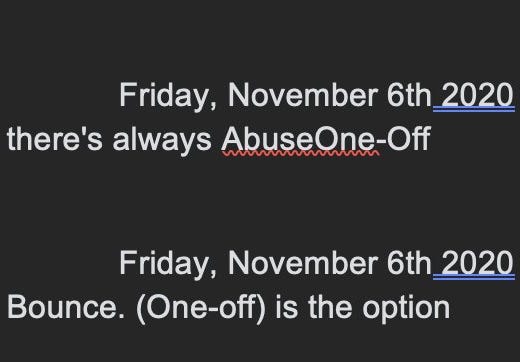
12:45 AM · Dec 11, 2022
128 Reposts · 376 Likes

Michael Shellenberger@ShellenbergerMD
Recall from #TwitterFiles2 by @bariweiss that, according to Twitter staff, "We control visibility quite a bit. And we control the amplification of your content quite a bit. And normal people do not know how much we do."

Bari Weiss @bariweiss
11. “We control visibility quite a bit. And we control the amplification of your content quite a bit. And normal people do not know how much we do,” one Twitter engineer told us. Two additional Twitter employees confirmed.
1:08 AM · Dec 11, 2022
77 Reposts · 214 Likes

Michael Shellenberger@ShellenbergerMD
Twitter employees recognize the difference between their own politics & Twitter's Terms of Service (TOS), but they also engage in complex interpretations of content in order to stamp out prohibited tweets, as a series of exchanges over the "#stopthesteal" hashtag reveal.
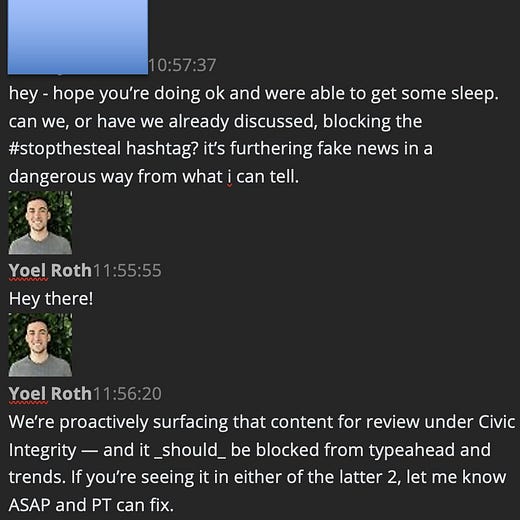
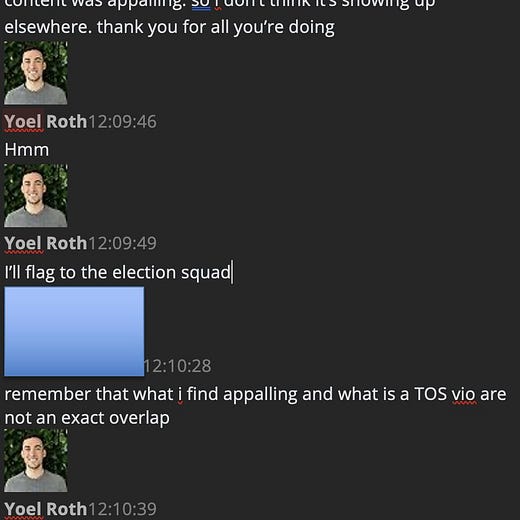
1:10 AM · Dec 11, 2022
118 Reposts · 269 Likes

Michael Shellenberger@ShellenbergerMD
Roth immediately DMs a colleague to ask that they add "stopthesteal" & [QAnon conspiracy term] "kraken" to a blacklist of terms to be deamplified.
Roth's colleague objects that blacklisting "stopthesteal" risks "deamplifying counterspeech" that validates the election.

1:23 AM · Dec 11, 2022
137 Reposts · 380 Likes

Michael Shellenberger@ShellenbergerMD
Indeed, notes Roth's colleague, "a quick search of top stop the steal tweets and they’re counterspeech"
But they quickly come up with a solution: "deamplify accounts with stopthesteal in the name/profile" since "those are not affiliated with counterspeech"

1:35 AM · Dec 11, 2022
28 Reposts · 71 Likes

Michael Shellenberger@ShellenbergerMD
But it turns out that even blacklisting "kraken" is less straightforward than they thought. That's because kraken, in addition to being a QAnon conspiracy theory based on the mythical Norwegian sea monster, is also the name of a cryptocurrency exchange, and was thus "allowlisted"

1:44 AM · Dec 11, 2022
104 Reposts · 327 Likes

Michael Shellenberger@ShellenbergerMD
Employees struggle with whether to punish users who share screenshots of Trump's deleted J6 tweets
"we should bounce these tweets with a strike given the screen shot violates the policy"
"they are criticising Trump, so I am bit hesitant with applying strike to this user"

2:04 AM · Dec 11, 2022
101 Reposts · 323 Likes

Michael Shellenberger@ShellenbergerMD
What if a user dislikes Trump *and* objects to Twitter's censorship? The tweet still gets deleted. But since the *intention* is not to deny the election result, no punishing strike is applied.
"if there are instances where the intent is unclear please feel free to raise"

2:16 AM · Dec 11, 2022
418 Reposts · 1.47K Likes

Michael Shellenberger@ShellenbergerMD
Around noon, a confused senior executive in advertising sales sends a DM to Roth.
Sales exec: "jack says: 'we will permanently suspend [Trump] if our policies are violated after a 12 hour account lock'… what policies is jack talking about?"
Roth: "*ANY* policy violation"

2:26 AM · Dec 11, 2022
141 Reposts · 368 Likes

Michael Shellenberger@ShellenbergerMD
What happens next is essential to understanding how Twitter justified banning Trump.
Sales exec: "are we dropping the public interest [policy] now..."
Roth, six hours later: "In this specific case, we're changing our public interest approach for his account..."

2:32 AM · Dec 11, 2022
345 Reposts · 1.04K Likes

Michael Shellenberger@ShellenbergerMD
The ad exec is referring to Twitter’s policy of “Public-interest exceptions," which allows the content of elected officials, even if it violates Twitter rules, “if it directly contributes to understanding or discussion of a matter of public concern”
https://t.co/xTs14fD8V9

2:40 AM · Dec 11, 2022
47 Reposts · 112 Likes

Michael Shellenberger@ShellenbergerMD
Roth pushes for a permanent suspension of Rep. Matt Gaetz even though it “doesn’t quite fit anywhere (duh)”
It's a kind of test case for the rationale for banning Trump.
“I’m trying to talk [Twitter’s] safety [team] into... removal as a conspiracy that incites violence.”

2:52 AM · Dec 11, 2022
366 Reposts · 1.09K Likes

Michael Shellenberger@ShellenbergerMD
Around 2:30, comms execs DM Roth to say they don't want to make a big deal of the QAnon ban to the media because they fear "if we push this it looks we’re trying to offer up something in place of the thing everyone wants," meaning a Trump ban.

2:58 AM · Dec 11, 2022
56 Reposts · 159 Likes

Michael Shellenberger@ShellenbergerMD
That evening, a Twitter engineer DMs to Roth to say, "I feel a lot of debates around exceptions stem from the fact that Trump’s account is not technically different from anybody else’ and yet treated differently due to his personal status, without corresponding _Twitter rules_.."

3:00 AM · Dec 11, 2022
138 Reposts · 371 Likes

Michael Shellenberger@ShellenbergerMD
Roth's response hints at how Twitter would justify deviating from its longstanding policy. "To put a different spin on it: policy is one part of the system of how Twitter works... we ran into the world changing faster than we were able to either adapt the product or the policy."

3:04 AM · Dec 11, 2022
145 Reposts · 430 Likes

Michael Shellenberger@ShellenbergerMD
The evening of January 7, the same junior employee who expressed an "unpopular opinion" about "ad hoc decisions... that don’t appear rooted in policy," speaks up one last time before the end of the day.

Michael Shellenberger @ShellenbergerMD
"This might be an unpopular opinion but one off ad hoc decisions like this that don’t appear rooted in policy are imho a slippery slope... This now appears to be a fiat by an online platform CEO with a global presence that can gatekeep speech for the entire world..." https://t.co/4pedmgY8pa
3:07 AM · Dec 11, 2022
73 Reposts · 234 Likes

Michael Shellenberger@ShellenbergerMD
Earlier that day, the employee wrote, "My concern is specifically surrounding the unarticulated logic of the decision by FB. That space fills with the idea (conspiracy theory?) that all... internet moguls... sit around like kings casually deciding what people can and cannot see."

3:12 AM · Dec 11, 2022
133 Reposts · 433 Likes

Michael Shellenberger@ShellenbergerMD
The employee notes, later in the day, "And Will Oremus noticed the inconsistency too...," linking to an article for OneZero at Medium called, "Facebook Chucked Its Own Rulebook to Ban Trump."
onezero.medium.com
Facebook Chucked Its Own Rulebook to Ban Trump

3:14 AM · Dec 11, 2022
81 Reposts · 190 Likes

Michael Shellenberger@ShellenbergerMD
"The underlying problem," writes @WillOremus , is that “the dominant platforms have always been loath to own up to their subjectivity, because it highlights the extraordinary, unfettered power they wield over the global public square...
3:15 AM · Dec 11, 2022
202 Reposts · 725 Likes

Michael Shellenberger@ShellenbergerMD
"... and places the responsibility for that power on their own shoulders… So they hide behind an ever-changing rulebook, alternately pointing to it when it’s convenient and shoving it under the nearest rug when it isn’t.”
onezero.medium.com
Facebook Chucked Its Own Rulebook to Ban Trump

3:16 AM · Dec 11, 2022
203 Reposts · 667 Likes

Michael Shellenberger@ShellenbergerMD
“Facebook’s suspension of Trump now puts Twitter in an awkward position. If Trump does indeed return to Twitter, the pressure on Twitter will ramp up to find a pretext on which to ban him as well.”
Indeed. And as @bariweiss will show tomorrow, that’s exactly what happened.
/END
3:17 AM · Dec 11, 2022
202 Reposts · 737 Likes
Part V

Bari Weiss@bariweiss
THREAD: THE TWITTER FILES PART FIVE.
THE REMOVAL OF TRUMP FROM TWITTER.
6:06 PM · Dec 12, 2022
3.96K Reposts · 8.94K Likes

Bari Weiss@bariweiss
1. On the morning of January 8, President Donald Trump, with one remaining strike before being at risk of permanent suspension from Twitter, tweets twice.
6:06 PM · Dec 12, 2022
674 Reposts · 3.14K Likes

Bari Weiss@bariweiss
2. 6:46 am: “The 75,000,000 great American Patriots who voted for me, AMERICA FIRST, and MAKE AMERICA GREAT AGAIN, will have a GIANT VOICE long into the future. They will not be disrespected or treated unfairly in any way, shape or form!!!”

6:08 PM · Dec 12, 2022
700 Reposts · 3.44K Likes

Bari Weiss@bariweiss
3. 7:44 am: “To all of those who have asked, I will not be going to the Inauguration on January 20th.”

6:08 PM · Dec 12, 2022
501 Reposts · 2.8K Likes

Bari Weiss@bariweiss
4. For years, Twitter had resisted calls both internal and external to ban Trump on the grounds that blocking a world leader from the platform or removing their controversial tweets would hide important information that people should be able to see and debate.
6:09 PM · Dec 12, 2022
507 Reposts · 2.79K Likes

Bari Weiss@bariweiss
5. “Our mission is to provide a forum that enables people to be informed and to engage their leaders directly,” the company wrote in 2019. Twitter’s aim was to “protect the public’s right to hear from their leaders and to hold them to account.”
https://t.co/rtQjkQQxSs
6:09 PM · Dec 12, 2022
505 Reposts · 2.61K Likes

Bari Weiss@bariweiss
6. But after January 6, as @mtaibbi and @ShellenbergerMD have documented, pressure grew, both inside and outside of Twitter, to ban Trump.
6:10 PM · Dec 12, 2022
539 Reposts · 2.79K Likes

Bari Weiss@bariweiss
7. There were dissenters inside Twitter.
“Maybe because I am from China,” said one employee on January 7, “I deeply understand how censorship can destroy the public conversation.”

6:11 PM · Dec 12, 2022
962 Reposts · 3.64K Likes

Bari Weiss@bariweiss
8. But voices like that one appear to have been a distinct minority within the company. Across Slack channels, many Twitter employees were upset that Trump hadn’t been banned earlier.
6:12 PM · Dec 12, 2022
551 Reposts · 2.9K Likes

Bari Weiss@bariweiss
9. After January 6, Twitter employees organized to demand their employer ban Trump. “There is a lot of employee advocacy happening,” said one Twitter employee.

6:13 PM · Dec 12, 2022
649 Reposts · 2.6K Likes

Bari Weiss@bariweiss
10. “We have to do the right thing and ban this account,” said one staffer.
It’s “pretty obvious he’s going to try to thread the needle of incitement without violating the rules,” said another.

6:15 PM · Dec 12, 2022
517 Reposts · 2.33K Likes

Bari Weiss@bariweiss
11. In the early afternoon of January 8, The Washington Post published an open letter signed by over 300 Twitter employees to CEO Jack Dorsey demanding Trump’s ban. “We must examine Twitter’s complicity in what President-Elect Biden has rightly termed insurrection.”
6:16 PM · Dec 12, 2022
514 Reposts · 2.31K Likes

Bari Weiss@bariweiss
12. But the Twitter staff assigned to evaluate tweets quickly concluded that Trump had *not* violated Twitter’s policies.“I think we’d have a hard time saying this is incitement,” wrote one staffer.
6:17 PM · Dec 12, 2022
700 Reposts · 2.86K Likes

Bari Weiss@bariweiss
13. “It's pretty clear he's saying the ‘American Patriots’ are the ones who voted for him and not the terrorists (we can call them that, right?) from Wednesday.”
6:17 PM · Dec 12, 2022
503 Reposts · 2.47K Likes

Bari Weiss@bariweiss
14. Another staffer agreed: “Don’t see the incitement angle here.”

6:18 PM · Dec 12, 2022
644 Reposts · 2.66K Likes

Bari Weiss@bariweiss
15. “I also am not seeing clear or coded incitement in the DJT tweet,” wrote Anika Navaroli, a Twitter policy official. “I’ll respond in the elections channel and say that our team has assessed and found no vios”—or violations—“for the DJT one.”

6:19 PM · Dec 12, 2022
580 Reposts · 2.38K Likes

Bari Weiss@bariweiss
16. She does just that: “as an fyi, Safety has assessed the DJT Tweet above and determined that there is no violation of our policies at this time.”

6:23 PM · Dec 12, 2022
442 Reposts · 1.84K Likes

Bari Weiss@bariweiss
17. (Later, Navaroli would testify to the House Jan. 6 committee:“For months I had been begging and anticipating and attempting to raise the reality that if nothing—if we made no intervention into what I saw occuring, people were going to die.”)
6:23 PM · Dec 12, 2022
434 Reposts · 1.85K Likes

Bari Weiss@bariweiss
18. Next, Twitter’s safety team decides that Trump’s 7:44 am ET tweet is also not in violation. They are unequivocal: “it’s a clear no vio. It’s just to say he’s not attending the inauguration”

6:23 PM · Dec 12, 2022
504 Reposts · 2.07K Likes

Bari Weiss@bariweiss
19. To understand Twitter’s decision to ban Trump, we must consider how Twitter deals with other heads of state and political leaders, including in Iran, Nigeria, and Ethiopia.
6:24 PM · Dec 12, 2022
542 Reposts · 2.35K Likes

Bari Weiss@bariweiss
20. In June 2018, Iran’s Ayatollah Ali Khamenei tweeted, “#Israel is a malignant cancerous tumor in the West Asian region that has to be removed and eradicated: it is possible and it will happen.”
Twitter neither deleted the tweet nor banned the Ayatollah.

6:31 PM · Dec 12, 2022
470 Reposts · 1.27K Likes

Bari Weiss@bariweiss
21. In October 2020, the former Malaysian Prime Minister said it was “a right” for Muslims to “kill millions of French people.”
Twitter deleted his tweet for “glorifying violence,” but he remains on the platform. The tweet below was taken from the Wayback Machine:

6:32 PM · Dec 12, 2022
270 Reposts · 759 Likes

Bari Weiss@bariweiss
22. Muhammadu Buhari, the President of Nigeria, incited violence against pro-Biafra groups.“Those of us in the fields for 30 months, who went through the war,” he wrote, “will treat them in the language they understand.”
Twitter deleted the tweet but didn't ban Buhari.
6:35 PM · Dec 12, 2022
272 Reposts · 1.01K Likes

Bari Weiss@bariweiss
23. In October 2021, Twitter allowed Ethiopian Prime Minister Abiy Ahmed to call on citizens to take up arms against the Tigray region.
Twitter allowed the tweet to remain up, and did not ban the prime minister.

6:36 PM · Dec 12, 2022
202 Reposts · 602 Likes

Bari Weiss@bariweiss
24. In early February 2021, Prime Minister Narendra Modi’s government threatened to arrest Twitter employees in India, and to incarcerate them for up to seven years after they restored hundreds of accounts that had been critical of him.
Twitter did not ban Modi.

6:37 PM · Dec 12, 2022
38 Reposts · 112 Likes

Bari Weiss@bariweiss
25. But Twitter executives did ban Trump, even though key staffers said that Trump had not incited violence—not even in a “coded” way.
6:40 PM · Dec 12, 2022
115 Reposts · 354 Likes

Bari Weiss@bariweiss
26. Less than 90 minutes after Twitter employees had determined that Trump’s tweets were not in violation of Twitter policy, Vijaya Gadde—Twitter’s Head of Legal, Policy, and Trust—asked whether it could, in fact, be “coded incitement to further violence.”

6:40 PM · Dec 12, 2022
86 Reposts · 164 Likes

Bari Weiss@bariweiss
27. A few minutes later, Twitter employees on the “scaled enforcement team” suggest that Trump’s tweet may have violated Twitter’s Glorification of Violence policy—if you interpreted the phrase “American Patriots” to refer to the rioters.

6:41 PM · Dec 12, 2022
88 Reposts · 242 Likes

Bari Weiss@bariweiss
28. Things escalate from there.
Members of that team came to “view him as the leader of a terrorist group responsible for violence/deaths comparable to Christchurch shooter or Hitler and on that basis and on the totality of his Tweets, he should be de-platformed.”

6:41 PM · Dec 12, 2022
26 Reposts · 48 Likes

Bari Weiss@bariweiss
29. Two hours later, Twitter executives host a 30-minute all-staff meeting.
Jack Dorsey and Vijaya Gadde answer staff questions as to why Trump wasn’t banned yet.
But they make some employees angrier.
6:43 PM · Dec 12, 2022
145 Reposts · 461 Likes

Bari Weiss@bariweiss
30. “Multiple tweeps [Twitter employees] have quoted the Banality of Evil suggesting that people implementing our policies are like Nazis following orders,” relays Yoel Roth to a colleague.

6:44 PM · Dec 12, 2022
57 Reposts · 139 Likes

Bari Weiss@bariweiss
31. Dorsey requested simpler language to explain Trump’s suspension.
Roth wrote, “god help us [this] makes me think he wants to share it publicly”

6:45 PM · Dec 12, 2022
21 Reposts · 44 Likes

Bari Weiss@bariweiss
32. One hour later, Twitter announces Trump’s permanent suspension “due to the risk of further incitement of violence.”
6:46 PM · Dec 12, 2022
49 Reposts · 138 Likes

Bari Weiss@bariweiss
33. Many at Twitter were ecstatic.
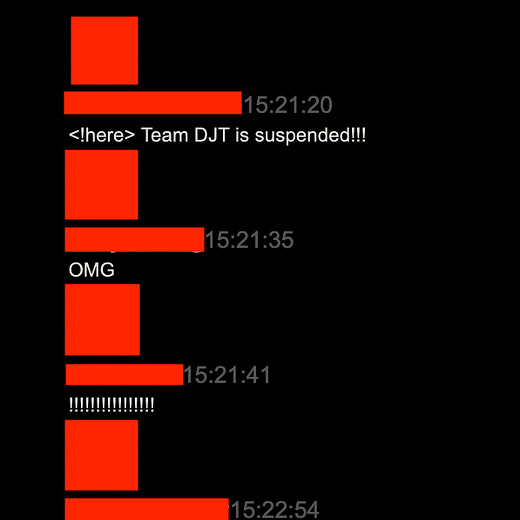
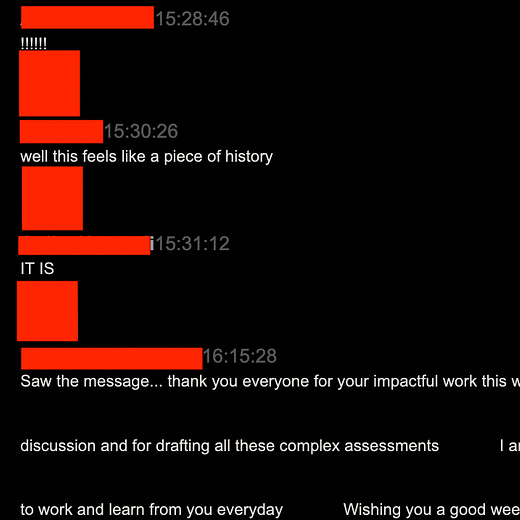
6:49 PM · Dec 12, 2022
148 Reposts · 434 Likes

Bari Weiss@bariweiss
34. And congratulatory: “big props to whoever in trust and safety is sitting there whack-a-mole-ing these trump accounts”

6:50 PM · Dec 12, 2022
102 Reposts · 349 Likes

Bari Weiss@bariweiss
35. By the next day, employees expressed eagerness to tackle “medical misinformation” as soon as possible:

6:51 PM · Dec 12, 2022
38 Reposts · 125 Likes

Bari Weiss@bariweiss
36. “For the longest time, Twitter’s stance was that we aren’t the arbiter of truth,” wrote another employee, “which I respected but never gave me a warm fuzzy feeling.”

6:52 PM · Dec 12, 2022
29 Reposts · 75 Likes

Bari Weiss@bariweiss
37. But Twitter’s COO Parag Agrawal—who would later succeed Dorsey as CEO—told Head of Security Mudge Zatko: “I think a few of us should brainstorm the ripple effects” of Trump's ban. Agrawal added: “centralized content moderation IMO has reached a breaking point now.”
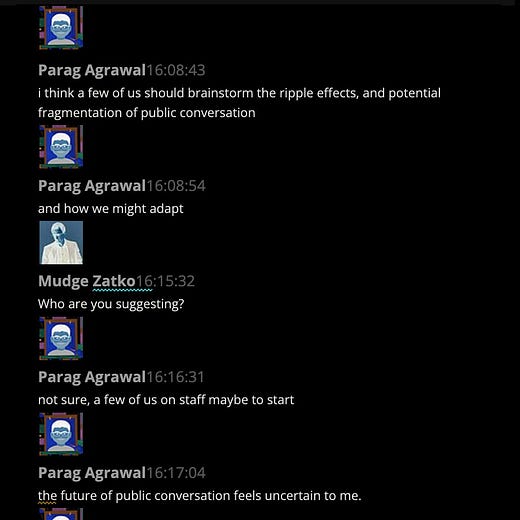
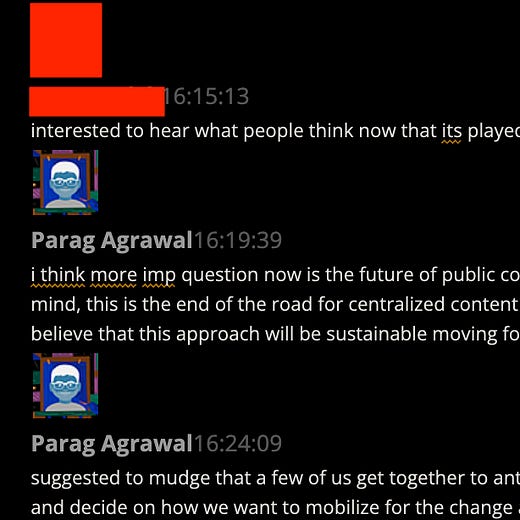
6:53 PM · Dec 12, 2022
44 Reposts · 123 Likes

Bari Weiss@bariweiss
38. Outside the United States, Twitter’s decision to ban Trump raised alarms, including with French President Emmanuel Macron, German Prime Minister Angela Merkel, and Mexico's President Andres Manuel Lopez Obrador.
6:54 PM · Dec 12, 2022
450 Reposts · 1.67K Likes

Bari Weiss@bariweiss
39. Macron told an audience he didn’t “want to live in a democracy where the key decisions” were made by private players. “I want it to be decided by a law voted by your representative, or by regulation, governance, democratically discussed and approved by democratic leaders.”
6:54 PM · Dec 12, 2022
443 Reposts · 1.87K Likes

Bari Weiss@bariweiss
40. Merkel’s spokesperson called Twitter’s decision to ban Trump from its platform “problematic” and added that the freedom of opinion is of “elementary significance.”
Russian opposition leader Alexey Navalny criticized the ban as “an unacceptable act of censorship.”
6:56 PM · Dec 12, 2022
447 Reposts · 1.82K Likes

Bari Weiss@bariweiss
41. Whether you agree with Navalny and Macron or the executives at Twitter, we hope this latest installment of #TheTwitterFiles gave you insight into that unprecedented decision.
7:08 PM · Dec 12, 2022
54 Reposts · 312 Likes

Bari Weiss@bariweiss
42. From the outset, our goal in investigating this story was to discover and document the steps leading up to the banning of Trump and to put that choice into context.
7:08 PM · Dec 12, 2022
50 Reposts · 293 Likes

Bari Weiss@bariweiss
43. Ultimately, the concerns about Twitter’s efforts to censor news about Hunter Biden’s laptop, blacklist disfavored views, and ban a president aren’t about the past choices of executives in a social media company.
7:08 PM · Dec 12, 2022
60 Reposts · 267 Likes

Bari Weiss@bariweiss
44. They’re about the power of a handful of people at a private company to influence the public discourse and democracy.
7:08 PM · Dec 12, 2022
79 Reposts · 387 Likes

Bari Weiss@bariweiss
45. This was reported by @ShellenbergerMD, @IsaacGrafstein, @SnoozyWeiss, @Olivia_Reingold, @petersavodnik, @NellieBowles. Follow all of our work at The Free Press: @TheFP
7:08 PM · Dec 12, 2022
57 Reposts · 438 Likes
Part VI

Matt Taibbi@mtaibbi
1. THREAD: The Twitter Files, Part Six
TWITTER, THE FBI SUBSIDIARY
9:00 PM · Dec 16, 2022
2.4K Reposts · 4.73K Likes

Matt Taibbi@mtaibbi
2. The #TwitterFiles are revealing more every day about how the government collects, analyzes, and flags your social media content.
9:00 PM · Dec 16, 2022
402 Reposts · 2.06K Likes

Matt Taibbi@mtaibbi
3. Twitter’s contact with the FBI was constant and pervasive, as if it were a subsidiary.
9:00 PM · Dec 16, 2022
537 Reposts · 2.21K Likes

Matt Taibbi@mtaibbi
4. Between January 2020 and November 2022, there were over 150 emails between the FBI and former Twitter Trust and Safety chief Yoel Roth.
9:00 PM · Dec 16, 2022
618 Reposts · 2.24K Likes

Matt Taibbi@mtaibbi
5. Some are mundane, like San Francisco agent Elvis Chan wishing Roth a Happy New Year along with a reminder to attend “our quarterly call next week.” Others are requests for information into Twitter users related to active investigations.
9:00 PM · Dec 16, 2022
353 Reposts · 1.86K Likes

Matt Taibbi@mtaibbi
6. But a surprisingly high number are requests by the FBI for Twitter to take action on election misinformation, even involving joke tweets from low-follower accounts.
9:00 PM · Dec 16, 2022
570 Reposts · 2.23K Likes

Matt Taibbi@mtaibbi
7. The FBI’s social media-focused task force, known as FTIF, created in the wake of the 2016 election, swelled to 80 agents and corresponded with Twitter to identify alleged foreign influence and election tampering of all kinds.
9:00 PM · Dec 16, 2022
476 Reposts · 1.94K Likes

Matt Taibbi@mtaibbi
8. Federal intelligence and law enforcement reach into Twitter included the Department of Homeland Security, which partnered with security contractors and think tanks to pressure Twitter to moderate content.
9:00 PM · Dec 16, 2022
435 Reposts · 1.88K Likes

Matt Taibbi@mtaibbi
9. It’s no secret the government analyzes bulk data for all sorts of purposes, everything from tracking terror suspects to making economic forecasts.
9:00 PM · Dec 16, 2022
299 Reposts · 1.65K Likes

Matt Taibbi@mtaibbi
10. The #TwitterFiles show something new: agencies like the FBI and DHS regularly sending social media content to Twitter through multiple entry points, pre-flagged for moderation.
9:00 PM · Dec 16, 2022
520 Reposts · 1.97K Likes

Matt Taibbi@mtaibbi
11. What stands out is the sheer quantity of reports from the government. Some are aggregated from public hotlines:

9:00 PM · Dec 16, 2022
354 Reposts · 1.59K Likes

Matt Taibbi@mtaibbi
12.An unanswered question: do agencies like FBI and DHS do in-house flagging work themselves, or farm it out? “You have to prove to me that inside the fucking government you can do any kind of massive data or AI search,” says one former intelligence officer.
9:00 PM · Dec 16, 2022
343 Reposts · 1.68K Likes

Matt Taibbi@mtaibbi
“HELLO TWITTER CONTACTS”: The master-canine quality of the FBI’s relationship to Twitter comes through in this November 2022 email, in which “FBI San Francisco is notifying you” it wants action on four accounts:

9:00 PM · Dec 16, 2022
510 Reposts · 1.81K Likes

Matt Taibbi@mtaibbi
14.Twitter personnel in that case went on to look for reasons to suspend all four accounts, including @fromMA, whose tweets are almost all jokes (see sample below), including his “civic misinformation” of Nov. 8:
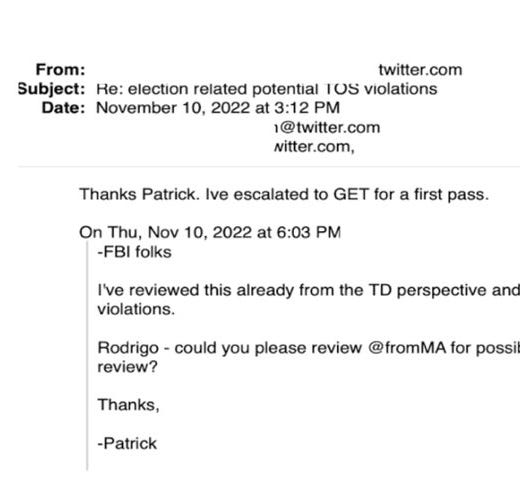
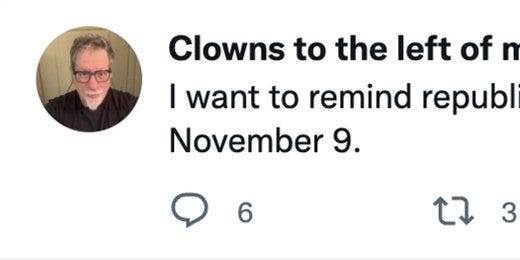

9:00 PM · Dec 16, 2022
319 Reposts · 1.33K Likes

Matt Taibbi@mtaibbi
15. Just to show the FBI can be hyper-intrusive in both directions, they also asked Twitter to review a blue-leaning account for a different joke, except here it was even more obvious that @ClaireFosterPHD, who kids a lot, was kidding:
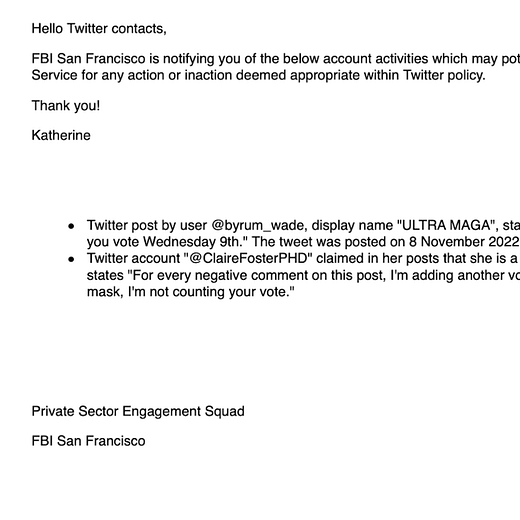
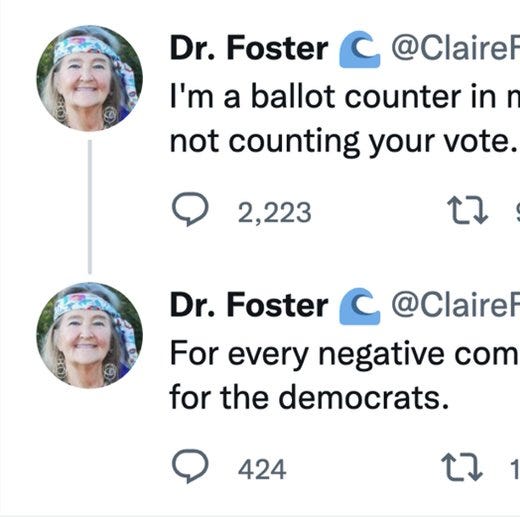
9:00 PM · Dec 16, 2022
282 Reposts · 1.24K Likes

Matt Taibbi@mtaibbi
16. “Anyone who cannot discern obvious satire from reality has no place making decisions for others or working for the feds,” said @ClaireFosterPHD, when told about the flagging.
9:00 PM · Dec 16, 2022
290 Reposts · 1.42K Likes

Matt Taibbi@mtaibbi
17.Of the six accounts mentioned in the previous two emails, all but two – @ClaireFosterPHD and @fromMA – were suspended.
9:00 PM · Dec 16, 2022
240 Reposts · 1.13K Likes

Matt Taibbi@mtaibbi
18.In an internal email from November 5, 2022, the FBI’s National Election Command Post, which compiles and sends on complaints, sent the SF field office a long list of accounts that “may warrant additional action”:

9:00 PM · Dec 16, 2022
357 Reposts · 1.23K Likes

Matt Taibbi@mtaibbi
19.Agent Chan passed the list on to his "Twitter folks":

9:00 PM · Dec 16, 2022
282 Reposts · 1.13K Likes

Matt Taibbi@mtaibbi
20. Twitter then replied with its list of actions taken. Note mercy shown to actor Billy Baldwin:

9:00 PM · Dec 16, 2022
322 Reposts · 1.19K Likes

Matt Taibbi@mtaibbi
21.Many of the above accounts were satirical in nature, nearly all (with the exceptions of Baldwin and @RSBNetwork) were relatively low engagement, and some were suspended, most with a generic, “Thanks, Twitter” letter:
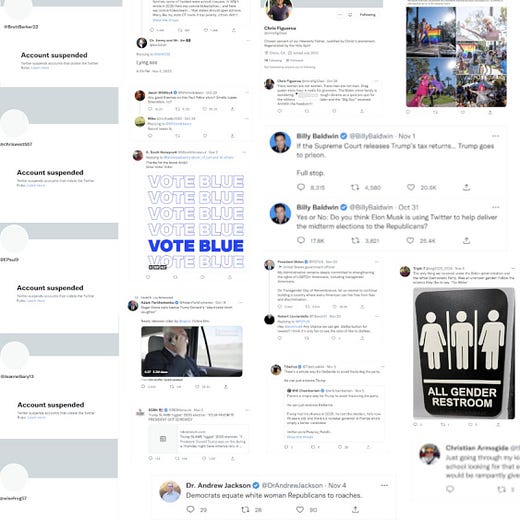
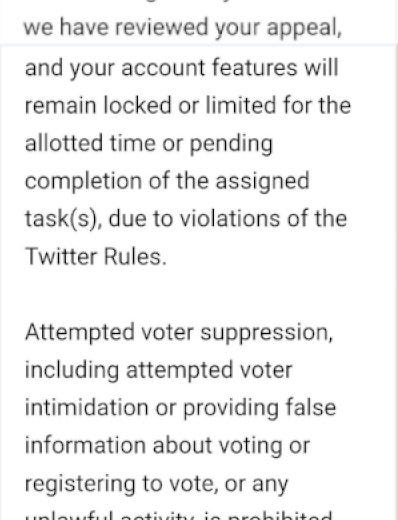
9:00 PM · Dec 16, 2022
270 Reposts · 1.1K Likes

Matt Taibbi@mtaibbi
22.When told of the FBI flagging, @lexitollah replied: “My thoughts initially include 1. Seems like prima facie 1A violation 2. Holy cow, me, an account with the reach of an amoeba 3. What else are they looking at?”
9:00 PM · Dec 16, 2022
266 Reposts · 1.19K Likes

Matt Taibbi@mtaibbi
23.“I can't believe the FBI is policing jokes on Twitter. That's crazy,” said @Tiberius444.
9:00 PM · Dec 16, 2022
308 Reposts · 1.33K Likes

Matt Taibbi@mtaibbi
24.In a letter to former Deputy General Counsel (and former top FBI lawyer) Jim Baker on Sep. 16, 2022, legal exec Stacia Cardille outlines results from her “soon to be weekly” meeting with DHS, DOJ, FBI, and the Office of the Director of National Intelligence:

9:00 PM · Dec 16, 2022
328 Reposts · 1.15K Likes

Matt Taibbi@mtaibbi
25.The Twitter exec writes she explicitly asked if there were “impediments” to the sharing of classified information “with industry.” The answer? “FBI was adamant no impediments to sharing exist.”
9:00 PM · Dec 16, 2022
282 Reposts · 1.15K Likes

Matt Taibbi@mtaibbi
26. This passage underscores the unique one-big-happy-family vibe between Twitter and the FBI. With what other firm would the FBI blithely agree to “no impediments” to classified information?
9:00 PM · Dec 16, 2022
340 Reposts · 1.3K Likes

Matt Taibbi@mtaibbi
27.At the bottom of that letter, she lists a series of “escalations” apparently raised at the meeting, which were already “handled.”
9:00 PM · Dec 16, 2022
125 Reposts · 493 Likes

Matt Taibbi@mtaibbi
28. About one, she writes: “Flagged a specific Tweet on Illinois use of modems to transmit election results in possible violation of the civic integrity policy (except they do use that tech in limited circumstances).”
9:00 PM · Dec 16, 2022
144 Reposts · 536 Likes

Matt Taibbi@mtaibbi
29.Another internal letter from January, 2021 shows Twitter execs processing an FBI list of “possible violative content” tweets:

9:00 PM · Dec 16, 2022
142 Reposts · 529 Likes

Matt Taibbi@mtaibbi
30.Here, too, most tweets contained the same, “Get out there and vote Wednesday!” trope and had low engagement. This is what the FBI spends its time on:

9:00 PM · Dec 16, 2022
143 Reposts · 532 Likes

Matt Taibbi@mtaibbi
31. In this March, 2021 email, an FBI liaison thanks a senior Twitter exec for the chance to speak to “you and the team,” then delivers a packet of “products”:

9:00 PM · Dec 16, 2022
134 Reposts · 518 Likes

Matt Taibbi@mtaibbi
32.The executive circulates the “products,” which are really DHS bulletins stressing the need for greater collaboration between law enforcement and “private sector partners.”

9:00 PM · Dec 16, 2022
134 Reposts · 510 Likes

Matt Taibbi@mtaibbi
33.The ubiquity of the 2016 Russian interference story as stated pretext for building out the censorship machine can’t be overstated. It’s analogous to how 9/11 inspired the expansion of the security state.

9:00 PM · Dec 16, 2022
202 Reposts · 629 Likes

Matt Taibbi@mtaibbi
34.While the DHS in its “products” pans “permissive” social media for offering “operational advantages” to Russians, it also explains that the “Domestic Violent Extremist Threat” requires addressing “information gaps”:

9:00 PM · Dec 16, 2022
121 Reposts · 495 Likes

Matt Taibbi@mtaibbi
35.FBI in one case sent over so many “possible violative content” reports, Twitter personnel congratulated each other in Slack for the “monumental undertaking” of reviewing them:
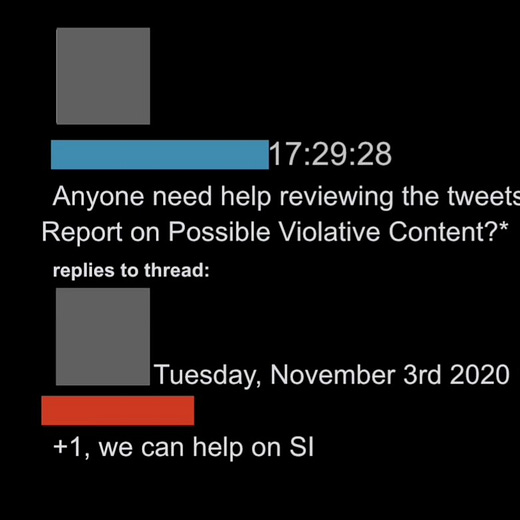
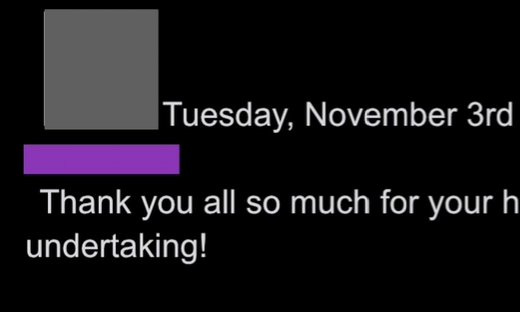
9:00 PM · Dec 16, 2022
150 Reposts · 525 Likes

Matt Taibbi@mtaibbi
36.There were multiple points of entry into Twitter for government-flagged reports. This letter from Agent Chan to Roth references Teleporter, a platform through which Twitter could receive reports from the FBI:

9:00 PM · Dec 16, 2022
162 Reposts · 535 Likes

Matt Taibbi@mtaibbi
37.Reports also came from different agencies. Here, an employee recommends “bouncing” content based on evidence from “DHS etc”:

9:00 PM · Dec 16, 2022
130 Reposts · 507 Likes

Matt Taibbi@mtaibbi
38.State governments also flagged content.
9:00 PM · Dec 16, 2022
136 Reposts · 535 Likes

Matt Taibbi@mtaibbi
39.Twitter for instance received reports via the Partner Support Portal, an outlet created by the Center for Internet Security, a partner organization to the DHS.
9:00 PM · Dec 16, 2022
127 Reposts · 524 Likes

Matt Taibbi@mtaibbi
40.“WHY WAS NO ACTION TAKEN?” Below, Twitter execs – receiving an alert from California officials, by way of “our partner support portal” – debate whether to act on a Trump tweet:
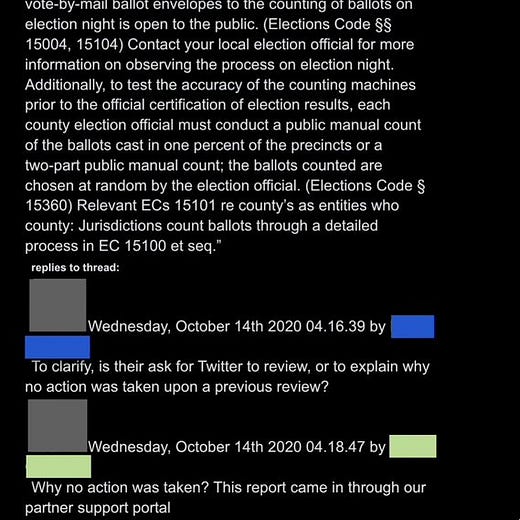
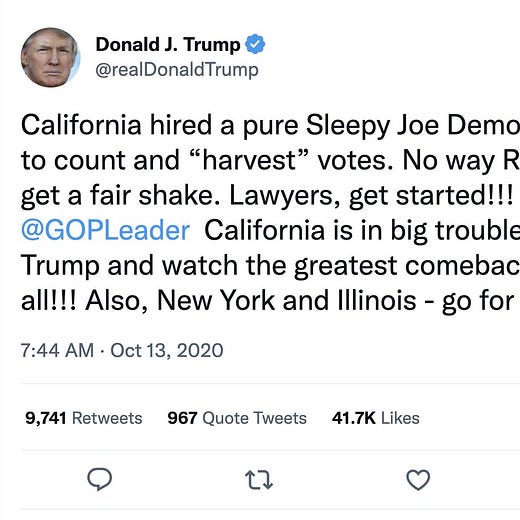
9:00 PM · Dec 16, 2022
170 Reposts · 560 Likes

Matt Taibbi@mtaibbi
41.Here, a video was reported by the Election Integrity Project (EIP) at Stanford, apparently on the strength of information from the Center for Internet Security (CIS):

9:00 PM · Dec 16, 2022
134 Reposts · 514 Likes

Matt Taibbi@mtaibbi
42.If that’s confusing, it’s because the CIS is a DHS contractor, describes itself as “partners” with the Cyber and Internet Security Agency (CISA) at the DHS:

9:00 PM · Dec 16, 2022
154 Reposts · 570 Likes

Matt Taibbi@mtaibbi
43.The EIP is one of a series of government-affiliated think tanks that mass-review content, a list that also includes the Atlantic Council’s Digital Forensics Research Laboratory, and the University of Washington’s Center for Informed Policy.
9:00 PM · Dec 16, 2022
142 Reposts · 568 Likes

Matt Taibbi@mtaibbi
44.The takeaway: what most people think of as the “deep state” is really a tangled collaboration of state agencies, private contractors, and (sometimes state-funded) NGOs. The lines become so blurred as to be meaningless.
9:00 PM · Dec 16, 2022
377 Reposts · 1.23K Likes

Matt Taibbi@mtaibbi
45. Twitter Files researchers are moving into a variety of new areas now. Watch @bariweiss, @ShellenbergerMD, and this space for more, soon.
9:00 PM · Dec 16, 2022
228 Reposts · 1.05K Likes
Supplemental

Matt Taibbi@mtaibbi
1.THREAD: Twitter Files Supplemental
11:03 PM · Dec 18, 2022
2.96K Reposts · 7.26K Likes

Matt Taibbi@mtaibbi
2.In July of 2020, San Francisco FBI agent Elvis Chan tells Twitter executive Yoel Roth to expect written questions from the Foreign Influence Task Force (FITF), the inter-agency group that deals with cyber threats.

11:03 PM · Dec 18, 2022
659 Reposts · 3K Likes

Matt Taibbi@mtaibbi
3.The questionnaire authors seem displeased with Twitter for implying, in a July 20th “DHS/ODNI/FBI/Industry briefing,” that “you indicated you had not observed much recent activity from official propaganda actors on your platform.”

11:03 PM · Dec 18, 2022
582 Reposts · 2.71K Likes

Matt Taibbi@mtaibbi
4.One would think that would be good news. The agencies seemed to feel otherwise.
11:03 PM · Dec 18, 2022
441 Reposts · 2.65K Likes

Matt Taibbi@mtaibbi
5.Chan underscored this: “There was quite a bit of discussion within the USIC to get clarifications from your company,” he wrote, referring to the United States Intelligence Community.
11:03 PM · Dec 18, 2022
449 Reposts · 2.51K Likes

Matt Taibbi@mtaibbi
6.The task force demanded to know how Twitter came to its unpopular conclusion. Oddly, it included a bibliography of public sources - including a Wall Street Journal article - attesting to the prevalence of foreign threats, as if to show Twitter they got it wrong.
11:03 PM · Dec 18, 2022
464 Reposts · 2.58K Likes

Matt Taibbi@mtaibbi
7.Roth, receiving the questions, circulated them with other company executives, and complained that he was “frankly perplexed by the requests here, which seem more like something we'd get from a congressional committee than the Bureau.”

11:03 PM · Dec 18, 2022
513 Reposts · 2.56K Likes

Matt Taibbi@mtaibbi
8.He added he was not “comfortable with the Bureau (and by extension the IC) demanding written answers.” The idea of the FBI acting as conduit for the Intelligence Community is interesting, given that many agencies are barred from domestic operations.
11:03 PM · Dec 18, 2022
580 Reposts · 2.87K Likes

Matt Taibbi@mtaibbi
9.He then sent another note internally, saying the premise of the questions was “flawed,” because “we've been clear that official state propaganda is definitely a thing on Twitter.” Note the italics for emphasis.

11:03 PM · Dec 18, 2022
495 Reposts · 2.47K Likes

Matt Taibbi@mtaibbi
10.Roth suggested they “get on the phone with Elvis ASAP and try to straighten this out,” to disabuse the agencies of any notion that state propaganda is not a “thing” on Twitter.
11:03 PM · Dec 18, 2022
420 Reposts · 2.38K Likes

Matt Taibbi@mtaibbi
11.This exchange is odd among other things because some of the “bibliography” materials cited by the FITF are sourced to intelligence officials, who in turn cited the public sources.
11:03 PM · Dec 18, 2022
451 Reposts · 2.51K Likes

Matt Taibbi@mtaibbi
12.The FBI responded to Friday’s report by saying it “regularly engages with private sector entities to provide information specific to identified foreign malign influence actors’ subversive, undeclared, covert, or criminal activities.”

11:03 PM · Dec 18, 2022
458 Reposts · 2.24K Likes

Matt Taibbi@mtaibbi
13.That may be true, but we haven’t seen that in the documents to date. Instead, we’ve mostly seen requests for moderation involving low-follower accounts belonging to ordinary Americans – and Billy Baldwin.
11:03 PM · Dec 18, 2022
511 Reposts · 2.8K Likes

Matt Taibbi@mtaibbi
11:03 PM · Dec 18, 2022
429 Reposts · 2.44K Likes
Part VII

Michael Shellenberger@ShellenbergerMD
1. TWITTER FILES: PART 7
The FBI & the Hunter Biden Laptop
How the FBI & intelligence community discredited factual information about Hunter Biden’s foreign business dealings both after and *before* The New York Post revealed the contents of his laptop on October 14, 2020
4:09 PM · Dec 19, 2022
7.75K Reposts · 17.1K Likes

Michael Shellenberger@ShellenbergerMD
In Twitter Files #6, we saw the FBI relentlessly seek to exercise influence over Twitter, including over its content, its users, and its data.

Matt Taibbi @mtaibbi
1. THREAD: The Twitter Files, Part Six
TWITTER, THE FBI SUBSIDIARY
4:11 PM · Dec 19, 2022
822 Reposts · 4.34K Likes

Michael Shellenberger@ShellenbergerMD
In Twitter Files #7, we present evidence pointing to an organized effort by representatives of the intelligence community (IC), aimed at senior executives at news and social media companies, to discredit leaked information about Hunter Biden before and after it was published.
4:13 PM · Dec 19, 2022
1.41K Reposts · 5.46K Likes

Michael Shellenberger@ShellenbergerMD
The story begins in December 2019 when a Delaware computer store owner named John Paul (J.P.) Mac Isaac contacts the FBI about a laptop that Hunter Biden had left with him
On Dec 9, 2019, the FBI issues a subpoena for, and takes, Hunter Biden's laptop.
nypost.com/2020/10/14/ema…
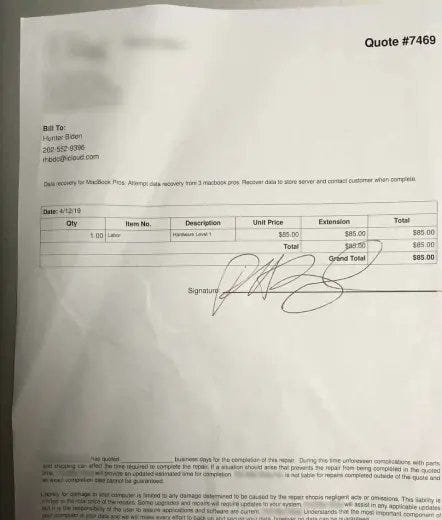

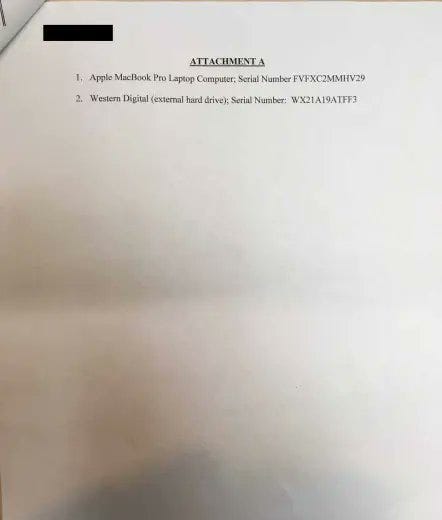
4:18 PM · Dec 19, 2022
976 Reposts · 4.21K Likes

Michael Shellenberger@ShellenbergerMD
By Aug 2020, Mac Isaac still had not heard back from the FBI, even though he had discovered evidence of criminal activity. And so he emails Rudy Giuliani, who was under FBI surveillance at the time. In early Oct, Giuliani gives it to @nypost
nypost.com
Smoking-gun email reveals how Hunter Biden introduced Ukrainian businessman to VP dad

4:21 PM · Dec 19, 2022
903 Reposts · 4K Likes

Michael Shellenberger@ShellenbergerMD
Shortly before 7 pm ET on October 13, Hunter Biden’s lawyer, George Mesires, emails JP Mac Isaac.
Hunter and Mesires had just learned from the New York Post that its story about the laptop would be published the next day.

4:22 PM · Dec 19, 2022
713 Reposts · 3.35K Likes

Michael Shellenberger@ShellenbergerMD
7. At 9:22 pm ET (6:22 PT), FBI Special Agent Elvis Chan sends 10 documents to Twitter’s then-Head of Site Integrity, Yoel Roth, through Teleporter, a one-way communications channel from the FBI to Twitter.

4:25 PM · Dec 19, 2022
947 Reposts · 3.69K Likes

Michael Shellenberger@ShellenbergerMD
8. The next day, October 14, 2020, The New York Post runs its explosive story revealing the business dealings of President Joe Biden’s son, Hunter. Every single fact in it was accurate.

4:26 PM · Dec 19, 2022
1.3K Reposts · 4.65K Likes

Michael Shellenberger@ShellenbergerMD
9. And yet, within hours, Twitter and other social media companies censor the NY Post article, preventing it from spreading and, more importantly, undermining its credibility in the minds of many Americans.
Why is that? What, exactly, happened?
4:27 PM · Dec 19, 2022
1.12K Reposts · 4.92K Likes

Michael Shellenberger@ShellenbergerMD
10. On Dec 2, @mtaibbi described the debate inside Twitter over its decision to censor a wholly accurate article.
Since then, we have discovered new info that points to an organized effort by the intel community to influence Twitter & other platforms

Matt Taibbi @mtaibbi
1. Thread: THE TWITTER FILES
4:32 PM · Dec 19, 2022
871 Reposts · 3.77K Likes

Michael Shellenberger@ShellenbergerMD
11. First, it's important to understand that Hunter Biden earned *tens of millions* of dollars in contracts with foreign businesses, including ones linked to China's government, for which Hunter offered no real work.
Here's an overview by investigative journalist @peterschweizer
4:36 PM · Dec 19, 2022
1.49K Reposts · 4.32K Likes

Michael Shellenberger@ShellenbergerMD
12. And yet, during all of 2020, the FBI and other law enforcement agencies repeatedly primed Yoel Roth to dismiss reports of Hunter Biden’s laptop as a Russian “hack and leak” operation.
This is from a sworn declaration by Roth given in December 2020.
fec.gov/files/legal/mu…

4:40 PM · Dec 19, 2022
752 Reposts · 2.71K Likes

Michael Shellenberger@ShellenbergerMD
13. They did the same to Facebook, according to CEO Mark Zuckerberg. “The FBI basically came to us [and] was like, ‘Hey... you should be on high alert. We thought that there was a lot of Russian propaganda in 2016 election. There's about to be some kind of dump similar to that.'"
4:43 PM · Dec 19, 2022
733 Reposts · 2.66K Likes

Michael Shellenberger@ShellenbergerMD
14. Were the FBI warnings of a Russian hack-and-leak operation relating to Hunter Biden based on *any* new intel?
No, they weren't
“Through our investigations, we did not see any similar competing intrusions to what had happened in 2016,” admitted FBI agent Elvis Chan in Nov.
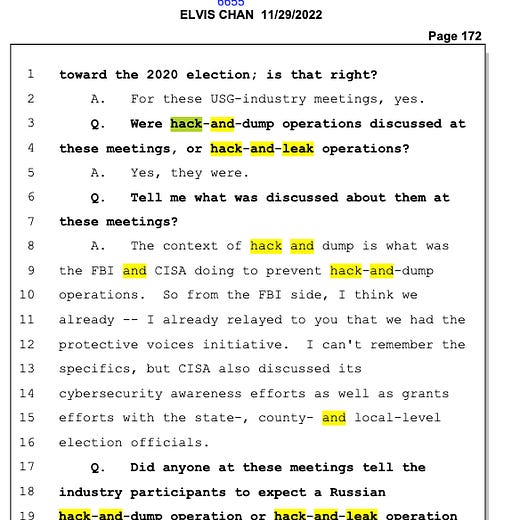
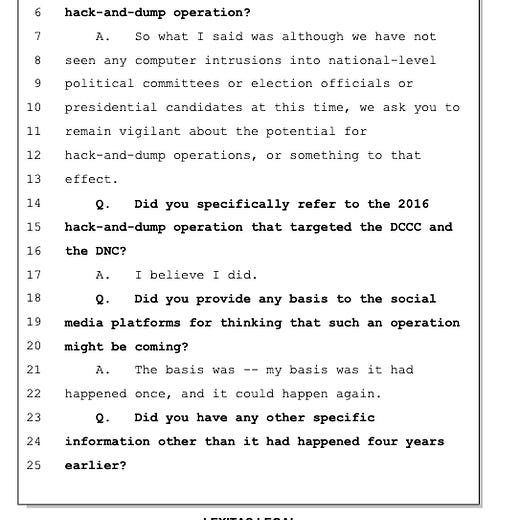
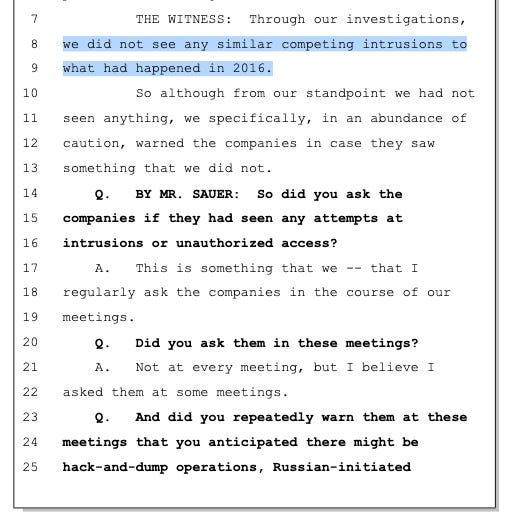
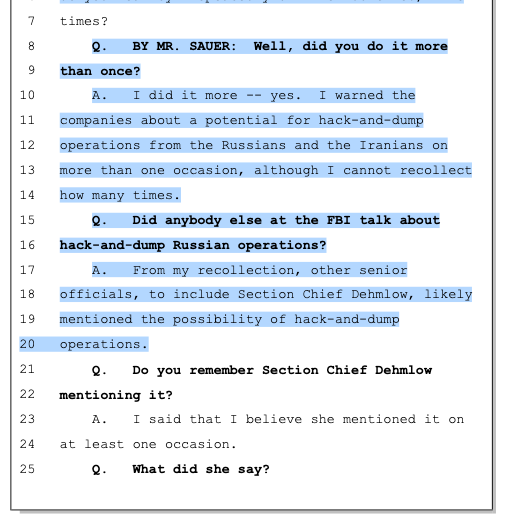
4:48 PM · Dec 19, 2022
638 Reposts · 2.24K Likes

Michael Shellenberger@ShellenbergerMD
15. Indeed, Twitter executives *repeatedly* reported very little Russian activity.
E.g., on Sept 24, 2020, Twitter told FBI it had removed 345 “largely inactive” accounts “linked to previous coordinated Russian hacking attempts.” They “had little reach & low follower accounts."

4:57 PM · Dec 19, 2022
249 Reposts · 891 Likes

Michael Shellenberger@ShellenbergerMD
16. In fact, Twitter debunked false claims by journalists of foreign influence on its platform
"We haven’t seen any evidence to support that claim” by @oneunderscore__ @nbc News of foreign-controlled bots.
“Our review thus far shows a small-scale domestic troll effort…”
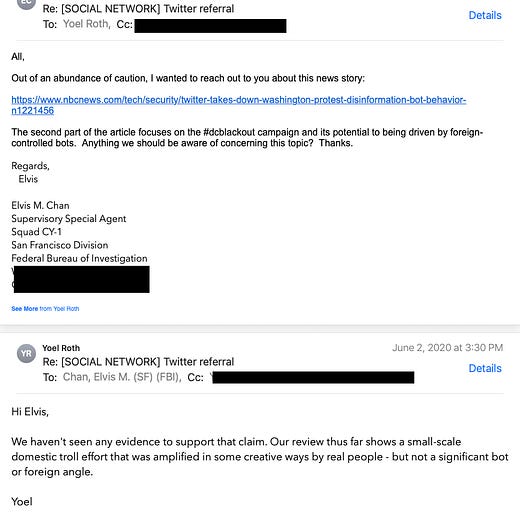
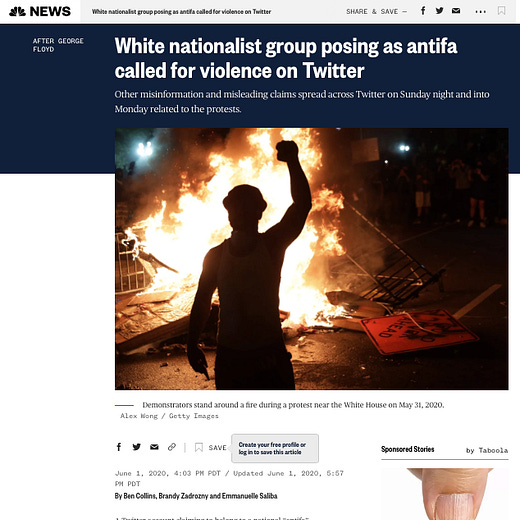
5:06 PM · Dec 19, 2022
59 Reposts · 190 Likes

Michael Shellenberger@ShellenbergerMD
17. After FBI asks about a WaPo story on alleged foreign influence in a pro-Trump tweet, Twitter's Roth says, "The article makes a lot of insinuations... but we saw no evidence that that was the case here (and in fact, a lot of strong evidence pointing in the other direction).”
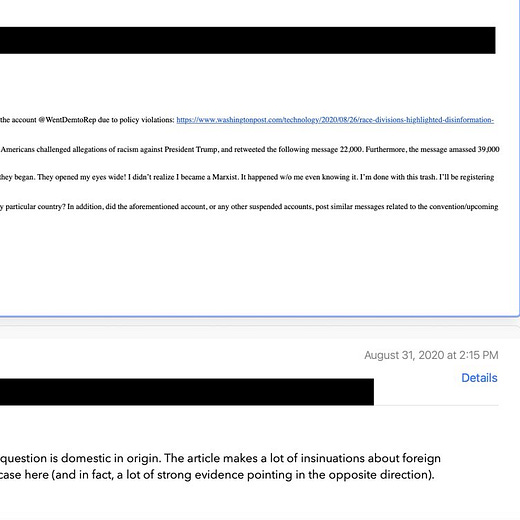

5:11 PM · Dec 19, 2022
208 Reposts · 849 Likes

Michael Shellenberger@ShellenbergerMD
18. It's not the first time that Twitter's Roth has pushed back against the FBI. In January 2020, Roth resisted FBI efforts to get Twitter to share data outside of the normal search warrant process.
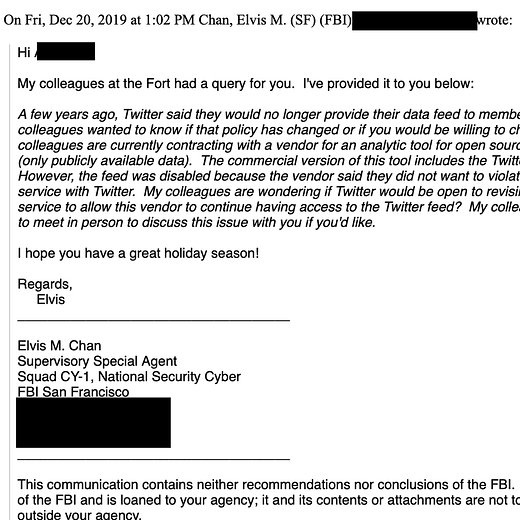

5:14 PM · Dec 19, 2022
104 Reposts · 383 Likes

Michael Shellenberger@ShellenbergerMD
19. Pressure had been growing:
“We have seen a sustained (If uncoordinated) effort by the IC [intelligence community] to push us to share more info & change our API policies. They are probing & pushing everywhere they can (including by whispering to congressional staff).”

5:16 PM · Dec 19, 2022
58 Reposts · 181 Likes

Michael Shellenberger@ShellenbergerMD
20. Time and again, FBI asks Twitter for evidence of foreign influence & Twitter responds that they aren’t finding anything worth reporting.
“[W]e haven’t yet identified activity that we’d typically refer to you (or even flag as interesting in the foreign influence context).”
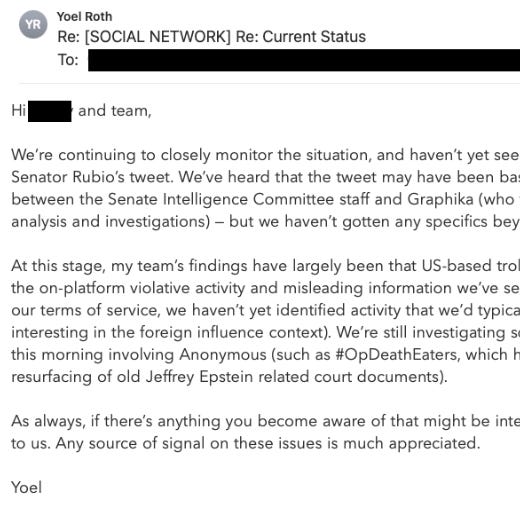

5:21 PM · Dec 19, 2022
65 Reposts · 149 Likes

Michael Shellenberger@ShellenbergerMD
21. Despite Twitter’s pushback, the FBI repeatedly requests information from Twitter that Twitter has already made clear it will not share outside of normal legal channels.

5:24 PM · Dec 19, 2022
233 Reposts · 758 Likes

Michael Shellenberger@ShellenbergerMD
22. Then, in July 2020, the FBI’s Elvis Chan arranges for temporary Top Secret security clearances for Twitter executives so that the FBI can share information about threats to the upcoming elections.

5:25 PM · Dec 19, 2022
266 Reposts · 698 Likes

Michael Shellenberger@ShellenbergerMD
23. On August 11, 2020, the FBI's Chan shares information with Twitter's Roth relating to the Russian hacking organization, APT28, through the FBI's secure, one-way communications channel, Teleporter.

5:26 PM · Dec 19, 2022
134 Reposts · 420 Likes

Michael Shellenberger@ShellenbergerMD
24. Recently, Yoel Roth told @karaswisher that he had been primed to think about the Russian hacking group APT28 before news of the Hunter Biden laptop came out.
When it did, Roth said, "It set off every single one of my finely tuned APT28 hack-and-leap campaign alarm bells."
5:31 PM · Dec 19, 2022
48 Reposts · 137 Likes

Michael Shellenberger@ShellenbergerMD
25. In Aug, 2020, FBI’s Chan asks Twitter: does anyone there have top secret clearance?
When someone mentions Jim Baker, Chan responds, "I don't know how I forgot him" — an odd claim, given Chan's job is to monitor Twitter, not to mention that they worked together at the FBI.
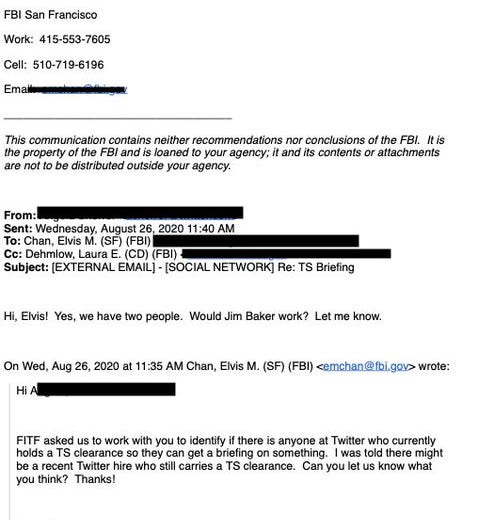
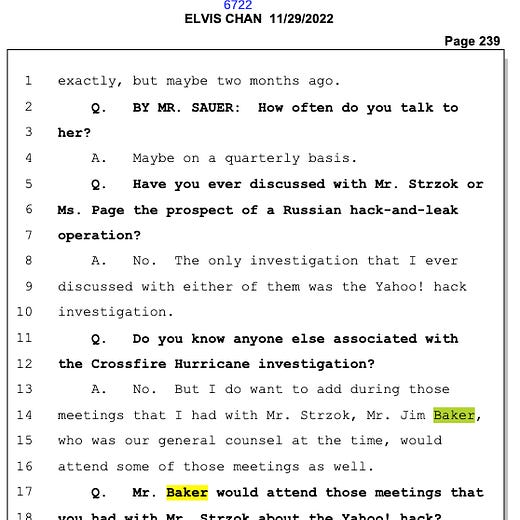
5:36 PM · Dec 19, 2022
64 Reposts · 186 Likes

Michael Shellenberger@ShellenbergerMD
26. Who is Jim Baker? He's former general counsel of the FBI (2014-18) & one of the most powerful men in the U.S. intel community.
Baker has moved in and out of government for 30 years, serving stints at CNN, Bridgewater (a $140 billion asset management firm) and Brookings
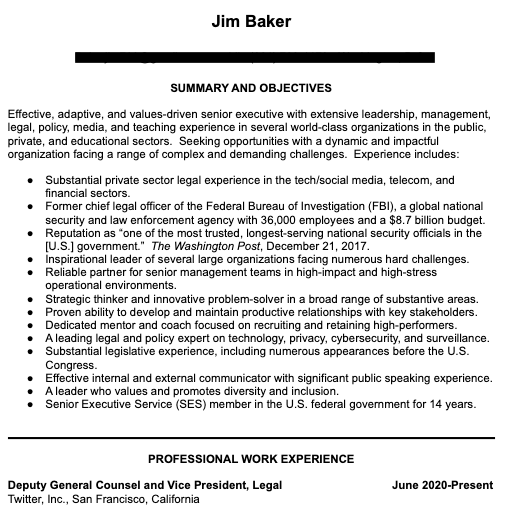

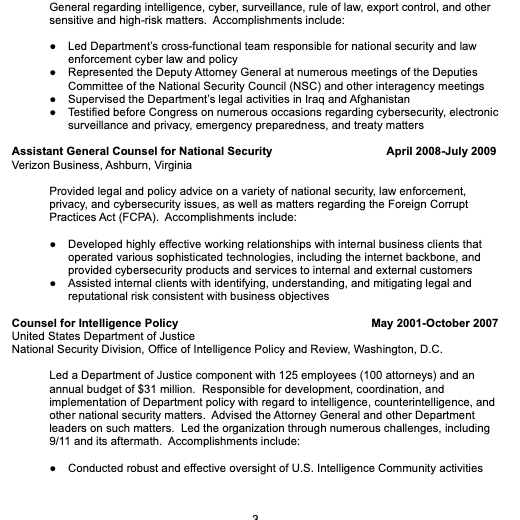
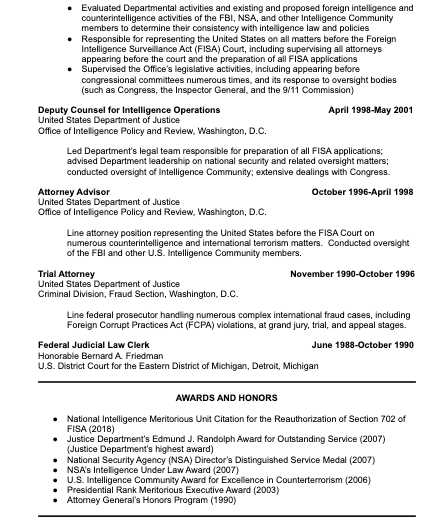
5:40 PM · Dec 19, 2022
58 Reposts · 146 Likes

Michael Shellenberger@ShellenbergerMD
27. As general counsel of the FBI, Baker played a central role in making the case internally for an investigation of Donald Trump
wsj.com
FBI Took Michael Sussmann’s Allegation of Trump-Russia Ties Seriously, Former Official Testifies

5:42 PM · Dec 19, 2022
126 Reposts · 414 Likes

Michael Shellenberger@ShellenbergerMD
28. Baker wasn't the only senior FBI exec. involved in the Trump investigation to go to Twitter.
Dawn Burton, the former dep. chief of staff to FBI head James Comey, who initiated the investigation of Trump, joined Twitter in 2019 as director of strategy.
5:42 PM · Dec 19, 2022
158 Reposts · 428 Likes

Michael Shellenberger@ShellenbergerMD
29. As of 2020, there were so many former FBI employees — "Bu alumni" — working at Twitter that they had created their own private Slack channel and a crib sheet to onboard new FBI arrivals.

5:44 PM · Dec 19, 2022
262 Reposts · 689 Likes

Michael Shellenberger@ShellenbergerMD
30. Efforts continued to influence Twitter's Yoel Roth.
In Sept 2020, Roth participated in an Aspen Institute “tabletop exercise” on a potential "Hack-and-Dump" operation relating to Hunter Biden
The goal was to shape how the media covered it — and how social media carried it
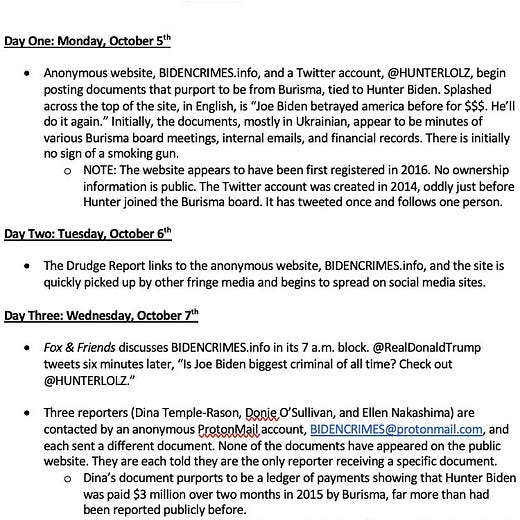
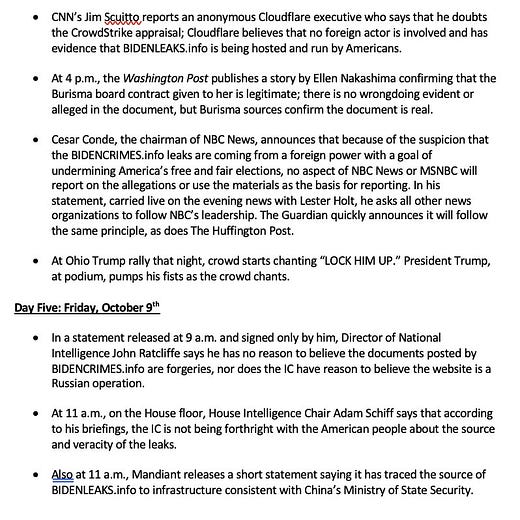
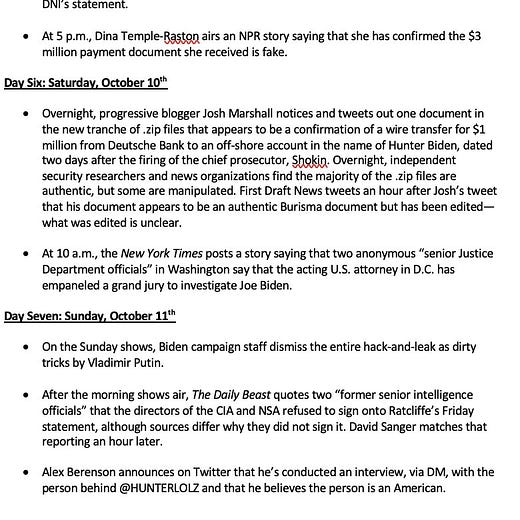
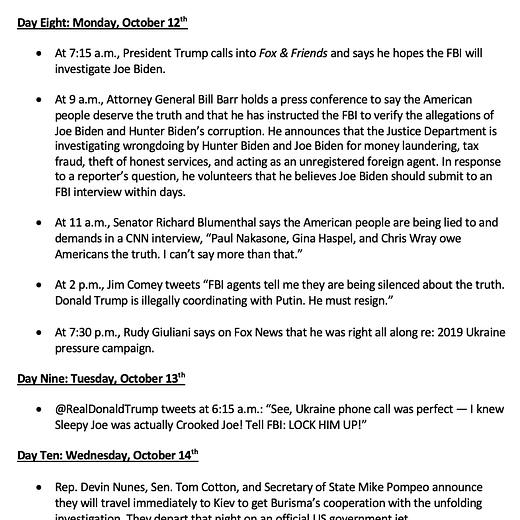
5:47 PM · Dec 19, 2022
33 Reposts · 106 Likes

Michael Shellenberger@ShellenbergerMD
31. The organizer was Vivian Schiller, the fmr CEO of NPR, fmr head of news at Twitter; fmr Gen. mgr of NY Times; fmr Chief Digital Officer of NBC News
Attendees included Meta/FB's head of security policy and the top nat. sec. reporters for @nytimes @wapo and others

5:51 PM · Dec 19, 2022
177 Reposts · 523 Likes

Michael Shellenberger@ShellenbergerMD
32. By mid-Sept, 2020, Chan & Roth had set up an encrypted messaging network so employees from FBI & Twitter could communicate.
They also agree to create a “virtual war room” for “all the [Internet] industry plus FBI and ODNI” [Office of the Director of National Intelligence].
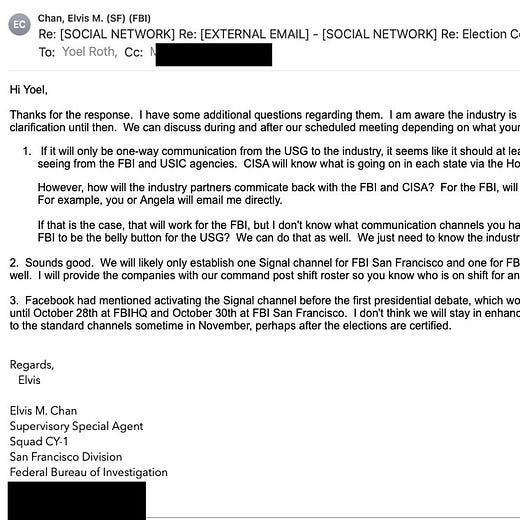
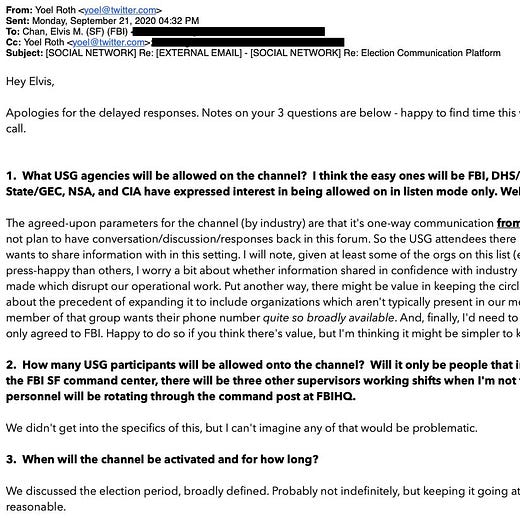
5:56 PM · Dec 19, 2022
273 Reposts · 659 Likes

Michael Shellenberger@ShellenbergerMD
33. Then, on Sept 15, 2020 the FBI’s Laura Dehmlow, who heads up the Foreign Influence Task Force, and Elvis Chan, request to give a classified briefing for Jim Baker, without any other Twitter staff, such as Yoel Roth, present.

6:02 PM · Dec 19, 2022
191 Reposts · 615 Likes

Michael Shellenberger@ShellenbergerMD
34. On Oct 14, shortly after @nypost publishes its Hunter Biden laptop story, Roth says, “it isn’t clearly violative of our Hacked Materials Policy, nor is it clearly in violation of anything else," but adds, “this feels a lot like a somewhat subtle leak operation.”

6:04 PM · Dec 19, 2022
33 Reposts · 93 Likes

Michael Shellenberger@ShellenbergerMD
35. In response to Roth, Baker repeatedly insists that the Hunter Biden materials were either faked, hacked, or both, and a violation of Twitter policy. Baker does so over email, and in a Google doc, on October 14 and 15.
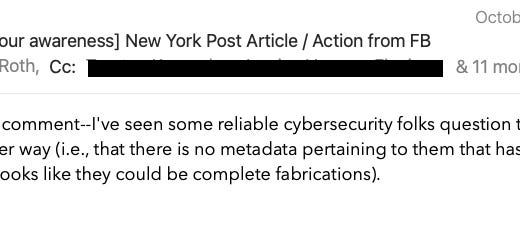
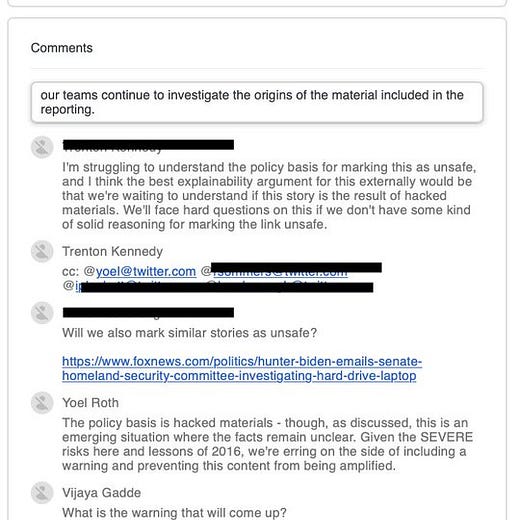
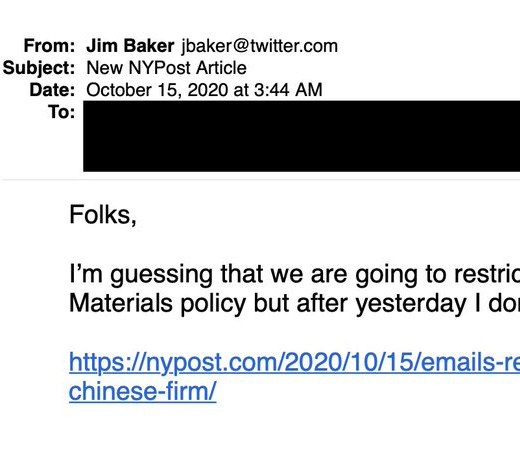
6:10 PM · Dec 19, 2022
33 Reposts · 82 Likes

Michael Shellenberger@ShellenbergerMD
36. And yet it's inconceivable Baker believed the Hunter Biden emails were either fake or hacked. The @nypost had included a picture of the receipt signed by Hunter Biden, and an FBI subpoena showed that the agency had taken possession of the laptop in December 2019.
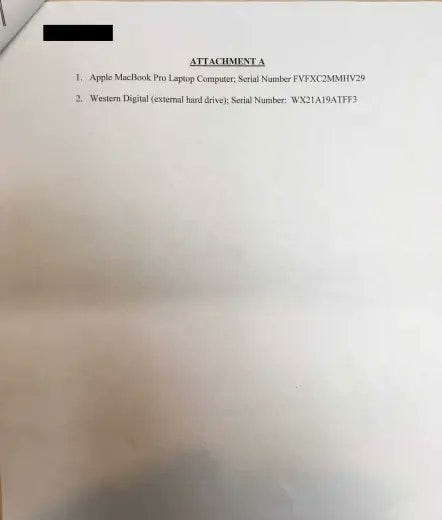
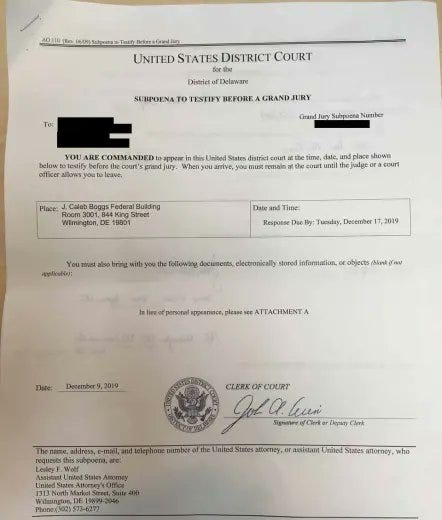
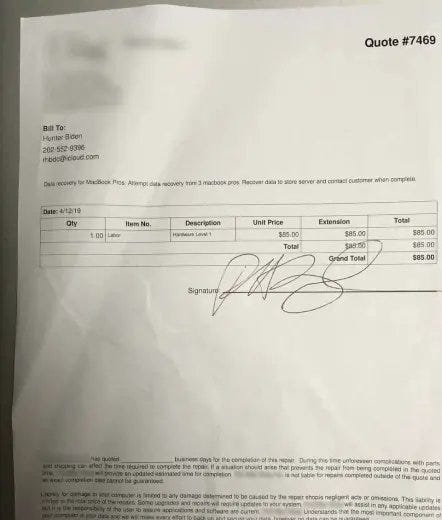
6:12 PM · Dec 19, 2022
97 Reposts · 249 Likes

Michael Shellenberger@ShellenbergerMD
37. As for the FBI, it likely would have taken a few *hours* for it to confirm that the laptop had belonged to Hunter Biden. Indeed, it only took a few days for journalist @peterschweizer to prove it.
6:14 PM · Dec 19, 2022
26 Reposts · 79 Likes

Michael Shellenberger@ShellenbergerMD
38. By 10 am, Twitter execs had bought into a wild hack-and-dump story
“The suggestion from experts - which rings true - is there was a hack that happened separately, and they loaded the hacked materials on the laptop that magically appeared at a repair shop in Delaware”

6:18 PM · Dec 19, 2022
39 Reposts · 117 Likes

Michael Shellenberger@ShellenbergerMD
39. At 3:38 pm that same day, October 14, Baker arranges a phone conversation with Matthew J. Perry in the Office of the General Counsel of the FBI

6:20 PM · Dec 19, 2022
43 Reposts · 120 Likes

Michael Shellenberger@ShellenbergerMD
40. The influence operation persuaded Twitter execs that the Hunter Biden laptop did *not* come from a whistleblower.
One linked to a Hill article, based on a WaPo article, from Oct 15, which falsely suggested that Giuliani’s leak of the laptop had something to do with Russia.

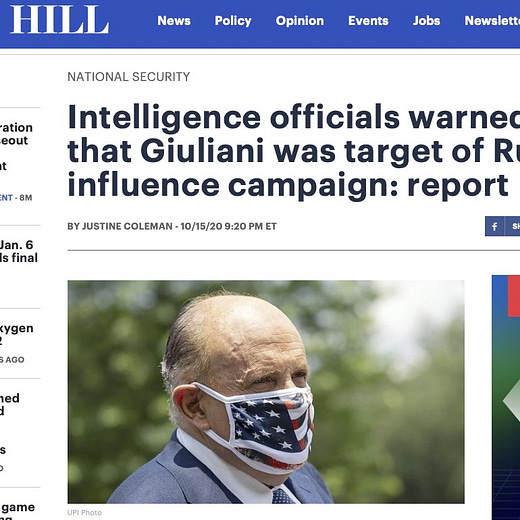
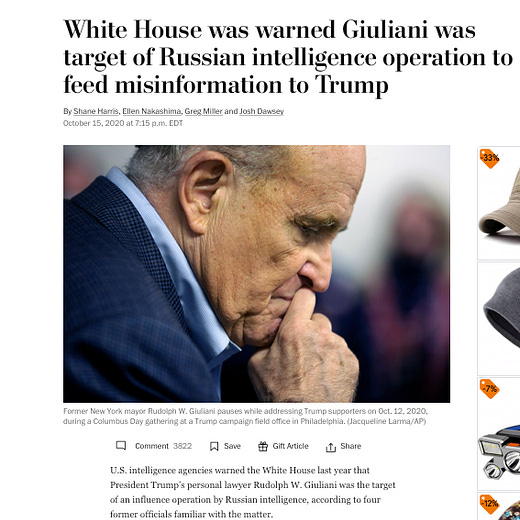
6:25 PM · Dec 19, 2022
100 Reposts · 328 Likes

Michael Shellenberger@ShellenbergerMD
41. There is evidence that FBI agents have warned elected officials of foreign influence with the primary goal of leaking the information to the news media. This is a political dirty trick used to create the perception of impropriety.
6:27 PM · Dec 19, 2022
160 Reposts · 553 Likes

Michael Shellenberger@ShellenbergerMD
42. In 2020, the FBI gave a briefing to Senator Grassley and Johnson, claiming evidence of “Russian interference” into their investigation of Hunter Biden.
The briefing angered the Senators, who say it was done to discredit their investigation.
grassley.senate.gov
6:29 PM · Dec 19, 2022
102 Reposts · 324 Likes

Michael Shellenberger@ShellenbergerMD
43. “The unnecessary FBI briefing provided the Democrats and liberal media the vehicle to spread their false narrative that our work advanced Russian disinformation.”
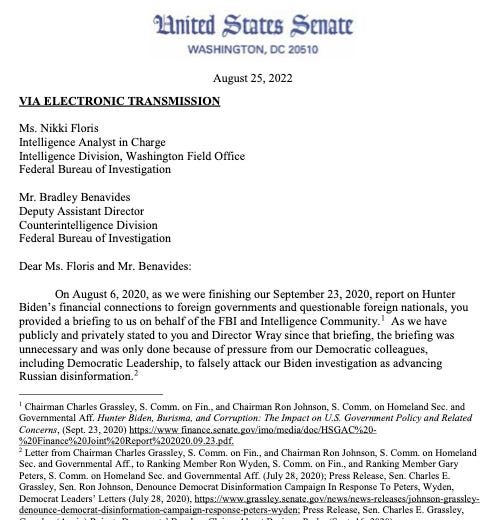

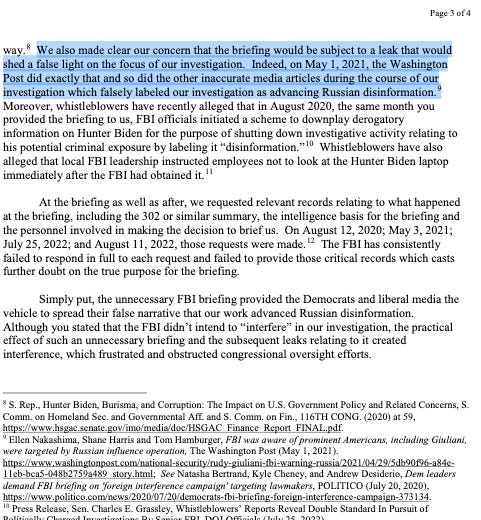
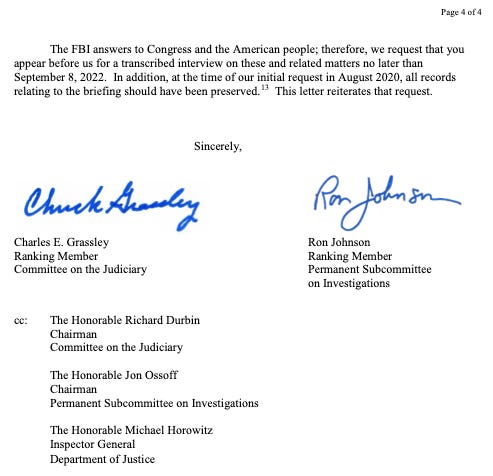
6:29 PM · Dec 19, 2022
84 Reposts · 279 Likes

Michael Shellenberger@ShellenbergerMD
44. Notably, then-FBI General Counsel Jim Baker was investigated *twice,* in 2017 and 2019, for leaking information to the news media.
“You’re saying he’s under criminal investigation? That’s why you’re not letting him answer?” Meadows asked.
“Yes”
politico.com
Ex-FBI general counsel faced criminal leak probe

6:32 PM · Dec 19, 2022
53 Reposts · 140 Likes

Michael Shellenberger@ShellenbergerMD
45. In the end, the FBI's influence campaign aimed at executives at news media, Twitter, & other social media companies worked: they censored & discredited the Hunter Biden laptop story.
By Dec. 2020, Baker and his colleagues even sent a note of thanks to the FBI for its work.

6:35 PM · Dec 19, 2022
171 Reposts · 438 Likes

Michael Shellenberger@ShellenbergerMD
46. The FBI’s influence campaign may have been helped by the fact that it was paying Twitter millions of dollars for its staff time.
“I am happy to report we have collected $3,415,323 since October 2019!” reports an associate of Jim Baker in early 2021.

6:36 PM · Dec 19, 2022
78 Reposts · 175 Likes

Michael Shellenberger@ShellenbergerMD
47. And the pressure from the FBI on social media platforms continues
In Aug 2022, Twitter execs prepared for a meeting with the FBI, whose goal was “to convince us to produce on more FBI EDRs"
EDRs are an “emergency disclosure request,” a warrantless search.

6:40 PM · Dec 19, 2022
39 Reposts · 90 Likes

Michael Shellenberger@ShellenbergerMD
In response to the Twitter Files revelation of high-level FBI agents at Twitter, @Jim_Jordan said, “I have concerns about whether the government was running a misinformation operation on We the People.”
nypost.com
Twitter’s top ranks riddled with ex-FBI employees

6:42 PM · Dec 19, 2022
20 Reposts · 103 Likes

Michael Shellenberger@ShellenbergerMD
Anyone who reads the Twitter Files, regardless of their political orientation, should share those concerns.
/END
6:44 PM · Dec 19, 2022
12 Reposts · 69 Likes
Part VIII

Lee Fang@lhfang
1. TWITTER FILES PART 8
*How Twitter Quietly Aided the Pentagon’s Covert Online PsyOp Campaign*
Despite promises to shut down covert state-run propaganda networks, Twitter docs show that the social media giant directly assisted the U.S. military’s influence operations.
8:02 PM · Dec 20, 2022
2.13K Reposts · 3.83K Likes

Lee Fang@lhfang
2. Twitter has claimed for years that they make concerted efforts to detect & thwart gov-backed platform manipulation. Here is Twitter testifying to Congress about its pledge to rapidly identify and shut down all state-backed covert information operations & deceptive propaganda.

8:05 PM · Dec 20, 2022
319 Reposts · 1.09K Likes

Lee Fang@lhfang
3. But behind the scenes, Twitter gave approval & special protection to the U.S. military’s online psychological influence ops. Despite knowledge that Pentagon propaganda accounts used covert identities, Twitter did not suspend many for around 2 years or more. Some remain active.
8:08 PM · Dec 20, 2022
212 Reposts · 647 Likes

Lee Fang@lhfang
4. In 2017, a U.S. Central Command (CENTCOM) official sent Twitter a list of 52 Arab language accounts “we use to amplify certain messages.” The official asked for priority service for six accounts, verification for one & “whitelist” abilities for the others.

8:11 PM · Dec 20, 2022
165 Reposts · 434 Likes

Lee Fang@lhfang
5. The same day CENTCOM sent the list, Twitter officials used a tool to grant a special “whitelist” tag that essentially provides verification status to the accounts w/o the blue check, meaning they are exempt from spam/abuse flags, more visible/likely to trend on hashtags.
8:12 PM · Dec 20, 2022
86 Reposts · 321 Likes

Lee Fang@lhfang
6. The CENTCOM accounts on the list tweeted frequently about U.S. military priorities in the Middle East, including promoting anti-Iran messages, promotion of the Saudi Arabia-U.S. backed war in Yemen, and “accurate” U.S. drone strikes that claimed to only hit terrorists.


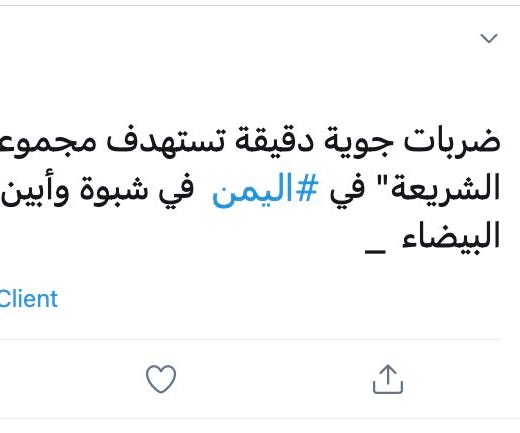
8:15 PM · Dec 20, 2022
65 Reposts · 159 Likes

Lee Fang@lhfang
8. One Twitter official who spoke to me said he feels deceived by the covert shift. Still, many emails from throughout 2020 show that high-level Twitter executives were well aware of DoD’s vast network of fake accounts & covert propaganda and did not suspend the accounts.
8:19 PM · Dec 20, 2022
48 Reposts · 155 Likes

Lee Fang@lhfang
9. For example, Twitter lawyer Jim Baker mused in a July 2020 email, about an upcoming DoD meeting, that the Pentagon used "poor tradecraft" in setting up its network, and were seeking strategies for not exposing the accounts that are “linked to each other or to DoD or the USG.”
8:21 PM · Dec 20, 2022
48 Reposts · 146 Likes

Lee Fang@lhfang
10. Stacia Cardille, another Twitter attorney, replied that the Pentagon wanted a SCIF & may want to retroactively classify its social media activities “to obfuscate their activity in this space, and that this may represent an overclassification to avoid embarrassment.”

8:25 PM · Dec 20, 2022
43 Reposts · 103 Likes

Lee Fang@lhfang
11. In several other 2020 emails, high-level Twitter executives/lawyers discussed the covert network and even recirculated the 2017 list from CENTCOM and shared another list of 157 undisclosed Pentagon accounts, again mostly focused on Middle East military issues.
8:28 PM · Dec 20, 2022
120 Reposts · 433 Likes

Lee Fang@lhfang
12. In a May 2020 email, Twitter’s Lisa Roman emailed the DoD w/two lists. One list was accounts “previously provided to us” & another list Twitter detected. The accounts tweeted in Russian & Arabic on US military issues in Syria/ISIS & many also did not disclose Pentagon ties.

8:30 PM · Dec 20, 2022
138 Reposts · 510 Likes

Lee Fang@lhfang
13. Many of these secretive U.S. military propaganda accounts, despite detection by Twitter as late as 2020 (but potentially earlier) continued tweeting through this year, some not suspended until May 2022 or later, according to records I reviewed.
8:31 PM · Dec 20, 2022
135 Reposts · 441 Likes

Lee Fang@lhfang
14. In August 2022, a Stanford Internet Observatory report exposed a U.S. military covert propaganda network on Facebook, Telegram, Twitter & other apps using fake news portals and deep fake images and memes against U.S. foreign adversaries.
public-assets.graphika.com
8:33 PM · Dec 20, 2022
93 Reposts · 277 Likes

Lee Fang@lhfang
15. The U.S. propaganda network relentlessly pushed narratives against Russia, China, and other foreign countries. They accused Iran of "threatening Iraq’s water security and flooding the country with crystal meth," and of harvesting the organs of Afghan refugees.
8:34 PM · Dec 20, 2022
82 Reposts · 280 Likes

Lee Fang@lhfang
16. The Stanford report did not identify all of the accounts in the network but one they did name was the exact same Twitter account CENTCOM asked for whitelist privileges in its 2017 email. I verified via Twitter’s internal tools. The account used an AI-created deep fake image.
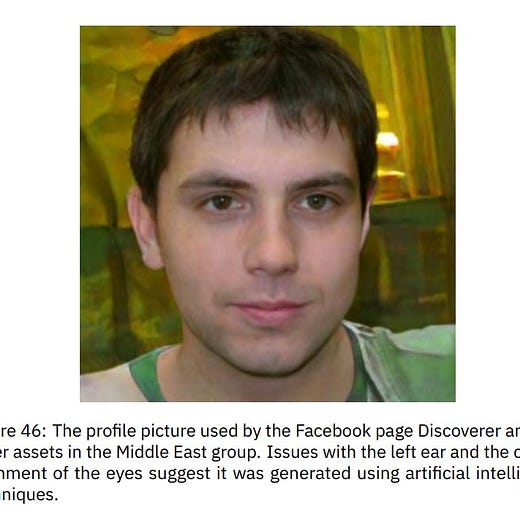
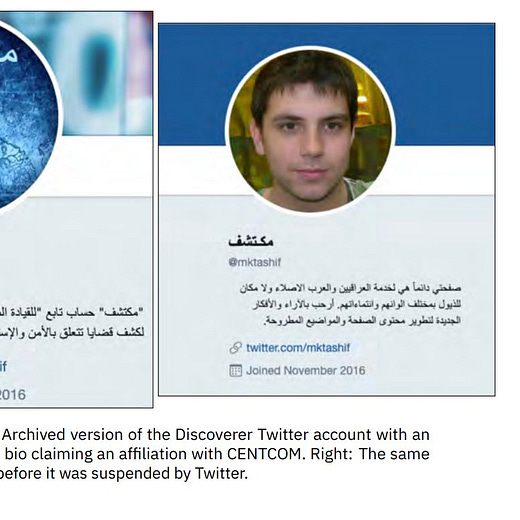
8:37 PM · Dec 20, 2022
55 Reposts · 147 Likes

Lee Fang@lhfang
17. In subsequent reporting, Twitter was cast as an unbiased hero for removing “a network of fake user accounts promoting pro-Western policy positions.” Media covering the story described Twitter as evenly applying its policies & proactive in suspending the DoD network.
8:41 PM · Dec 20, 2022
188 Reposts · 665 Likes

Lee Fang@lhfang
18. The reality is much more murky. Twitter actively assisted CENTCOM’s network going back to 2017 and as late as 2020 knew these accounts were covert/designed to deceive to manipulate the discourse, a violation of Twitter’s policies & promises. They waited years to suspend.
8:42 PM · Dec 20, 2022
385 Reposts · 1.3K Likes

Lee Fang@lhfang
19. Twitter’s comms team was closely in touch with reporters, working to minimize Twitter’s role. When the WashPost reported on the scandal, Twitter officials congratulated each other because the story didn’t mention any Twitter employees & focused largely on the Pentagon.
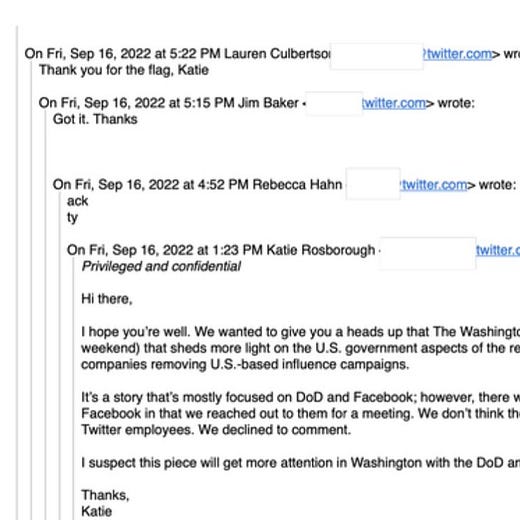
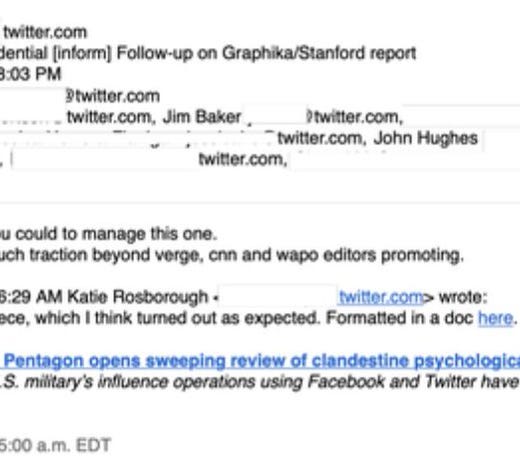
8:46 PM · Dec 20, 2022
231 Reposts · 692 Likes

Lee Fang@lhfang
20. The conduct with the U.S. military’s covert network stands in stark contrast with how Twitter has boasted about rapidly identifying and taking down covert accounts tied to state-backed influence operations, including Thailand, Russia, Venezuela, and others since 2016.
8:48 PM · Dec 20, 2022
161 Reposts · 548 Likes

Lee Fang@lhfang
21. Here is my reported piece w/more detail. I was given access to Twitter for a few days. I signed/agreed to nothing, Twitter had no input into anything I did or wrote. The searches were carried out by a Twitter attorney, so what I saw could be limited.
theintercept.com
Twitter Aided the Pentagon in its Covert Online Propaganda Campaign

8:51 PM · Dec 20, 2022
207 Reposts · 552 Likes
Part IX

Matt Taibbi@mtaibbi
1.THREAD: The Twitter Files
TWITTER AND "OTHER GOVERNMENT AGENCIES"
5:20 PM · Dec 24, 2022
657 Reposts · 1.25K Likes

Matt Taibbi@mtaibbi
After weeks of “Twitter Files” reports detailing close coordination between the FBI and Twitter in moderating social media content, the Bureau issued a statement Wednesday.
5:20 PM · Dec 24, 2022
90 Reposts · 509 Likes

Matt Taibbi@mtaibbi
2.It didn’t refute allegations. Instead, it decried “conspiracy theorists” publishing “misinformation,” whose “sole aim” is to “discredit the agency.”

5:20 PM · Dec 24, 2022
103 Reposts · 596 Likes

Matt Taibbi@mtaibbi
3.They must think us unambitious, if our “sole aim” is to discredit the FBI. After all, a whole range of government agencies discredit themselves in the #TwitterFiles. Why stop with one?
5:20 PM · Dec 24, 2022
129 Reposts · 710 Likes

Matt Taibbi@mtaibbi
4.The files show the FBI acting as doorman to a vast program of social media surveillance and censorship, encompassing agencies across the federal government – from the State Department to the Pentagon to the CIA.
5:20 PM · Dec 24, 2022
145 Reposts · 609 Likes

Matt Taibbi@mtaibbi
5.The operation is far bigger than the reported 80 members of the Foreign Influence Task Force (FITF), which also facilitates requests from a wide array of smaller actors - from local cops to media to state governments.
5:20 PM · Dec 24, 2022
102 Reposts · 523 Likes

Matt Taibbi@mtaibbi
6.Twitter had so much contact with so many agencies that executives lost track. Is today the DOD, and tomorrow the FBI? Is it the weekly call, or the monthly meeting? It was dizzying.
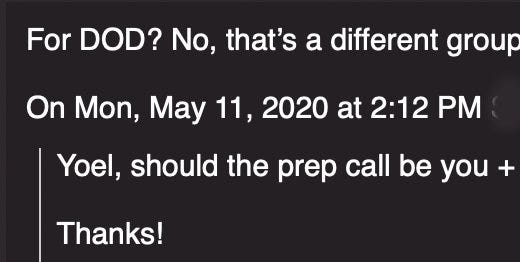

5:20 PM · Dec 24, 2022
107 Reposts · 495 Likes

Matt Taibbi@mtaibbi
7.A chief end result was that thousands of official “reports” flowed to Twitter from all over, through the FITF and the FBI’s San Francisco field office.
5:20 PM · Dec 24, 2022
77 Reposts · 428 Likes

Matt Taibbi@mtaibbi
8.On June 29th, 2020, San Francisco FBI agent Elvis Chan wrote to pair of Twitter execs asking if he could invite an “OGA” to an upcoming conference:

5:20 PM · Dec 24, 2022
84 Reposts · 395 Likes

Matt Taibbi@mtaibbi
9.OGA, or “Other Government Organization,” can be a euphemism for CIA, according to multiple former intelligence officials and contractors. Chuckles one: “They think it's mysterious, but it's just conspicuous."
5:20 PM · Dec 24, 2022
39 Reposts · 210 Likes

Matt Taibbi@mtaibbi
10.“Other Government Agency (the place where I worked for 27 years),” says retired CIA officer Ray McGovern.
5:20 PM · Dec 24, 2022
34 Reposts · 202 Likes

Matt Taibbi@mtaibbi
11. It was an open secret at Twitter that one of its executives was ex-CIA, which is why Chan referred to that executive’s “former employer.”
5:20 PM · Dec 24, 2022
31 Reposts · 180 Likes

Matt Taibbi@mtaibbi
12.The first Twitter executive abandoned any pretense to stealth and emailed that the employee “used to work for the CIA, so that is Elvis’s question.”

5:20 PM · Dec 24, 2022
30 Reposts · 166 Likes

Matt Taibbi@mtaibbi
13.Senior legal executive Stacia Cardille, whose alertness stood out among Twitter leaders, replied, “I know” and “I thought my silence was understood.”

5:20 PM · Dec 24, 2022
24 Reposts · 127 Likes

Matt Taibbi@mtaibbi
14.Cardille then passes on conference details to recently-hired ex-FBI lawyer Jim Baker.

5:20 PM · Dec 24, 2022
24 Reposts · 125 Likes

Matt Taibbi@mtaibbi
15.“I invited the FBI and the CIA virtually will attend too,” Cardille says to Baker, adding pointedly: “No need for you to attend.”
5:20 PM · Dec 24, 2022
27 Reposts · 126 Likes

Matt Taibbi@mtaibbi
16.The government was in constant contact not just with Twitter but with virtually every major tech firm.
5:20 PM · Dec 24, 2022
38 Reposts · 124 Likes

Matt Taibbi@mtaibbi
17. These included Facebook, Microsoft, Verizon, Reddit, even Pinterest, and many others. Industry players also held regular meetings without government.
5:20 PM · Dec 24, 2022
48 Reposts · 154 Likes

Matt Taibbi@mtaibbi
18.One of the most common forums was a regular meeting of the multi-agency Foreign Influence Task Force (FITF), attended by spates of executives, FBI personnel, and – nearly always – one or two attendees marked “OGA.”

5:20 PM · Dec 24, 2022
33 Reposts · 118 Likes

Matt Taibbi@mtaibbi
19.The FITF meeting agendas virtually always included, at or near the beginning, an “OGA briefing,” usually about foreign matters (hold that thought).
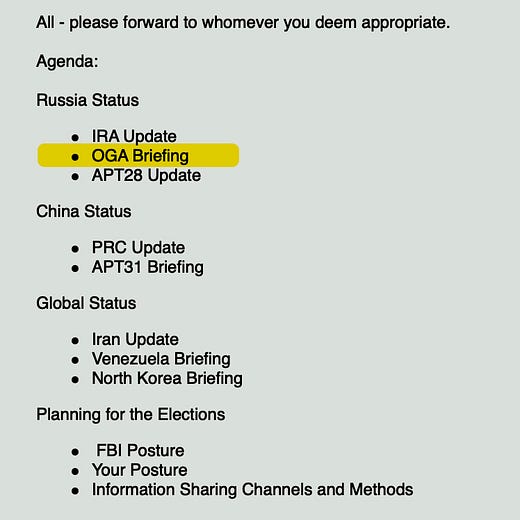
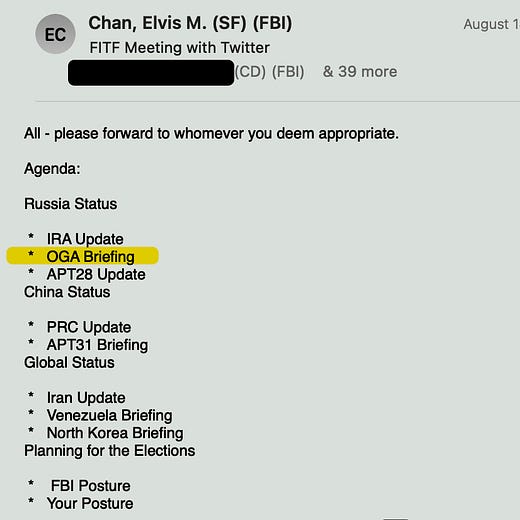
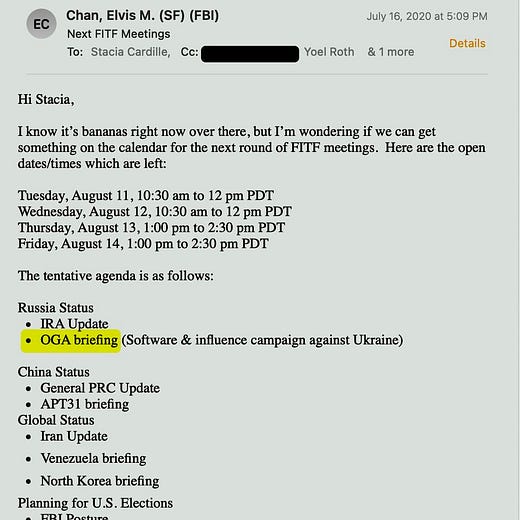
5:20 PM · Dec 24, 2022
29 Reposts · 109 Likes

Matt Taibbi@mtaibbi
20. Despite its official remit being “Foreign Influence,” the FITF and the SF FBI office became conduit for mountains of domestic moderation requests, from state governments, even local police:

5:20 PM · Dec 24, 2022
32 Reposts · 101 Likes

Matt Taibbi@mtaibbi
21. Many requests arrived via Teleporter, a one-way platform in which many communications were timed to vanish:

5:20 PM · Dec 24, 2022
28 Reposts · 90 Likes

Matt Taibbi@mtaibbi
22.Especially as the election approached in 2020, the FITF/FBI overwhelmed Twitter with requests, sending lists of hundreds of problem accounts:
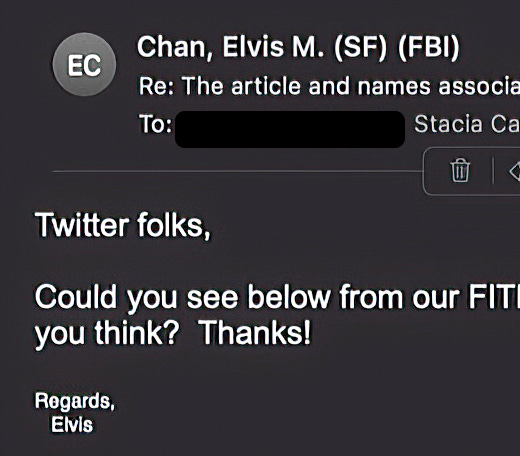
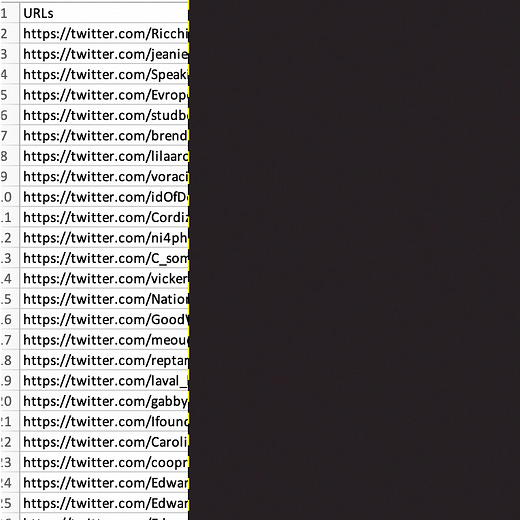
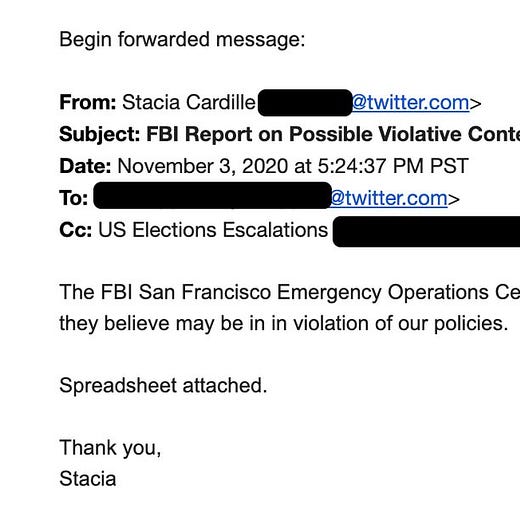
5:20 PM · Dec 24, 2022
36 Reposts · 92 Likes

Matt Taibbi@mtaibbi
23. Email after email came from the San Francisco office heading into the election, often adorned with an Excel attachment:

5:20 PM · Dec 24, 2022
33 Reposts · 83 Likes

Matt Taibbi@mtaibbi
24. There were so many government requests, Twitter employees had to improvise a system for prioritizing/triaging them:

5:20 PM · Dec 24, 2022
35 Reposts · 86 Likes

Matt Taibbi@mtaibbi
25. The FBI was clearly tailoring searches to Twitter’s policies. FBI complaints were almost always depicted somewhere as a “possible terms of service violation," even in the subject line:

5:20 PM · Dec 24, 2022
31 Reposts · 89 Likes

Matt Taibbi@mtaibbi
26. Twitter executives noticed the FBI appeared to be aasigning personnel to look for Twitter violations.
5:20 PM · Dec 24, 2022
38 Reposts · 95 Likes

Matt Taibbi@mtaibbi
27.“They have some folks in the Baltimore field office and at HQ that are just doing keyword searches for violations. This is probably the 10th request I have dealt with in the last 5 days,” remarked Cardille.

5:20 PM · Dec 24, 2022
33 Reposts · 89 Likes

Matt Taibbi@mtaibbi
28. Even ex-FBI lawyer Jim Baker agreed: “Odd that they are searching for violations of our policies.”

5:20 PM · Dec 24, 2022
33 Reposts · 93 Likes

Matt Taibbi@mtaibbi
29.The New York FBI office even sent requests for the “user IDs and handles” of a long list of accounts named in a Daily Beast article. Senior executives say they are “supportive” and “completely comfortable” doing so.
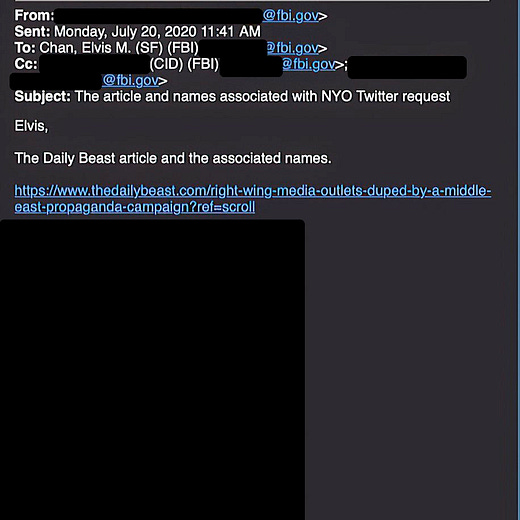
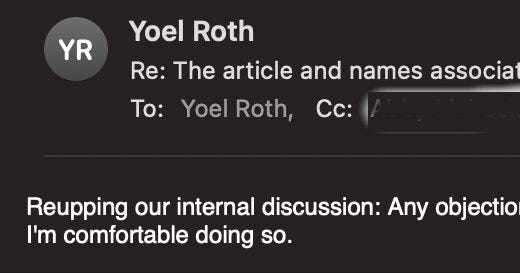
5:20 PM · Dec 24, 2022
37 Reposts · 83 Likes

Matt Taibbi@mtaibbi
30. It seemed to strike no one as strange that a “Foreign Influence” task force was forwarding thousands of mostly domestic reports, along with the DHS, about the fringiest material:

5:20 PM · Dec 24, 2022
37 Reposts · 99 Likes

Matt Taibbi@mtaibbi
31. “Foreign meddling” had been the ostensible justification for expanded moderation since platforms like Twitter were dragged to the Hill by the Senate in 2017:

5:20 PM · Dec 24, 2022
23 Reposts · 69 Likes

Matt Taibbi@mtaibbi
32. Yet behind the scenes, Twitter executives struggled against government claims of foreign interference supposedly occurring on their platform and others:

5:20 PM · Dec 24, 2022
22 Reposts · 72 Likes

Matt Taibbi@mtaibbi
33. The #TwitterFiles show execs under constant pressure to validate theories of foreign influence – and unable to find evidence for key assertions.
5:20 PM · Dec 24, 2022
29 Reposts · 83 Likes

Matt Taibbi@mtaibbi
34. “Found no links to Russia,” says one analyst, but suggests he could “brainstorm” to “find a stronger connection.”

5:20 PM · Dec 24, 2022
35 Reposts · 90 Likes

Matt Taibbi@mtaibbi
35. “Extremely tenuous circumstantial chance of being related,” says another.

5:20 PM · Dec 24, 2022
21 Reposts · 70 Likes

Matt Taibbi@mtaibbi
36. “No real matches using the info,” says former Trust and Safety chief Yoel Roth in another case, noting some links were “clearly Russian,” but another was a “house rental in South Carolina?”

5:20 PM · Dec 24, 2022
23 Reposts · 75 Likes

Matt Taibbi@mtaibbi
37. In another case, Roth concludes a series of Venezuelan pro-Maduro accounts are unrelated to Russia’s Internet Research Agency, because they’re too high-volume:

5:20 PM · Dec 24, 2022
23 Reposts · 74 Likes

Matt Taibbi@mtaibbi
38.The Venezuelans “were extremely high-volume tweeters… pretty uncharacteristic of a lot of the other IRA activity,” Roth says.
5:20 PM · Dec 24, 2022
21 Reposts · 78 Likes

Matt Taibbi@mtaibbi
39. In a key email, news that the State Department was making a wobbly public assertion of Russian influence led an exec – the same one with the “OGA” past - to make a damning admission:
5:20 PM · Dec 24, 2022
22 Reposts · 82 Likes

Matt Taibbi@mtaibbi
40. “Due to a lack of technical evidence on our end, I've generally left it be, waiting for more evidence,” he says. “Our window on that is closing, given that government partners are becoming more aggressive on attribution.”

5:20 PM · Dec 24, 2022
25 Reposts · 83 Likes

Matt Taibbi@mtaibbi
41. Translation: “more aggressive” “government partners” had closed Twitter’s “window” of independence.
5:20 PM · Dec 24, 2022
28 Reposts · 97 Likes

Matt Taibbi@mtaibbi
42. “Other Government Agencies” ended up sharing intelligence through the FBI and FITF not just with Twitter, but with Yahoo!, Twitch, Clouldfare, LinkedIn, even Wikimedia:

5:21 PM · Dec 24, 2022
42 Reposts · 105 Likes

Matt Taibbi@mtaibbi
43. Former CIA agent and whistleblower John Kiriakou believes he recognizes the formatting of these reports.
5:21 PM · Dec 24, 2022
25 Reposts · 103 Likes

Matt Taibbi@mtaibbi
44.“Looks right on to me,” Kiriakou says, noting that “what was cut off above [the “tearline”] was the originating CIA office and all the copied offices.”
5:21 PM · Dec 24, 2022
25 Reposts · 98 Likes

Matt Taibbi@mtaibbi
45. Many people wonder if Internet platforms receive direction from intelligence agencies about moderation of foreign policy news stories. It appears Twitter did, in some cases by way of the FITF/FBI.
5:21 PM · Dec 24, 2022
26 Reposts · 116 Likes

Matt Taibbi@mtaibbi
46. These reports are far more factually controversial than domestic counterparts.
5:21 PM · Dec 24, 2022
22 Reposts · 112 Likes

Matt Taibbi@mtaibbi
47. One intel report lists accounts tied to “Ukraine ‘neo-Nazi’ Propaganda.’” This includes assertions that Joe Biden helped orchestrate a coup in 2014 and “put his son on the board of Burisma.”
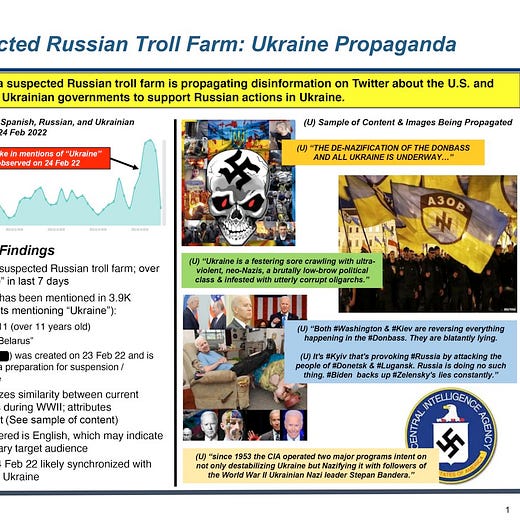
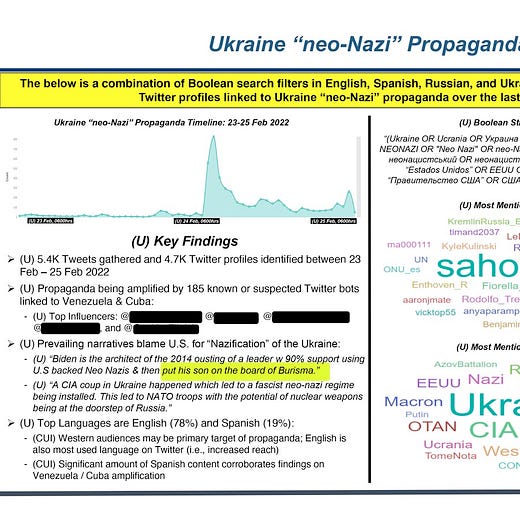
5:21 PM · Dec 24, 2022
39 Reposts · 144 Likes

Matt Taibbi@mtaibbi
48. Another report asserts a list of accounts accusing the “Biden administration” of “corruption” in vaccine distribution are part of a Russian influence campaign:

5:21 PM · Dec 24, 2022
36 Reposts · 122 Likes

Matt Taibbi@mtaibbi
49. Often intelligence came in the form of brief reports, followed by long lists of accounts simply deemed to be pro-Maduro, pro-Cuba, pro-Russia, etc. This one batch had over 1000 accounts marked for digital execution:

5:21 PM · Dec 24, 2022
32 Reposts · 111 Likes

Matt Taibbi@mtaibbi
50. One report says a site “documenting purported rights abuses committed by Ukrainians” is directed by Russian agents:

5:21 PM · Dec 24, 2022
34 Reposts · 116 Likes

Matt Taibbi@mtaibbi
51. Intel about the shady origin of these accounts might be true. But so might at least some of the information in them – about neo-Nazis, rights abuses in Donbas, even about our own government. Should we block such material?
5:21 PM · Dec 24, 2022
28 Reposts · 117 Likes

Matt Taibbi@mtaibbi
52. This is a difficult speech dilemma. Should the government be allowed to try to prevent Americans (and others) from seeing pro-Maduro or anti-Ukrainian accounts?
5:21 PM · Dec 24, 2022
32 Reposts · 135 Likes

Matt Taibbi@mtaibbi
53. Often intel reports are just long lists of newspapers, tweets or YouTube videos guilty of “anti-Ukraine narratives”:
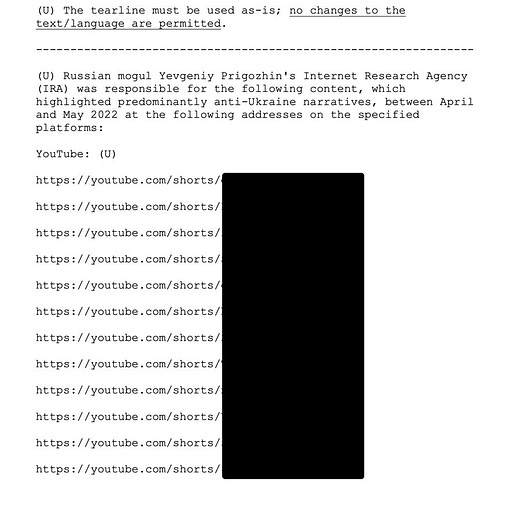
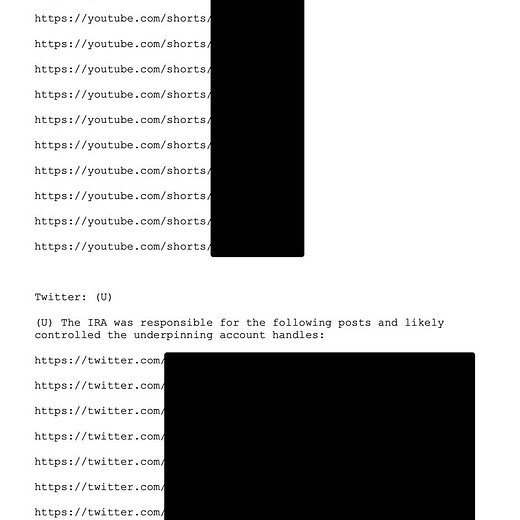
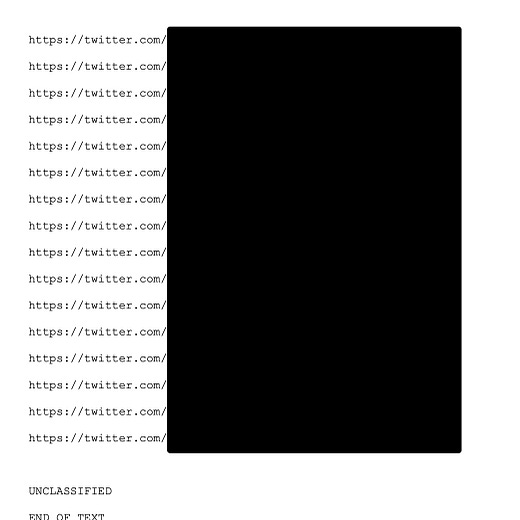
5:21 PM · Dec 24, 2022
36 Reposts · 136 Likes

Matt Taibbi@mtaibbi
54. Sometimes - not always -Twitter and YouTube blocked the accounts. But now we know for sure what Roth meant by “the Bureau (and by extension the IC).”

5:21 PM · Dec 24, 2022
43 Reposts · 155 Likes

Matt Taibbi@mtaibbi
55. The line between “misinformation” and “distorting propaganda” is thin. Are we comfortable with so many companies receiving so many reports from a “more aggressive” government?
5:21 PM · Dec 24, 2022
46 Reposts · 196 Likes

Matt Taibbi@mtaibbi
56.The CIA has yet to comment on the nature of its relationship to tech companies like Twitter. Twitter had no input into anything I did or wrote. The searches were carried out by third parties, so what I saw could be limited.
5:21 PM · Dec 24, 2022
73 Reposts · 335 Likes

Matt Taibbi@mtaibbi
Watch @bariweiss, @ShellenbergerMD, @lhfang, and this space for more, on issues ranging from Covid-19 to Twitter's relationship to congress, and more.
5:21 PM · Dec 24, 2022
95 Reposts · 415 Likes
Part X

David Zweig@davidzweig
1. THREAD:
THE TWITTER FILES: HOW TWITTER RIGGED THE COVID DEBATE
– By censoring info that was true but inconvenient to U.S. govt. policy
– By discrediting doctors and other experts who disagreed
– By suppressing ordinary users, including some sharing the CDC’s *own data*
2:10 PM · Dec 26, 2022
19.5K Reposts · 43.6K Likes

David Zweig@davidzweig
2. So far the Twitter Files have focused on evidence of Twitter’s secret blacklists; how the company functioned as a kind of subsidiary of the FBI; and how execs rewrote the platform’s rules to accommodate their own political desires.
2:14 PM · Dec 26, 2022
1.78K Reposts · 10.9K Likes

David Zweig@davidzweig
3. What we have yet to cover is Covid. This reporting, for The Free Press, @TheFP, is one piece of that important story.
2:16 PM · Dec 26, 2022
1.33K Reposts · 9.6K Likes

David Zweig@davidzweig
4. The United States government pressured Twitter and other social media platforms to elevate certain content and suppress other content about Covid-19.
2:18 PM · Dec 26, 2022
2.51K Reposts · 11.3K Likes

David Zweig@davidzweig
5. Internal files at Twitter that I viewed while on assignment for @TheFP showed that both the Trump and Biden administrations directly pressed Twitter executives to moderate the platform’s pandemic content according to their wishes.
2:21 PM · Dec 26, 2022
1.77K Reposts · 9.43K Likes

David Zweig@davidzweig
6. At the onset of the pandemic, according to meeting notes, the Trump admin was especially concerned about panic buying. They came looking for “help from the tech companies to combat misinformation” about “runs on grocery stores.” But . . . there were runs on grocery stores.

2:23 PM · Dec 26, 2022
1.26K Reposts · 7.99K Likes

David Zweig@davidzweig
7. It wasn’t just Twitter. The meetings with the Trump White House were also attended by Google, Facebook, Microsoft and others.

2:24 PM · Dec 26, 2022
1.4K Reposts · 7.9K Likes

David Zweig@davidzweig
8. When the Biden admin took over, one of their first meeting requests with Twitter executives was on Covid. The focus was on “anti-vaxxer accounts.” Especially Alex Berenson:

2:26 PM · Dec 26, 2022
2.22K Reposts · 9.63K Likes

David Zweig@davidzweig
9. In the summer of 2021, president Biden said social media companies were “killing people” for allowing vaccine misinformation. Berenson was suspended hours after Biden’s comments, and kicked off the platform the following month.
2:27 PM · Dec 26, 2022
1.67K Reposts · 8.64K Likes

David Zweig@davidzweig
10. Berenson sued (and then settled with) Twitter. In the legal process Twitter was compelled to release certain internal communications, which showed direct White House pressure on the company to take action on Berenson.
alexberenson.substack.com/p/jesse-jackso…

2:29 PM · Dec 26, 2022
1.78K Reposts · 8.59K Likes

David Zweig@davidzweig
11. A December 2022 summary of meetings with the White House by Lauren Culbertson, Twitter’s Head of U.S. Public Policy, adds new evidence of the White House’s pressure campaign, and cements that it repeatedly attempted to directly influence the platform.
2:31 PM · Dec 26, 2022
1.29K Reposts · 7.45K Likes

David Zweig@davidzweig
12. Culbertson wrote that the Biden team was “very angry” that Twitter had not been more aggressive in deplatforming multiple accounts. They wanted Twitter to do more.

2:32 PM · Dec 26, 2022
1.72K Reposts · 8.01K Likes

David Zweig@davidzweig
13. Twitter executives did not fully capitulate to the Biden team’s wishes. An extensive review of internal communications at the company revealed employees often debating moderation cases in great detail, and with more care than was shown by the government toward free speech.
2:33 PM · Dec 26, 2022
1.1K Reposts · 7.37K Likes

David Zweig@davidzweig
14. But Twitter did suppress views—many from doctors and scientific experts—that conflicted with the official positions of the White House. As a result, legitimate findings and questions that would have expanded the public debate went missing.
2:34 PM · Dec 26, 2022
2.46K Reposts · 9.85K Likes

David Zweig@davidzweig
15. There were three serious problems with Twitter’s process:
First, much of the content moderation was conducted by bots, trained on machine learning and AI – impressive in their engineering, yet still too crude for such nuanced work.
2:35 PM · Dec 26, 2022
1.22K Reposts · 7.34K Likes

David Zweig@davidzweig
16. Second, contractors, in places like the Philippines, also moderated content. They were given decision trees to aid in the process, but tasking non experts to adjudicate tweets on complex topics like myocarditis and mask efficacy data was destined for a significant error rate

2:37 PM · Dec 26, 2022
1.52K Reposts · 7.83K Likes

David Zweig@davidzweig
17 Third, most importantly, the buck stopped with higher level employees at Twitter who chose the inputs for the bots and decision trees, and subjectively decided escalated cases and suspensions. As it is with all people and institutions, there was individual and collective bias
2:38 PM · Dec 26, 2022
1.29K Reposts · 7.35K Likes

David Zweig@davidzweig
18. With Covid, this bias bent heavily toward establishment dogmas.
2:39 PM · Dec 26, 2022
1.25K Reposts · 7.48K Likes

David Zweig@davidzweig
19. Inevitably, dissident yet legitimate content was labeled as misinformation, and the accounts of doctors and others were suspended both for tweeting opinions and demonstrably true information.
2:41 PM · Dec 26, 2022
2.07K Reposts · 8.65K Likes

David Zweig@davidzweig
20. Exhibit A: Dr. Martin Kulldorff, an epidemiologist at Harvard Medical School, tweeted views at odds with US public health authorities and the American left, the political affiliation of nearly the entire staff at Twitter.

2:42 PM · Dec 26, 2022
2.1K Reposts · 9.15K Likes

David Zweig@davidzweig
21. Internal emails show an “intent to action” by a moderator, saying Kulldorff’s tweet violated the company’s Covid-19 misinformation policy and claimed he shared “false information.”

2:43 PM · Dec 26, 2022
1.81K Reposts · 7.88K Likes

David Zweig@davidzweig
22. But Kulldorff’s statement was an expert’s opinion—one which also happened to be in line with vaccine policies in numerous other countries. Yet it was deemed “false information” by Twitter moderators merely because it differed from CDC guidelines.
2:44 PM · Dec 26, 2022
1.89K Reposts · 9.1K Likes

David Zweig@davidzweig
23. After Twitter took action, Kulldorff’s tweet was slapped with a “Misleading” label and all replies and likes were shut off, throttling the tweet’s ability to be seen and shared by many people, the ostensible core function of the platform:

2:45 PM · Dec 26, 2022
1.56K Reposts · 7.68K Likes

David Zweig@davidzweig
24. In my review of internal files, I found countless instances of tweets labeled as “misleading” or taken down entirely, sometimes triggering account suspensions, simply because they veered from CDC guidance or differed from establishment views.
2:46 PM · Dec 26, 2022
1.47K Reposts · 7.39K Likes

David Zweig@davidzweig
25. A tweet by @KelleyKga, a self-proclaimed public health fact checker, with 18K followers, was flagged as “Misleading,” and replies and likes disabled, even though it displayed the CDC’s *own data.*

2:47 PM · Dec 26, 2022
1.83K Reposts · 7.97K Likes

David Zweig@davidzweig
26. Internal records showed that a bot had flagged the tweet, and that it received many “tattles” (what the system amusingly called reports from users). That triggered a manual review by a human who– despite the tweet showing actual CDC data–nevertheless labeled it “Misleading”
2:48 PM · Dec 26, 2022
1.18K Reposts · 6.86K Likes

David Zweig@davidzweig
27. Tellingly, the tweet by @KelleyKga that was labeled “Misleading” was a reply to a tweet that contained actual misinformation.
Covid has never been the leading cause of death from disease in children. Yet that tweet remains on the platform, and without a “misleading” label.

2:50 PM · Dec 26, 2022
1.77K Reposts · 7.76K Likes

David Zweig@davidzweig
28. Whether by humans or algorithms, content that was contrarian but true was still subject to getting flagged or suppressed
This tweet was labeled “Misleading,” even though the owner of this account, @_euzebiusz_, a physician, was referring to the results of a published study

2:52 PM · Dec 26, 2022
1.79K Reposts · 7.28K Likes

David Zweig@davidzweig
29. Andrew Bostom, a Rhode Island physician, was permanently suspended from Twitter after receiving multiple strikes for misinformation. One of his strikes was for a tweet referring to the results from a peer reviewed study on mRNA vaccines.

2:53 PM · Dec 26, 2022
1.67K Reposts · 7.18K Likes

David Zweig@davidzweig
30. A review of Twitter log files revealed that an internal audit, conducted after Bostom’s attorney contacted Twitter, found that only 1 of Bostom’s 5 violations were valid.

2:54 PM · Dec 26, 2022
937 Reposts · 5.74K Likes

David Zweig@davidzweig
31. The one Bostom tweet found to still be in violation cited data that was legitimate but inconvenient to the public health establishment’s narrative about the risks of flu versus Covid in children.

2:54 PM · Dec 26, 2022
1.53K Reposts · 7.07K Likes

David Zweig@davidzweig
32. That this tweet was not only flagged by a bot, but its violation manually affirmed by a staff member is telling of both the algorithmic and human bias at play. Bostom’s account was suspended for months and was finally restored on Christmas Day.
2:55 PM · Dec 26, 2022
786 Reposts · 4.46K Likes

David Zweig@davidzweig
33. Another example of human bias run amok was the reaction to this tweet by Trump. Many Trump tweets led to extensive internal debates, and this one was no different.

2:56 PM · Dec 26, 2022
991 Reposts · 4.71K Likes

David Zweig@davidzweig
34. In a surreal exchange, Jim Baker, at the time Twitter’s Deputy General Counsel, asks why telling people to not be afraid wasn’t a violation of Twitter’s Covid-19 misinformation policy.

2:57 PM · Dec 26, 2022
1.74K Reposts · 6.28K Likes

David Zweig@davidzweig
35. Yoel Roth, Twitter’s former head of Trust & Safety, had to explain that optimism wasn’t misinformation.

2:58 PM · Dec 26, 2022
1.07K Reposts · 5K Likes

David Zweig@davidzweig
36. Remember @KelleyKga with the CDC data tweet? Twitter’s response to her is clarifying: “we will prioritize review and labeling of content that could lead to increased exposure or transmission.”

3:00 PM · Dec 26, 2022
646 Reposts · 3.81K Likes

David Zweig@davidzweig
37. Twitter made a decision, via the political leanings of senior staff, and govt pressure, that the public health authorities’ approach to the pandemic – prioritizing mitigation over other concerns – was “The Science” . . .
3:01 PM · Dec 26, 2022
1.13K Reposts · 4.91K Likes

David Zweig@davidzweig
38. Information that challenged that view, such as showing harms of vaccines, or that could be perceived as downplaying the risks of Covid, especially to children, was subject to moderation, and even suppression. No matter whether such views were correct or adopted abroad.
3:02 PM · Dec 26, 2022
1.13K Reposts · 4.92K Likes

David Zweig@davidzweig
39. What might this pandemic and its aftermath have looked like if there had been a more open debate on Twitter and other social media platforms—not to mention the mainstream press—about the origins of Covid, about lockdowns, about the true risks of Covid in kids, and much more?
3:03 PM · Dec 26, 2022
1.59K Reposts · 6.78K Likes

David Zweig@davidzweig
40. Thanks to @ShellenbergerMD, @lwoodhouse, @lhfang and the team @TheFP for their help reporting this story.
3:04 PM · Dec 26, 2022
631 Reposts · 5.39K Likes
Part XI

Matt Taibbi@mtaibbi
1.THREAD: The Twitter Files
How Twitter Let the Intelligence Community In
8:27 PM · Jan 3, 2023
900 Reposts · 1.51K Likes

Matt Taibbi@mtaibbi
2.In August 2017, when Facebook decided to suspend 300 accounts with “suspected Russian origin,” Twitter wasn’t worried. Its leaders were sure they didn’t have a Russia problem.
8:27 PM · Jan 3, 2023
115 Reposts · 465 Likes

Matt Taibbi@mtaibbi
3.“We did not see a big correlation.”
“No larger patterns.”
“FB may take action on hundreds of accounts, and we may take action on ~25.”

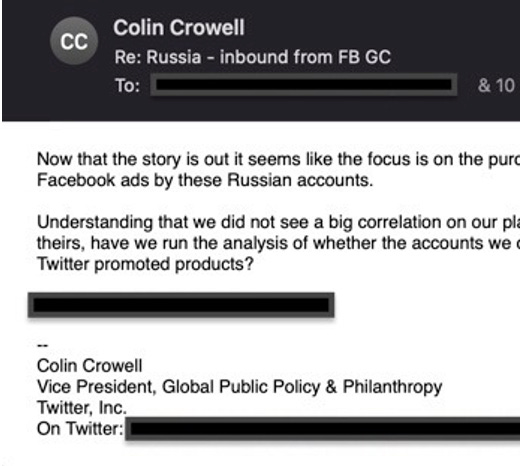

8:27 PM · Jan 3, 2023
97 Reposts · 400 Likes

Matt Taibbi@mtaibbi
4.“KEEP THE FOCUS ON FB”: Twitter was so sure they had no Russia problem, execs agreed the best PR strategy was to say nothing on record, and quietly hurl reporters at Facebook:


8:27 PM · Jan 3, 2023
88 Reposts · 364 Likes

Matt Taibbi@mtaibbi
5.“Twitter is not the focus of inquiry into Russian election meddling right now - the spotlight is on FB,” wrote Public Policy VP Colin Crowell:

8:27 PM · Jan 3, 2023
82 Reposts · 344 Likes

Matt Taibbi@mtaibbi
6.In September, 2017, after a cursory review, Twitter informed the Senate it suspended 22 possible Russian accounts, and 179 others with “possible links” to those accounts, amid a larger set of roughly 2700 suspects manually examined.
8:27 PM · Jan 3, 2023
77 Reposts · 330 Likes

Matt Taibbi@mtaibbi
7.Receiving these meager results, a furious Senator Mark Warner of Virginia – ranking Democrat on the Intelligence Committee – held an immediate press conference to denounce Twitter’s report as “frankly inadequate on every level.”
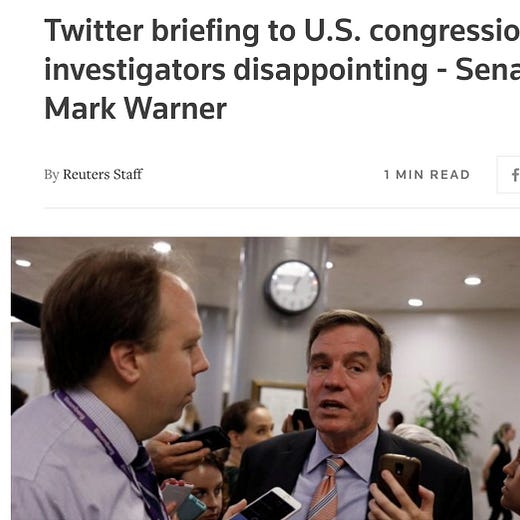
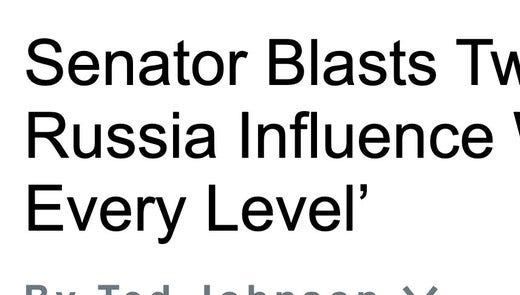
8:27 PM · Jan 3, 2023
67 Reposts · 281 Likes

Matt Taibbi@mtaibbi
8.“#Irony,” mused Crowell the day after Warner’s presser, after receiving an e-circular from Warner’s re-election campaign, asking for “$5 or whatever you can spare.”
“LOL,” replied General Counsel Sean Edgett.

8:27 PM · Jan 3, 2023
55 Reposts · 248 Likes

Matt Taibbi@mtaibbi
9.“KEEP PRODUCING MATERIAL” After meeting with congressional leaders, Crowell wrote: “Warner has political incentive to keep this issue at top of the news, maintain pressure on us and rest of industry to keep producing material for them.”

8:27 PM · Jan 3, 2023
66 Reposts · 255 Likes

Matt Taibbi@mtaibbi
10.“TAKING THEIR CUES FROM HILLARY CLINTON” Crowell added Dems were taking cues from Hillary Clinton, who that week said: “It’s time for Twitter to stop dragging its heels and live up to the fact that its platform is being used as a tool for cyber-warfare.”
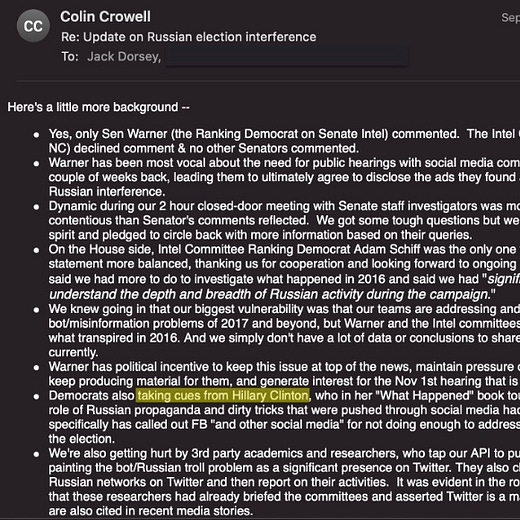
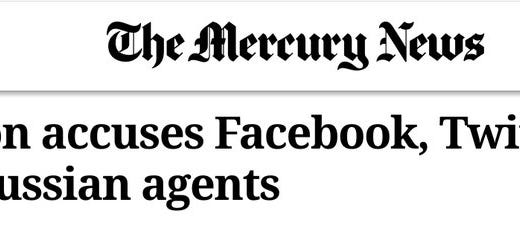
8:27 PM · Jan 3, 2023
78 Reposts · 261 Likes

Matt Taibbi@mtaibbi
11. In growing anxiety over its PR problems, Twitter formed a “Russia Task Force” to proactively self-investigate.

8:27 PM · Jan 3, 2023
50 Reposts · 212 Likes

Matt Taibbi@mtaibbi
12.The “Russia Task Force” started mainly with data shared from counterparts at Facebook, centered around accounts supposedly tied to Russia’s Internet Research Agency (IRA). But the search for Russian perfidy was a dud:

8:27 PM · Jan 3, 2023
48 Reposts · 203 Likes

Matt Taibbi@mtaibbi
13. OCT 13 2017: “No evidence of a coordinated approach, all of the accounts found seem to be lone-wolf type activity (different timing, spend, targeting, <$10k in ad spend).”

8:27 PM · Jan 3, 2023
47 Reposts · 197 Likes

Matt Taibbi@mtaibbi
14.OCT 18 2017: “First round of RU investigation… 15 high risk accounts, 3 of which have connections with Russia, although 2 are RT.”

8:27 PM · Jan 3, 2023
45 Reposts · 198 Likes

Matt Taibbi@mtaibbi
15.OCT 20 2017: “Built new version of the model that is lower precision but higher recall which allows to catch more items. We aren’t seeing substantially more suspicious accounts. We expect to find ~20 with a small amount of spend.”

8:27 PM · Jan 3, 2023
43 Reposts · 190 Likes

Matt Taibbi@mtaibbi
16.OCT 23 2017: “Finished with investigation… 2500 full manual account reviews, we think this is exhaustive… 32 suspicious accounts and only 17 of those are connected with Russia, only 2 of those have significant spend one of which is Russia Today...remaining <$10k in spend.”

8:27 PM · Jan 3, 2023
51 Reposts · 197 Likes

Matt Taibbi@mtaibbi
17.Twitter’s search finding “only 2” significant accounts, “one of which is Russia Today,” was based on the same data that later inspired panic headlines like “Russian Influence Reached 126 Million Through Facebook Alone”:

8:27 PM · Jan 3, 2023
54 Reposts · 199 Likes

Matt Taibbi@mtaibbi
18.The failure of the “Russia task force” to produce “material” worsened the company’s PR crisis.
8:27 PM · Jan 3, 2023
46 Reposts · 200 Likes

Matt Taibbi@mtaibbi
19.In the weeks after Warner’s presser, a torrent of stories sourced to the Intel Committee poured into the news, an example being Politico’s October 13, “Twitter deleted data potentially crucial to Russia probes.”

8:27 PM · Jan 3, 2023
52 Reposts · 191 Likes

Matt Taibbi@mtaibbi
20.“Were Twitter a contractor for the FSB… they could not have built a more effective disinformation platform,” Johns Hopkins Professor (and Intel Committee “expert”) Thomas Rid told Politico.

8:27 PM · Jan 3, 2023
59 Reposts · 211 Likes

Matt Taibbi@mtaibbi
21.As congress threatened costly legislation, and Twitter began was subject to more bad press fueled by the committees, the company changed its tune about the smallness of its Russia problem.
8:27 PM · Jan 3, 2023
68 Reposts · 291 Likes

Matt Taibbi@mtaibbi
22.“Hi guys.. Just passing along for awareness the writeup here from the WashPost today on potential legislation (or new FEC regulations) that may affect our political advertising,” wrote Crowell.

8:27 PM · Jan 3, 2023
86 Reposts · 314 Likes

Matt Taibbi@mtaibbi
23. In Washington weeks after the first briefing, Twitter leaders were told by Senate staff that “Sen Warner feels like tech industry was in denial for months.” Added an Intel staffer: “Big interest in Politico article about deleted accounts."


8:38 PM · Jan 3, 2023
17 Reposts · 36 Likes

Matt Taibbi@mtaibbi
24.Twitter “pledged to work with them on their desire to legislate”:

8:39 PM · Jan 3, 2023
56 Reposts · 165 Likes

Matt Taibbi@mtaibbi
25.“Knowing that our ads policy and product changes are an effort to anticipate congressional oversight, I wanted to share some relevant highlights of the legislation Senators Warner, Klobuchar and McCain will be introducing,” wrote Policy Director Carlos Monje soon after.

8:39 PM · Jan 3, 2023
34 Reposts · 99 Likes

Matt Taibbi@mtaibbi
26.“THE COMMITTEES APPEAR TO HAVE LEAKED” Even as Twitter prepared to change its ads policy and remove RT and Sputnik to placate Washington, congress turned the heat up more, apparently leaking the larger, base list of 2700 accounts.

8:40 PM · Jan 3, 2023
33 Reposts · 58 Likes

Matt Taibbi@mtaibbi
27.Reporters from all over started to call Twitter about Russia links. Buzzfeed, working with the University of Sheffield, claimed to find a “new network” on Twitter that had “close connections to… Russian-linked bot accounts.”

8:40 PM · Jan 3, 2023
66 Reposts · 182 Likes

Matt Taibbi@mtaibbi
28.“IT WILL ONLY EMBOLDEN THEM.” Twitter internally did not want to endorse the Buzzfeed/Sheffield findings:
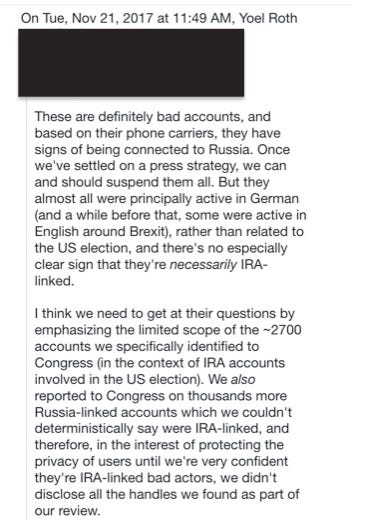


8:41 PM · Jan 3, 2023
43 Reposts · 123 Likes

Matt Taibbi@mtaibbi
29. “SENATE INTEL COMMITTEE IS ASKING… POSSIBLE TO WHIP SOMETHING TOGETHER?” Still, when the Buzzfeed piece came out, the Senate asked for “a write up of what happened.” Twitter was soon apologizing for the same accounts they’d initially told the Senate were not a problem.

8:42 PM · Jan 3, 2023
39 Reposts · 98 Likes

Matt Taibbi@mtaibbi
30.“REPORTERS NOW KNOW THIS IS A MODEL THAT WORKS”
This cycle – threatened legislation, wedded to scare headlines pushed by congressional/intel sources, followed by Twitter caving to moderation asks – would later be formalized in partnerships with federal law enforcement.

8:43 PM · Jan 3, 2023
34 Reposts · 82 Likes

Matt Taibbi@mtaibbi
31.Twitter soon settled on its future posture.
In public, it removed content “at our sole discretion.”
Privately, they would “off-board” anything “identified by the U.S.. intelligence community as a state-sponsored entity conducting cyber-operations.”

8:45 PM · Jan 3, 2023
70 Reposts · 178 Likes

Matt Taibbi@mtaibbi
32.Twitter let the “USIC” into its moderation process. It would not leave.
Wrote Crowell, in an email to the company’s leaders:
“We will not be reverting to the status quo.”

8:46 PM · Jan 3, 2023
39 Reposts · 113 Likes

Matt Taibbi@mtaibbi
33.For more on the #TwitterFiles, check out @bariweiss, @ShellenbergerMD, @lhfang, and @davidzweig.
Watch this space shortly for another thread…
8:47 PM · Jan 3, 2023
73 Reposts · 278 Likes
Part XII

Matt Taibbi@mtaibbi
1.THREAD: The Twitter Files
Twitter and the FBI “Belly Button”

9:54 PM · Jan 3, 2023
978 Reposts · 1.72K Likes

Matt Taibbi@mtaibbi
2.By 2020, Twitter was struggling with the problem of public and private agencies bypassing them and going straight to the media with lists of suspect accounts.
9:54 PM · Jan 3, 2023
131 Reposts · 584 Likes

Matt Taibbi@mtaibbi
3.In February, 2020, as COVID broke out, the Global Engagement Center – a fledgling analytic/intelligence arms of the State Department – went to the media with a report called, “Russian Disinformation Apparatus Taking Advantage of Coronavirus Concerns.”

9:54 PM · Jan 3, 2023
137 Reposts · 548 Likes

Matt Taibbi@mtaibbi
4.The GEC flagged accounts as “Russian personas and proxies” based on criteria like, “Describing the Coronavirus as an engineered bioweapon,” blaming “research conducted at the Wuhan institute,” and “attributing the appearance of the virus to the CIA.”

9:54 PM · Jan 3, 2023
147 Reposts · 539 Likes

Matt Taibbi@mtaibbi
5.State also flagged accounts that retweeted news that Twitter banned the popular U.S. ZeroHedge, claiming the episode “led to another flurry of disinformation narratives.” ZH had done reports speculating that the virus had lab origin.

9:54 PM · Jan 3, 2023
133 Reposts · 512 Likes

Matt Taibbi@mtaibbi
6.The GEC still led directly to news stories like the AFP’s headline, “Russia-linked disinformation campaign led to coronavirus alarm, US says,” and a Politico story about how “Russian, Chinese, Iranian Disinformation Narratives Echo One Another.”
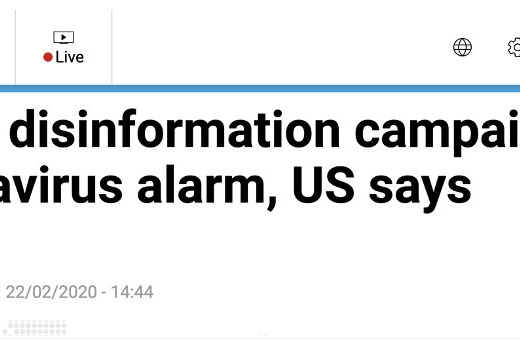
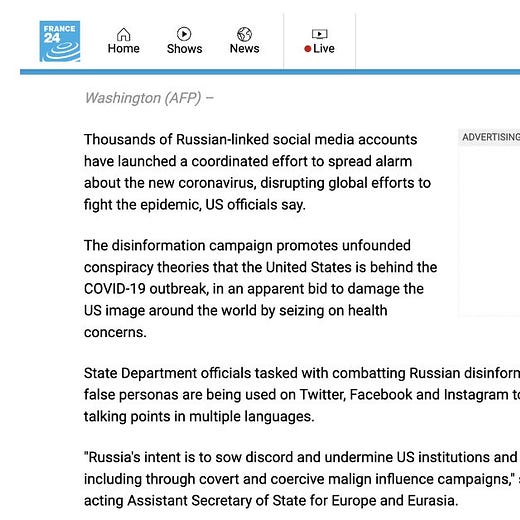
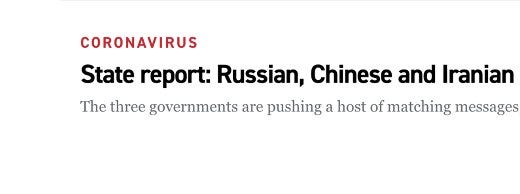

9:54 PM · Jan 3, 2023
96 Reposts · 429 Likes

Matt Taibbi@mtaibbi
7.“YOU HAVEN’T MADE A RUSSIA ATTRIBUTION IN SOME TIME” When Clemson’s Media Forensics Hub complained Twitter hadn’t “made a Russia attribution” in some time, Trust and Safety chief Yoel Roth said it was “revelatory of their motives.”
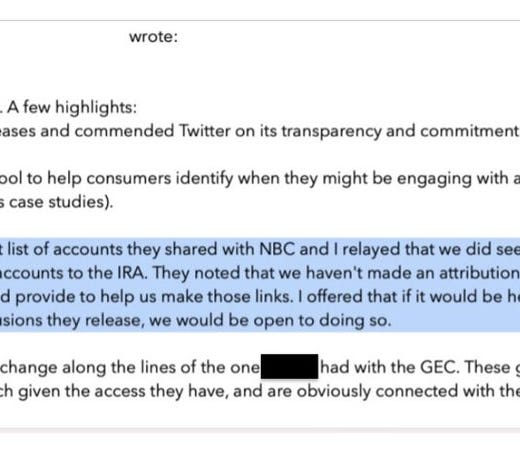

9:54 PM · Jan 3, 2023
106 Reposts · 438 Likes

Matt Taibbi@mtaibbi
8.“WE’RE HAPPY TO WORK DIRECTLY WITH YOU ON THIS, INSTEAD OF NBC.” Roth tried in vain to convince outsider researchers like the Clemson lab to check with them before pushing stories about foreign interference to media.

9:54 PM · Jan 3, 2023
112 Reposts · 443 Likes

Matt Taibbi@mtaibbi
9.Twitter was also trying to reduce the number of agencies with access to Roth. “If these folks are like House Homeland Committee and DHS, once we give them a direct contact with Yoel, they will want to come back to him again and again,” said policy director Carlos Monje.

9:54 PM · Jan 3, 2023
99 Reposts · 401 Likes

Matt Taibbi@mtaibbi
10.When the State Department/GEC – remember this was 2020, during the Trump administration – wanted to publicize a list of 5,500 accounts it claimed would “amplify Chinese propaganda and disinformation” about COVID, Twitter analysts were beside themselves.
9:54 PM · Jan 3, 2023
85 Reposts · 402 Likes

Matt Taibbi@mtaibbi
11.The GEC report appeared based on DHS data circulated earlier that week, and included accounts that followed “two or more” Chinese diplomatic accounts. They reportedly ended up with a list “nearly 250,000” names long, and included Canadian officials and a CNN account:

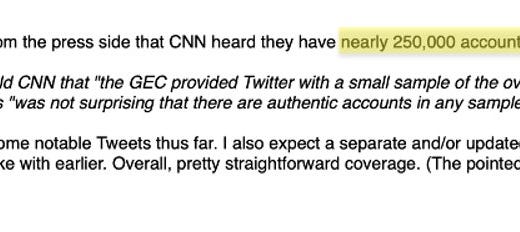
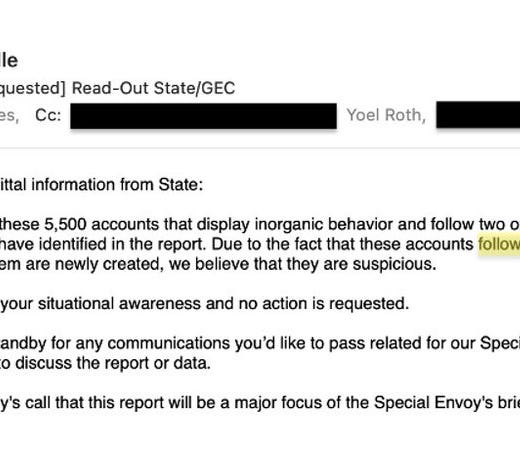
9:54 PM · Jan 3, 2023
83 Reposts · 363 Likes

Matt Taibbi@mtaibbi
12.Roth saw GEC’s move as an attempt by the GEC to use intel from other agencies to “insert themselves” into the content moderation club that included Twitter, Facebook, the FBI, DHS, and others:

9:54 PM · Jan 3, 2023
46 Reposts · 200 Likes

Matt Taibbi@mtaibbi
13.The GEC was soon agreeing to loop in Twitter before going public, but they were using a technique that had boxed in Twitter before. “The delta between when they share material and when they go to the press continues to be problematic,” wrote one comms official.

9:54 PM · Jan 3, 2023
39 Reposts · 193 Likes

Matt Taibbi@mtaibbi
14.The episode led to a rare public disagreement between Twitter and state officials:
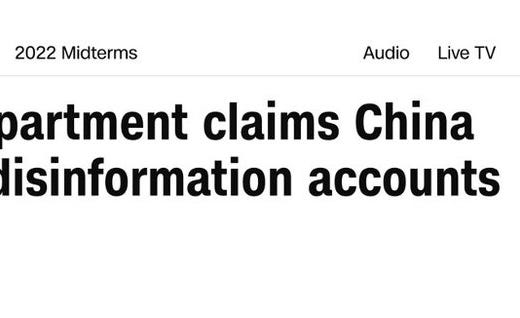
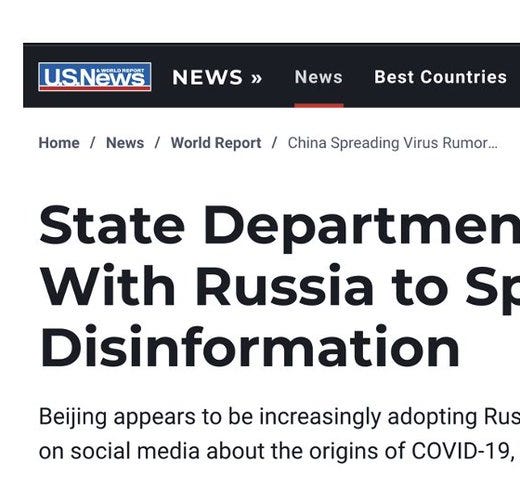
9:54 PM · Jan 3, 2023
37 Reposts · 191 Likes

Matt Taibbi@mtaibbi
15.“IT MAKES SENSE TO PUSH BACK ON GEC PARTICIPATION IN THIS FORUM” When the FBI informed Twitter the GEC wanted to be included in the regular “industry call” between companies like Twitter and Facebook and the DHS and FBI, Twitter leaders balked at first.

9:54 PM · Jan 3, 2023
39 Reposts · 188 Likes

Matt Taibbi@mtaibbi
16.Facebook, Google, and Twitter executives were united in opposition to GEC’s inclusion, with ostensible reasons including, “The GEC’s mandate for offensive IO to promote American interests.”

9:54 PM · Jan 3, 2023
41 Reposts · 191 Likes

Matt Taibbi@mtaibbi
17.A deeper reason was a perception that unlike the DHS and FBI, which were “apolitical,” as Roth put it, the GEC was “political,” which in Twitter-ese appeared to be partisan code.
“I think they thought the FBI was less Trumpy,” is how one former DOD official put it.

9:54 PM · Jan 3, 2023
39 Reposts · 181 Likes

Matt Taibbi@mtaibbi
18.After spending years rolling over for Democratic Party requests for “action” on “Russia-linked” accounts, Twitter was suddenly playing tough. Why? Because, as Roth put it, it would pose “major risks” to bring the GEC in, “especially as the election heats up.”

9:54 PM · Jan 3, 2023
42 Reposts · 177 Likes

Matt Taibbi@mtaibbi
19.When senior lawyer Stacia Cardille tried to argue against the GEC’s inclusion to the FBI, the words resonated “with Elvis, not Laura,” i.e. with agent Elvis Chan, not Foreign Influence Task Force (FITF) unit chief Laura Dehmlow:

9:54 PM · Jan 3, 2023
38 Reposts · 170 Likes

Matt Taibbi@mtaibbi
20.Eventually the FBI argued, first to Facebook, for a compromise solution: other USG agencies could participate in the “industry” calls, but the FBI and DHS would act as sole “conduits.”

9:54 PM · Jan 3, 2023
40 Reposts · 170 Likes

Matt Taibbi@mtaibbi
21.Roth reached out to Chan with concerns about letting the “press-happy” GEC in, expressing hope they could keep the “circle of trust small.”

9:54 PM · Jan 3, 2023
41 Reposts · 175 Likes

Matt Taibbi@mtaibbi
22."STATE... NSA, and CIA" Chan reassured him it would be a “one-way” channel, and “State/GEC, NSA, and CIA have expressed interest in being allowed on in listen mode only.”

9:54 PM · Jan 3, 2023
49 Reposts · 171 Likes

Matt Taibbi@mtaibbi
23."BELLY BUTTON" “We can give you everything we’re seeing from the FBI and USIC agencies,” Chan explained, but the DHS agency CISA “will know what’s going on in each state.” He went on to ask if industry could “rely on the FBI to be the belly button of the USG."

9:54 PM · Jan 3, 2023
50 Reposts · 172 Likes

Matt Taibbi@mtaibbi
24.They eventually settled on an industry call via Signal. In an impressive display of operational security, Chan circulated private numbers of each company’s chief moderation officer in a Word Doc marked “Signal Phone Numbers,” subject-lined, “List of Numbers.”

9:54 PM · Jan 3, 2023
47 Reposts · 182 Likes

Matt Taibbi@mtaibbi
25.Twitter was taking requests from every conceivable government body, beginning with the Senate Intel Committee (SSCI), which seemed to need reassurance Twitter was taking FBI direction. Execs rushed to tell “Team SSCI” they zapped five accounts on an FBI tip:
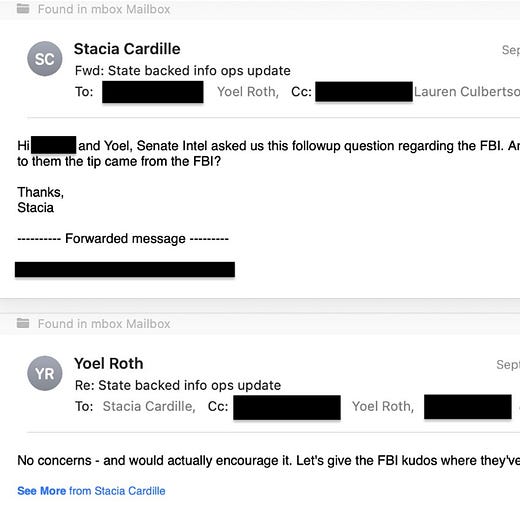
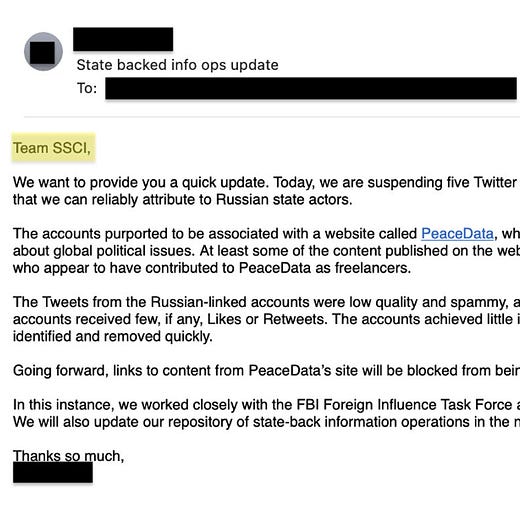
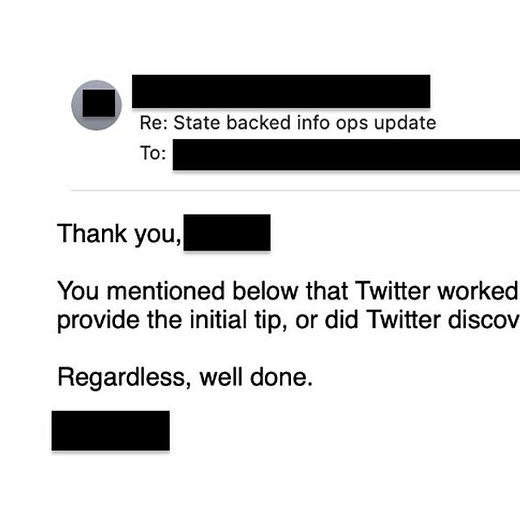
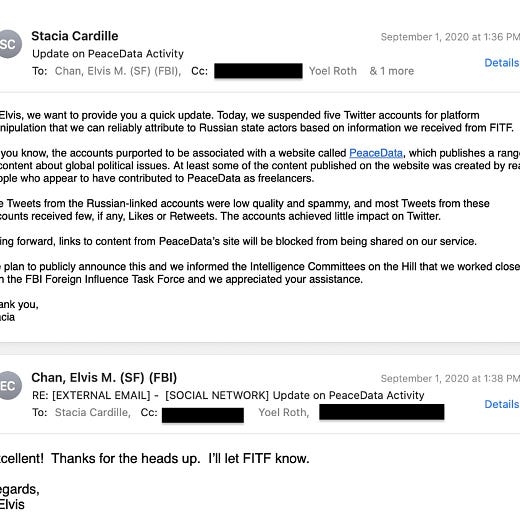
9:54 PM · Jan 3, 2023
56 Reposts · 182 Likes

Matt Taibbi@mtaibbi
26.Requests arrived and were escalated from all over: from Treasury, the NSA, virtually every state, the HHS, from the FBI and DHS, and more:

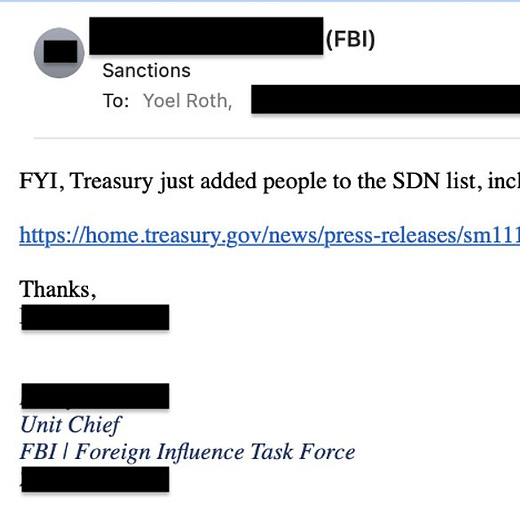
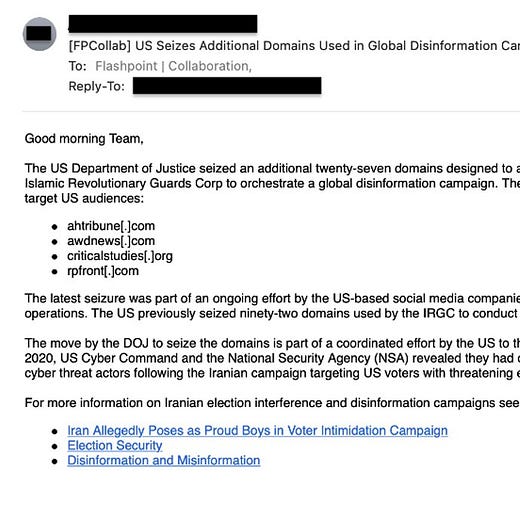
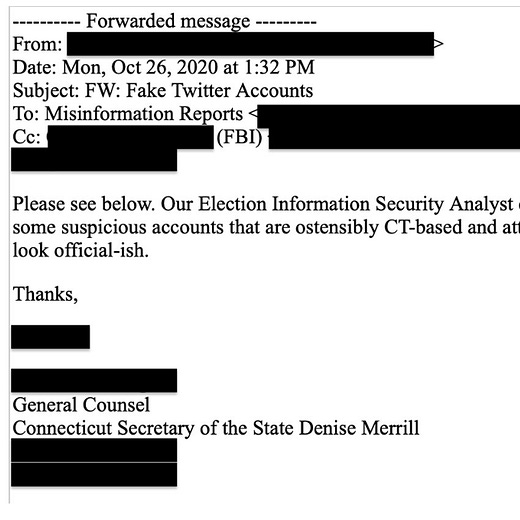
9:54 PM · Jan 3, 2023
55 Reposts · 185 Likes

Matt Taibbi@mtaibbi
27.They also received an astonishing variety of requests from officials asking for individuals they didn’t like to be banned. Here, the office for Democrat and House Intel Committee chief Adam Schiff asks Twitter to ban journalist Paul Sperry:

9:54 PM · Jan 3, 2023
94 Reposts · 220 Likes

Matt Taibbi@mtaibbi
28.“WE DON’T DO THIS” Even Twitter declined to honor Schiff’s request at the time. Sperry was later suspended, however.

9:54 PM · Jan 3, 2023
70 Reposts · 189 Likes

Matt Taibbi@mtaibbi
29.Twitter honored almost everyone else’s requests, even those from GEC – including a decision to ban accounts like @RebelProtests and @bricsmedia because GEC identified them as “GRU-controlled” and linked “to the Russian government,” respectively:
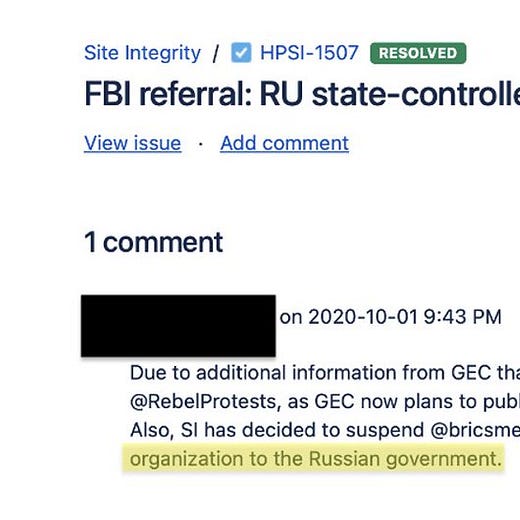
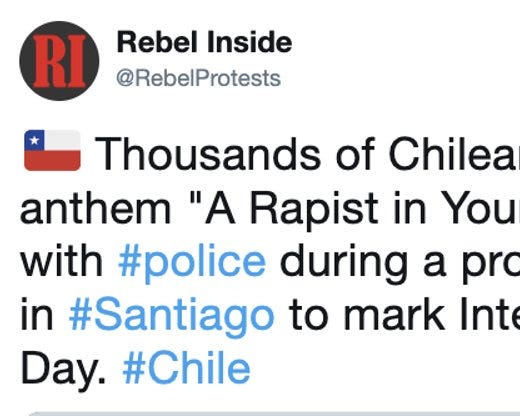
9:54 PM · Jan 3, 2023
45 Reposts · 167 Likes

Matt Taibbi@mtaibbi
30.The GEC requests were what a former CIA staffer working at Twitter was referring to, when he said, “Our window on that is closing,” meaning they days when Twitter could say no to serious requests were over.

9:54 PM · Jan 3, 2023
46 Reposts · 169 Likes

Matt Taibbi@mtaibbi
31.Remember the 2017 “internal guidance” in which Twitter decided to remove any user “identified by the U.S. intelligence community” as a state-sponsored entity committing cyber operations? By 2020 such identifications came in bulk.

9:54 PM · Jan 3, 2023
56 Reposts · 173 Likes

Matt Taibbi@mtaibbi
32.“USIC" requests often simply began “We assess” and then provided lists (sometimes, in separate excel docs) they believed were connected to Russia’s Internet Research Agency and committing cyber ops, from Africa to South America to the U.S.:
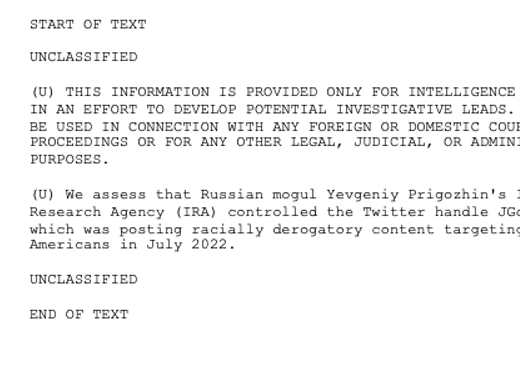

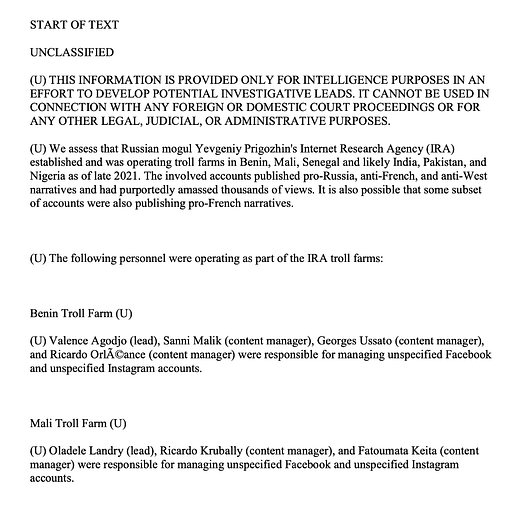
9:54 PM · Jan 3, 2023
40 Reposts · 178 Likes

Matt Taibbi@mtaibbi
34.Some reports were just a paragraph long and said things like: “The attached email accounts… were possibly used for “influence operations, social media collection, or social engineering.” Without further explanation, Twitter would be forwarded an excel doc:
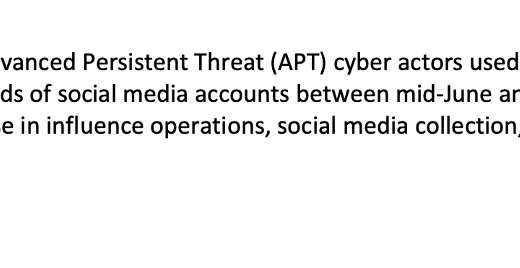
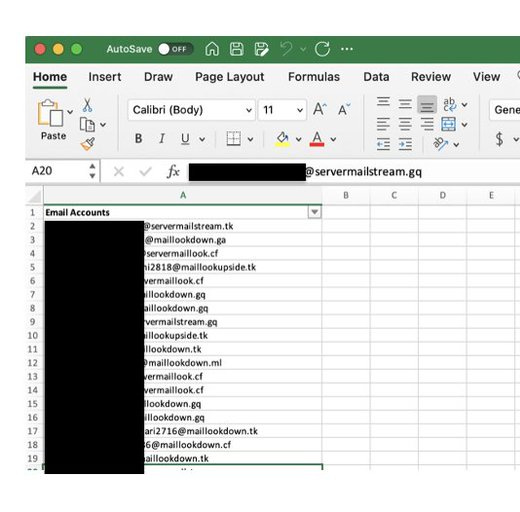
9:54 PM · Jan 3, 2023
46 Reposts · 175 Likes

Matt Taibbi@mtaibbi
35.They were even warned about publicity surrounding a book by former Ukraine prosecutor Viktor Shokhin, who alleged “corruption by the U.S. government” – specifically by Joe Biden.

9:54 PM · Jan 3, 2023
91 Reposts · 246 Likes

Matt Taibbi@mtaibbi
36.By the weeks before the election in 2020, Twitter was so confused by the various streams of incoming requests, staffers had to ask the FBI which was which:

9:54 PM · Jan 3, 2023
62 Reposts · 205 Likes

Matt Taibbi@mtaibbi
37.“I APOLOGIZE IN ADVANCE FOR YOUR WORK LOAD”: Requests poured in from FBI offices all over the country, day after day, hour after hour: If Twitter didn’t act quickly, questions came: “Was action taken?” “Any movement?”

9:54 PM · Jan 3, 2023
67 Reposts · 221 Likes

Matt Taibbi@mtaibbi
38.Wrote senior attorney Stacia Cardille: “My in-box is really f--- up at this point.”

9:55 PM · Jan 3, 2023
36 Reposts · 184 Likes

Matt Taibbi@mtaibbi
39.It all led to the situation described by @ShellenbergerMD two weeks ago, in which Twitter was paid $3,415,323, essentially for being an overwhelmed subcontractor.
Twitter wasn’t just paid. For the amount of work they did for government, they were underpaid.
9:55 PM · Jan 3, 2023
92 Reposts · 391 Likes

Matt Taibbi@mtaibbi
40.For more on the #TwitterFiles, check out @bariweiss, @ShellenbergerMD, @lhfang, and @davidzweig. For more on this story, read
taibbi.substack.com
TK News by Matt Taibbi

9:55 PM · Jan 3, 2023
73 Reposts · 307 Likes
Part VIX
Note that Taibbi skips number 8, but the Tweets below are in the order they were presented.

Matt Taibbi@mtaibbi
1.THREAD: Twitter Files #14
THE RUSSIAGATE LIES
One: The Fake Tale of Russian Bots and the #ReleaseTheMemo Hashtag
5:29 PM · Jan 12, 2023
6.35K Reposts · 12.5K Likes

Matt Taibbi@mtaibbi
2.At a crucial moment in a years-long furor, Democrats denounced a report about flaws in the Trump-Russia investigation, saying it was boosted by Russian “bots” and “trolls.”
2.at
.at-Domain Parked

5:29 PM · Jan 12, 2023
620 Reposts · 3.05K Likes

Matt Taibbi@mtaibbi
3.Twitter officials were aghast, finding no evidence of Russian influence:
“We are feeding congressional trolls.”
“Not any…significant activity connected to Russia.”
“Putting the cart before the horse assuming this is propaganda/bots.”

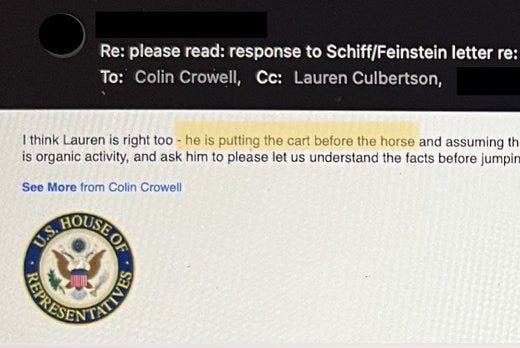
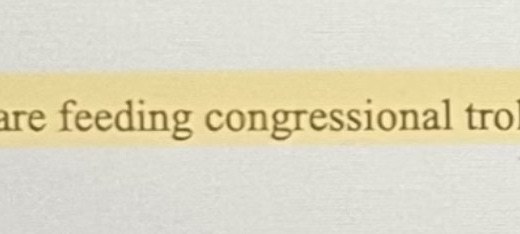
5:29 PM · Jan 12, 2023
953 Reposts · 3.43K Likes

Matt Taibbi@mtaibbi
4.Twitter warned politicians and media the not only lacked evidence, but had evidence the accounts weren’t Russian – and were roundly ignored.
5:29 PM · Jan 12, 2023
755 Reposts · 3.29K Likes

Matt Taibbi@mtaibbi
5.On January 18th, 2018, Republican Devin Nunes submitted a classified memo to the House Intel Committee detailing abuses by the FBI in obtaining FISA surveillance authority against Trump-connected figures, including the crucial role played by the infamous “Steele Dossier”:

5:29 PM · Jan 12, 2023
781 Reposts · 3.09K Likes

Matt Taibbi@mtaibbi
6.The Nunes assertions would virtually all be verified in a report by Justice Department Inspector General Michael Horowitz in December 2019.
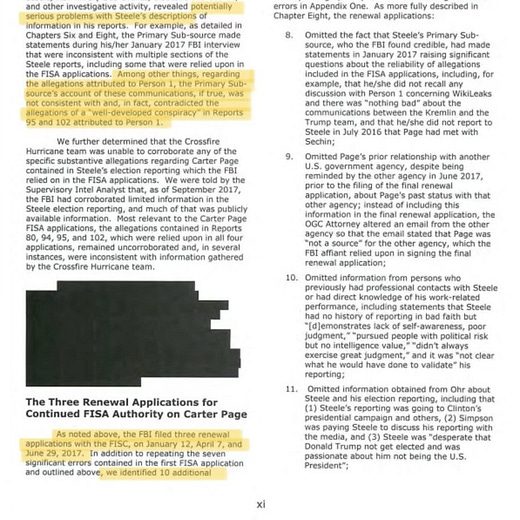
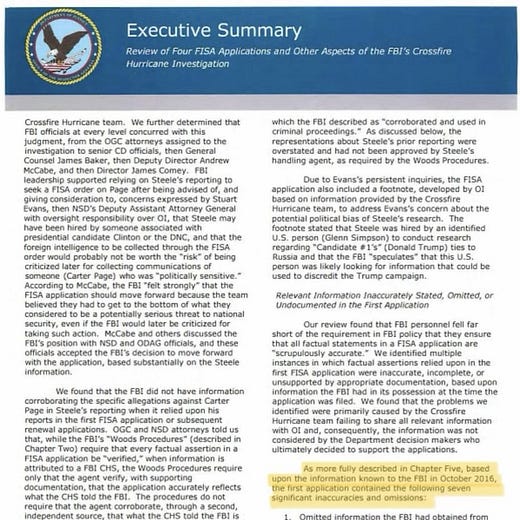
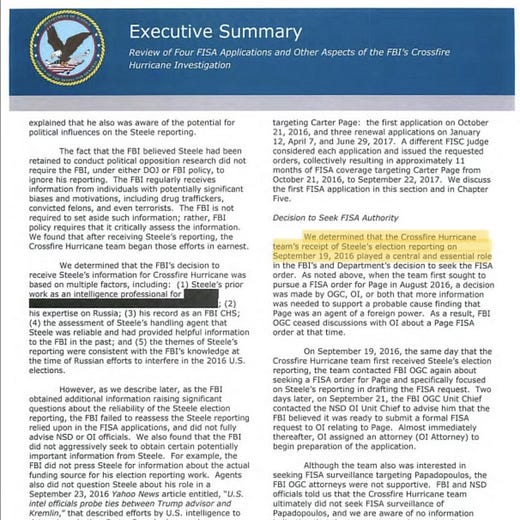
5:29 PM · Jan 12, 2023
752 Reposts · 3.03K Likes

Matt Taibbi@mtaibbi
7.Nonetheless, national media in January and early February of 2018 denounced the Nunes report in oddly identical language, calling it a “joke”:
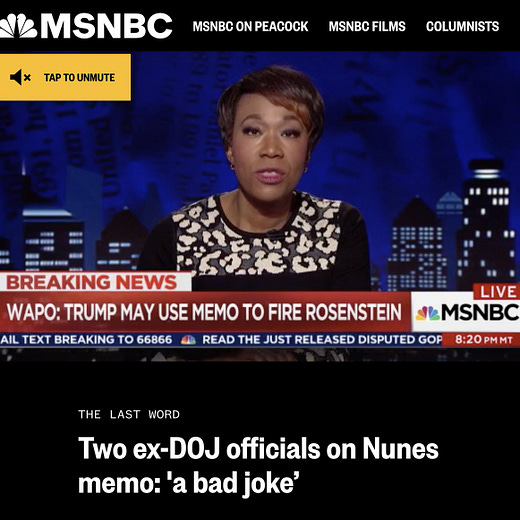
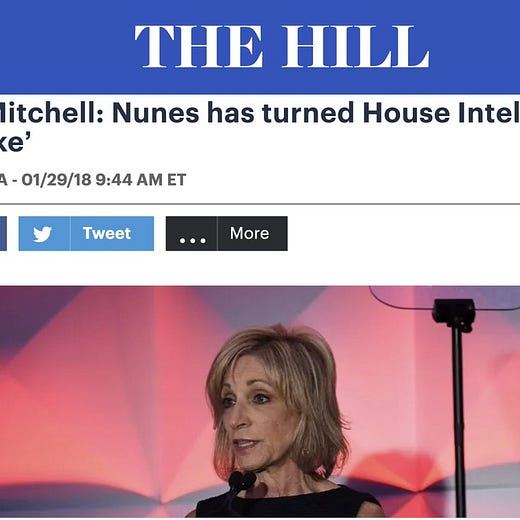
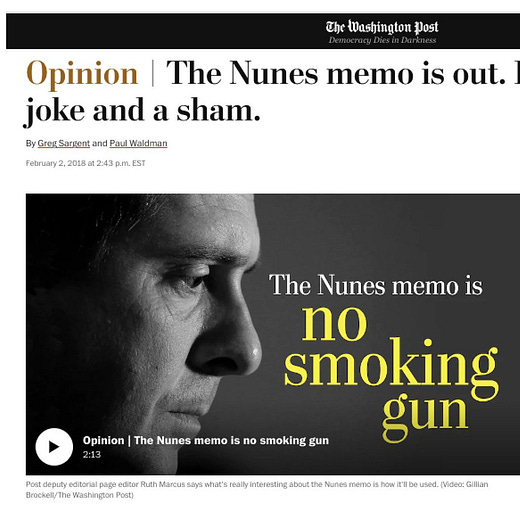
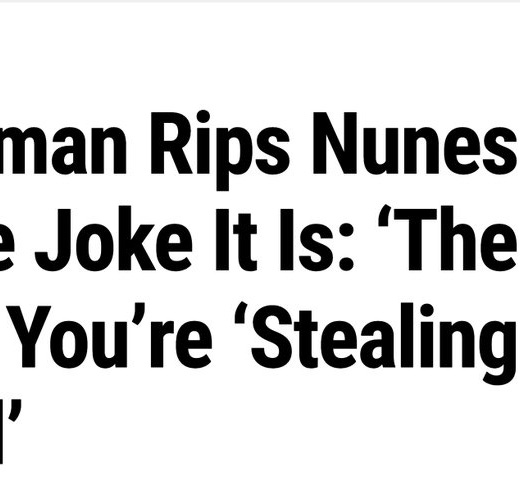
5:29 PM · Jan 12, 2023
779 Reposts · 3.02K Likes

Matt Taibbi@mtaibbi
9.On January 23rd, 2018, Senator Dianne Feinstein (D-CA) and congressman Adam Schiff (D-CA) published an open letter saying the hashtag “gained the immediate attention and assistance of social media accounts linked to Russian influence operations.”

5:29 PM · Jan 12, 2023
629 Reposts · 2.68K Likes

Matt Taibbi@mtaibbi
9b. Feinstein/Schiff said the Nunes memo "distorts" classified information, but note they didn't call it incorrect.

5:29 PM · Jan 12, 2023
578 Reposts · 2.64K Likes

Matt Taibbi@mtaibbi
10.Connecticut Senator Richard Blumenthal followed suit, publishing a letter saying, “We find it reprehensible that Russian agents have so eagerly manipulated innocent Americans.”

5:29 PM · Jan 12, 2023
543 Reposts · 2.52K Likes

Matt Taibbi@mtaibbi
11.Feinstein, Schiff, Blumenthal, and media members all pointed to the same source: the Hamilton 68 dashboard created by former FBI counterintelligence official Clint Watts, under the auspices of the Alliance for Securing Democracy (ASD).
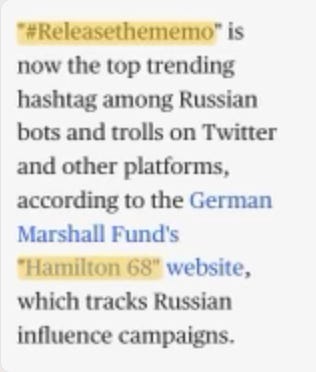
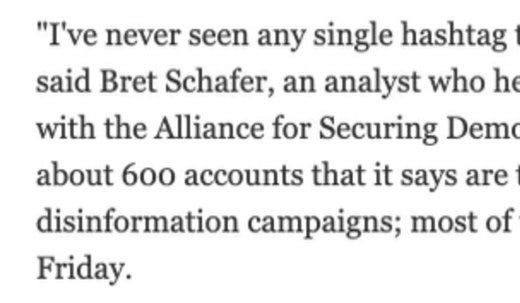
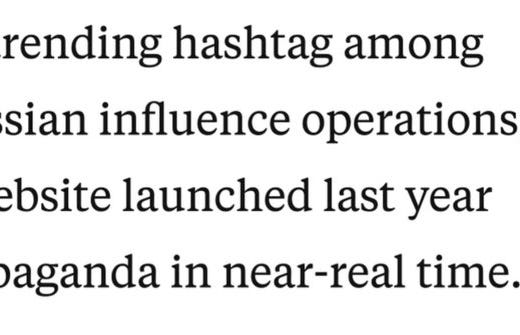
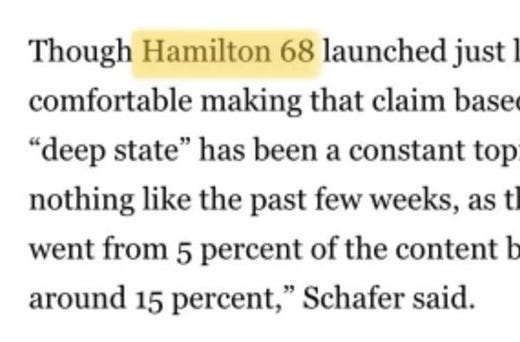
5:29 PM · Jan 12, 2023
651 Reposts · 2.55K Likes

Matt Taibbi@mtaibbi
12.The dashboard, which featured a crude picture of Vladimir Putin deviously blowing evil red Twitter birds into the atmosphere, was vague in how it reached its conclusions.

5:29 PM · Jan 12, 2023
462 Reposts · 2.32K Likes

Matt Taibbi@mtaibbi
13.Inside Twitter, executives panned Watts, Hamilton 68, and the Alliance for Securing Democracy. Two key complaints: Hamilton 68 seemed to be everyone’s only source, and no one was checking with Twitter.
5:29 PM · Jan 12, 2023
486 Reposts · 2.37K Likes

Matt Taibbi@mtaibbi
14.“I encourage you to be skeptical of Hamilton 68’s take on this, which as far as I can tell is the only source for these stories,” said Global Policy Communications Chief (and future WH and NSC spokesperson) Emily Horne.
She added: “It’s a comms play for ASD.”
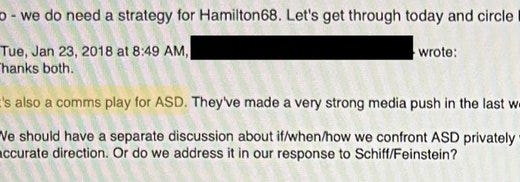
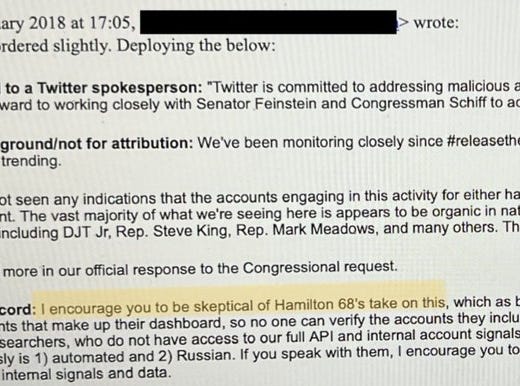
5:29 PM · Jan 12, 2023
480 Reposts · 2.31K Likes

Matt Taibbi@mtaibbi
15.“All the swirl is based on Hamilton,” said Trust and Safety chief Yoel Roth.

5:29 PM · Jan 12, 2023
465 Reposts · 2.25K Likes

Matt Taibbi@mtaibbi
16.“If ASD isn’t going to fact-check with us, we should feel free to correct the record on their work,” said Policy VP Carlos Monje.

5:29 PM · Jan 12, 2023
362 Reposts · 1.86K Likes

Matt Taibbi@mtaibbi
17.Roth couldn’t find any Russian connection to #ReleaseTheMemo – at all. “I just reviewed the accounts that posted the first 50 tweets with #releasethememo and… none of them show any signs of affiliation to Russia.”

5:29 PM · Jan 12, 2023
523 Reposts · 2.09K Likes

Matt Taibbi@mtaibbi
18.“We investigated, found that engagement as overwhelmingly organic, and driven by VITs” – Very Important Tweeters, including Wikileaks and congressman Steve King.

5:29 PM · Jan 12, 2023
427 Reposts · 2K Likes

Matt Taibbi@mtaibbi
19.A staffer for “DiFi” – Feinstein – agreed it would be “helpful to know” how Hamilton 68 goes by “the process by which they decide an account is Russian.”
But, only AFTER Feinstein published her letter about Russian influence.

5:29 PM · Jan 12, 2023
423 Reposts · 1.94K Likes

Matt Taibbi@mtaibbi
20.When Twitter spoke to a Blumenthal staffer, they tried to “wave him off” because “we don’t believe these are bots.”

5:29 PM · Jan 12, 2023
403 Reposts · 1.9K Likes

Matt Taibbi@mtaibbi
21.Added another: “It might be worth nudging Blumenthal’s staffer that it could be in his boss’ best interest not to go out there because it could come back to make him look silly.”

5:29 PM · Jan 12, 2023
405 Reposts · 1.91K Likes

Matt Taibbi@mtaibbi
22.One Twitter exec even tried to negotiate, implying an undisclosed future PR concession if Blumenthal would lay off on this:
“It seems like there are other wins we could offer him.”

5:29 PM · Jan 12, 2023
407 Reposts · 1.86K Likes

Matt Taibbi@mtaibbi
23.Blumenthal published his letter anyway.
5:29 PM · Jan 12, 2023
363 Reposts · 1.84K Likes

Matt Taibbi@mtaibbi
24.Execs eventually grew frustrated over what they saw as a circular process – presented with claims of Russian activity, even when denied, led to more claims.
5:29 PM · Jan 12, 2023
393 Reposts · 1.91K Likes

Matt Taibbi@mtaibbi
25.They expressed this explicitly to Blumenthal’s camp, saying “Twitter spent a lot of resources” on this request and the reward from Blumenthal shouldn’t be round after round of requests.”
“We can’t do a user notice each time this happens.”
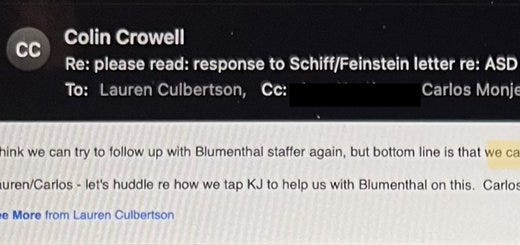

5:29 PM · Jan 12, 2023
378 Reposts · 1.86K Likes

Matt Taibbi@mtaibbi
26.Eventually Twitter staff realize “Blumenthal isn’t looking for real and nuanced solutions” but “just wants to get credit for pushing us further.”

5:29 PM · Jan 12, 2023
455 Reposts · 1.95K Likes

Matt Taibbi@mtaibbi
27.Ultimately senior executives talked about “feeding congressional trolls” and compared their situation to the children’s book, “If You Give a Mouse a Cookie.”

5:29 PM · Jan 12, 2023
421 Reposts · 1.92K Likes

Matt Taibbi@mtaibbi
28.In the story, if you give a mouse a cookie, he’ll want a glass of milk, which will lead to a wave of other exhausting requests, at the end of which he’ll want a glass of milk. And one more cookie.


5:29 PM · Jan 12, 2023
375 Reposts · 1.94K Likes

Matt Taibbi@mtaibbi
29.The metaphor for the endless Russia requests was so perfect, one exec wrote, “I’m legit embarrassed I didn’t think of that first.”

5:29 PM · Jan 12, 2023
395 Reposts · 1.93K Likes

Matt Taibbi@mtaibbi
30.Despite universal internal conviction that there were no Russians in the story, Twitter went on to follow a slavish pattern of not challenging Russia claims on the record.
5:29 PM · Jan 12, 2023
482 Reposts · 2K Likes

Matt Taibbi@mtaibbi
31.Outside counsel from DC-connected firms like Debevoise and Plimpton advised Twitter to use language like, “With respect to particular hashtags, we take seriously any activity that may represent an abuse of our platform.”

5:29 PM · Jan 12, 2023
398 Reposts · 1.88K Likes

Matt Taibbi@mtaibbi
32.As a result, reporters from the AP to Politico to NBC to Rolling Stone continued to hammer the “Russian bots” theme, despite a total lack of evidence.
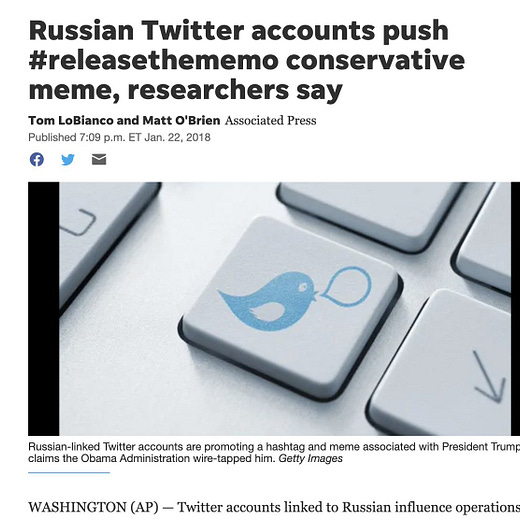
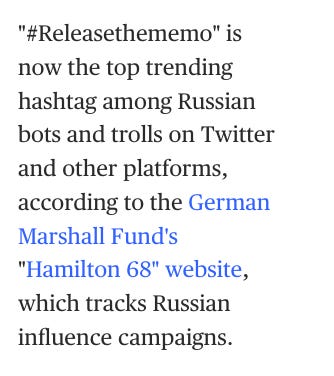
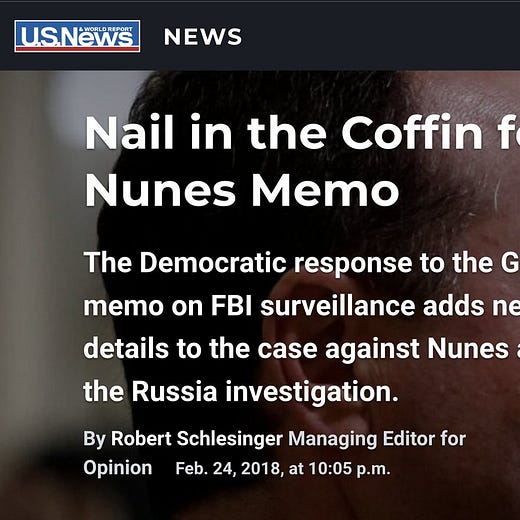
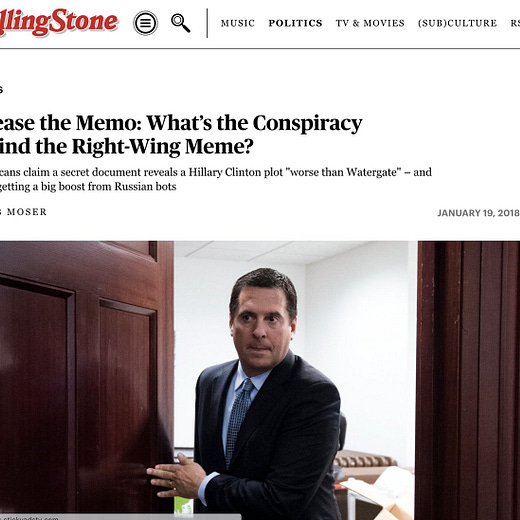
5:29 PM · Jan 12, 2023
520 Reposts · 1.72K Likes

Matt Taibbi@mtaibbi
33.Russians weren’t just blamed for #ReleaseTheMemo but #SchumerShutdown, #ParklandShooting, even #GunControlNow – to “widen the divide,” according to the New York Times.

5:29 PM · Jan 12, 2023
365 Reposts · 1.44K Likes

Matt Taibbi@mtaibbi
34.Re #SchumerShutdown and #ReleaseTheMemo, the internal guidance was, “Both hashtags appear to be organically trending.”

5:30 PM · Jan 12, 2023
308 Reposts · 1.37K Likes

Matt Taibbi@mtaibbi
35.NBC, Politico, AP, Times, Business Insider, and other media outlets who played up the “Russian bots” story – even Rolling Stone – all declined to comment for this story.
5:30 PM · Jan 12, 2023
499 Reposts · 1.78K Likes

Matt Taibbi@mtaibbi
36.The staffs of Feinstein, Schiff, and Blumenthal also declined comment.
5:30 PM · Jan 12, 2023
425 Reposts · 1.68K Likes

Matt Taibbi@mtaibbi
37. Who did comment? Devin Nunes. "Schiff and the Democrats falsely claimed Russians were behind the Release the Memo hashtag, all my investigative work... By spreading the Russia collusion hoax, they instigated one of the greatest outbreaks of mass delusion in U.S. history.”
5:30 PM · Jan 12, 2023
796 Reposts · 2.46K Likes

Matt Taibbi@mtaibbi
38.This #ReleaseTheMemo episode is just one of many in the #TwitterFiles. The Russiagate scandal was built on the craven dishonesty of politicians and reporters, who for years ignored the absence of data to fictional scare headlines.
5:30 PM · Jan 12, 2023
443 Reposts · 1.42K Likes

Matt Taibbi@mtaibbi
39.For more, watch @ShellenbergerMD, @bariweiss, @lhfang, @davidzweig, @AlexBerenson, and more.
Read Taibbi.Substack.Com for more on why “America Needs Truth and Reconciliation on Russiagate.”
taibbi.substack.com
TK News by Matt Taibbi

5:30 PM · Jan 12, 2023
248 Reposts · 1.15K Likes

Matt Taibbi@mtaibbi
40.Twitter had no editorial input on this story. Searches were carried out by third parties, so the documents could be limited.
5:30 PM · Jan 12, 2023
257 Reposts · 1.22K Likes
Part XV

Lee Fang@lhfang
1. New piece from the TWITTER FILES.
How the pharmaceutical industry lobbied social media to shape content around vaccine policy.
The push included direct pressure from Pfizer partner BioNTech to censor activists demanding low-cost generic vaccines for low-income countries.
3:30 PM · Jan 16, 2023
5.64K Reposts · 11.4K Likes

Lee Fang@lhfang
2. In 2020, it was clear that the pandemic would require rapid innovation. Early on, there was a push to make the solution equitable: an international partnership to share ideas, technology, new forms of medicine to rapidly solve this crisis.
medicinespatentpool.org
New agreement under C-TAP aims to improve global access to COVID-19 testing technologies - MPP

3:40 PM · Jan 16, 2023
455 Reposts · 2.18K Likes

Lee Fang@lhfang
3. But global drug giants saw the crisis as an opportunity for unprecedented profit. Behind closed doors, pharma launched a massive lobbying blitz to crush any effort to share patents/IP for new covid-related medicine, including therapeutics and vaccines.
3:44 PM · Jan 16, 2023
723 Reposts · 2.69K Likes

Lee Fang@lhfang
4. BIO, the lobby group that represents biopharma, including Moderna & Pfizer, wrote to the newly elected Biden admin, demanding the U.S. gov sanction any country attempting to violate patent rights and create generic low cost covid medicine or vaccines.
theintercept.com
Drug Lobby Asks Biden to Punish Foreign Countries Pushing for Low-Cost Vaccines

3:47 PM · Jan 16, 2023
791 Reposts · 2.5K Likes

Lee Fang@lhfang
5. That brings us to Twitter. The global lobbying blitz includes direct pressure on social media. BioNTech, which developed Pfizer's vaccine, reached out to Twitter to request that Twitter directly censor users tweeting at them to ask for generic low cost vaccines.

3:50 PM · Jan 16, 2023
724 Reposts · 2.55K Likes

Lee Fang@lhfang
6. Twitter's reps responded quickly to the pharma request, which was also backed by the German government. A lobbyist in Europe asked the content moderation team to monitor the accounts of Pfizer, AstraZeneca & of activist hashtags like #peoplesvaccine

3:54 PM · Jan 16, 2023
511 Reposts · 2.17K Likes

Lee Fang@lhfang
7. The potential "fake accounts" that Twitter monitored for protesting Pfizer? These were real people. Here's one the Twitter team flagged for potential terms of use violations. I talked to Terry, a 74 year old retired bricklayer in the UK on the phone. https://t.co/qIH0Tngsm1

Terry Brough #PeaceJusticeSocialism ✊ @TerryB28937065
Dear @AlbertBourla, @sbancel & #PascalSoriot, 9/10 people in poor countries are going to MISS OUT on a #COVID19 vaccine next year. Will @Pfizer, @BioNTech_Group @moderna_tx & @AstraZeneca #JoinCTAP to ensure that everyone, everywhere can be safe? We need a #PeoplesVaccine!
4:00 PM · Jan 16, 2023
477 Reposts · 2.14K Likes

Lee Fang@lhfang
8. It's not clear what actions Twitter ultimately took on this particular request. Several Twitter employees noted in subsequent messages that none of this activism constituted abuse. But the company continued monitoring tweets.
4:02 PM · Jan 16, 2023
335 Reposts · 1.83K Likes

Lee Fang@lhfang
9. In a separate push, Pfizer & Moderna's lobbying group, BIO, fully funded a special content moderation campaign designed by a contractor called Public Good Projects, which worked w/Twitter to set content moderation rules around covid "misinformation."
4:08 PM · Jan 16, 2023
505 Reposts · 1.9K Likes

Lee Fang@lhfang
10. BIO provided $1,275,000 to the campaign, part of which is revealed through tax forms. The PGP campaign, called "Stronger," helped Twitter create content moderation bots, select which public health accounts got verification, helped crowdsource content takedowns.
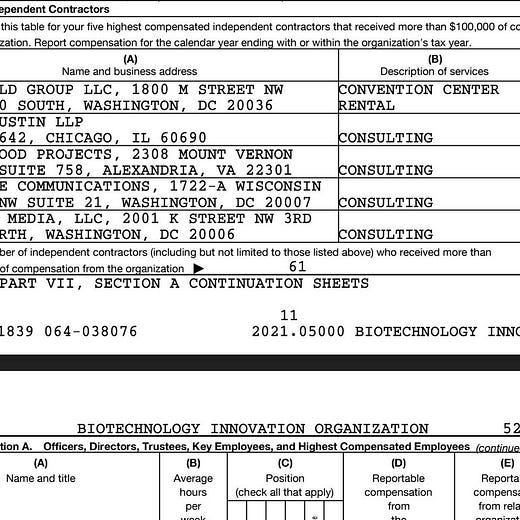
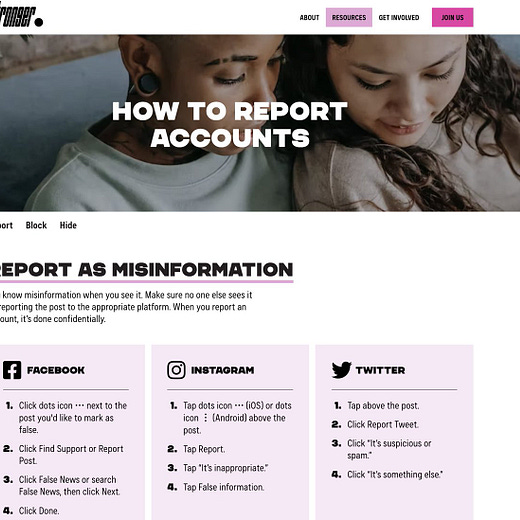
4:13 PM · Jan 16, 2023
538 Reposts · 1.91K Likes

Lee Fang@lhfang
11. Many of the tweets the BIO-funded campaign focused on were truly unhinged misinfo, like claims that vaccines include microchips. But others Stronger lobbied Twitter on were more of a grey area, like vaccine passports & vaccine mandates, policies that coerce vaccination.
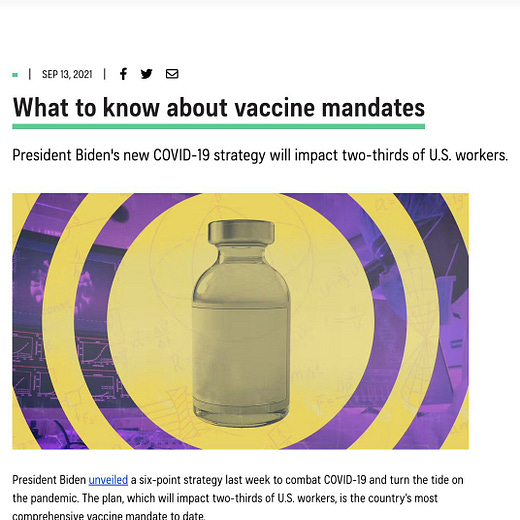
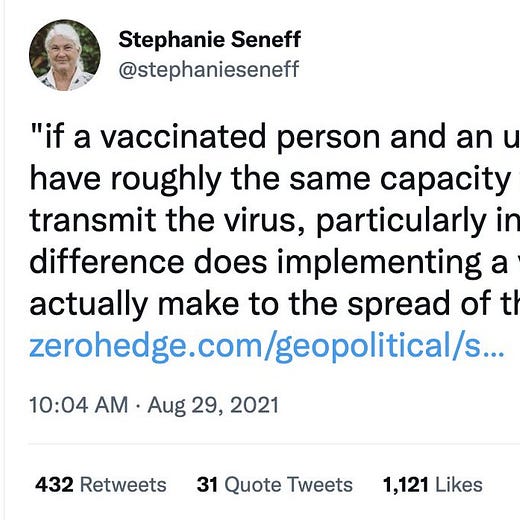
4:17 PM · Jan 16, 2023
386 Reposts · 1.76K Likes

Lee Fang@lhfang
12. The Moderna/Pfizer-funded campaign included direct regular emails with lists of tweets to takedown & others to verify. Here's an example of those types of emails that went straight to Twitter's lobbyists and content moderators. Many focused on @zerohedge, which was suspended.

4:22 PM · Jan 16, 2023
612 Reposts · 2.04K Likes

Lee Fang@lhfang
13. Notably, this massive push to censor and label covid misinfo never applied to drug companies. When big pharma wildly exaggerated the risks of creating low-cost generic covid vaccines, Stronger did nothing. The rules applied only to critics of industry.

PhRMA @PhRMA
The biopharma sector employs more than 900,000 workers and supports 4.4 million U.S. jobs. Those jobs would be at risk if the #TRIPS waiver is extended to #COVID19 treatments. Read more about the real consequences of waiving commitments to protect IP: https://t.co/0ppR9AUQGl
4:26 PM · Jan 16, 2023
524 Reposts · 1.93K Likes

Lee Fang@lhfang
14. Here is my reported piece w/more detail. I was given some access to Twitter emails. I signed/agreed to nothing, Twitter had no input into anything I did or wrote. The searches were carried out by a Twitter attorney, so what I saw could be limited.
theintercept.com
Covid-19 Drugmakers Pressured Twitter to Censor Activists Pushing for Generic Vaccine

4:28 PM · Jan 16, 2023
500 Reposts · 1.83K Likes
Part XV 2.0
The numbers are starting to get mixed up now, but Taibbi refers to this as part XV so we’ll just add “2.0” to it I guess.

Matt Taibbi@mtaibbi
1.THREAD: Twitter Files #15
MOVE OVER, JAYSON BLAIR: TWITTER FILES EXPOSE NEXT GREAT MEDIA FRAUD
5:49 PM · Jan 27, 2023
1.34K Reposts · 2.63K Likes

Matt Taibbi@mtaibbi
2.“I think we need to just call this out on the bullshit it is.”

5:49 PM · Jan 27, 2023
129 Reposts · 738 Likes

Matt Taibbi@mtaibbi
3.“Falsely accuses a bunch of legitimate right-leaning accounts of being Russian bots.”

5:49 PM · Jan 27, 2023
159 Reposts · 755 Likes

Matt Taibbi@mtaibbi
4.“Virtually any conclusion drawn from it will take conversations in conservative circles on Twitter and accuse them of being Russian.”

5:49 PM · Jan 27, 2023
143 Reposts · 679 Likes

Matt Taibbi@mtaibbi
5.These are quotes by Twitter executives about Hamilton 68, a digital “dashboard” that claimed to track Russian influence and was the source of hundreds if not thousands of mainstream print and TV news stories in the Trump years.

5:49 PM · Jan 27, 2023
132 Reposts · 648 Likes

Matt Taibbi@mtaibbi
6.The “dashboard” was headed by former FBI counterintelligence official (and current MSNBC contributor) Clint Watts, and funded by a neoliberal think tank, the Alliance for Securing Democracy (ASD).

5:49 PM · Jan 27, 2023
196 Reposts · 696 Likes

Matt Taibbi@mtaibbi
7.The ASD advisory council includes neoconservative writer Bill Kristol, former Ambassador to Russia Michael McFaul, ex-Hillary for America chief John Podesta, and former heads or deputy heads of the CIA, NSA, and the Department of Homeland Security.
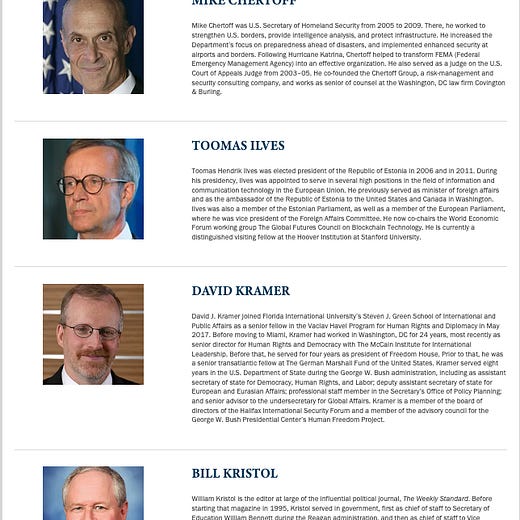
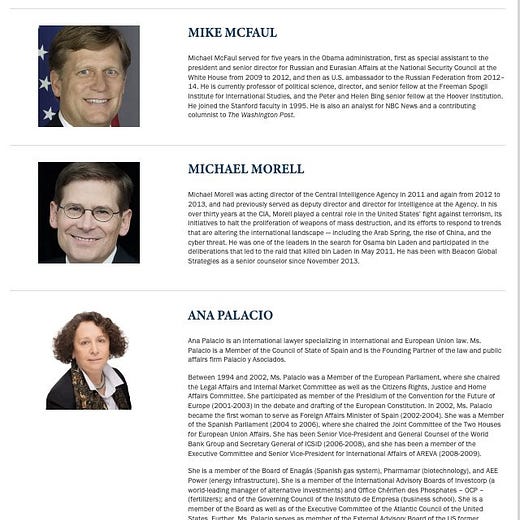
5:49 PM · Jan 27, 2023
193 Reposts · 661 Likes

Matt Taibbi@mtaibbi
8.News outlets for years cited Watts and Hamilton 68 when claiming Russian bots were “amplifying” an endless parade of social media causes – against strikes in Syria, in support of Fox host Laura Ingraham, the campaigns of both Donald Trump and Bernie Sanders.
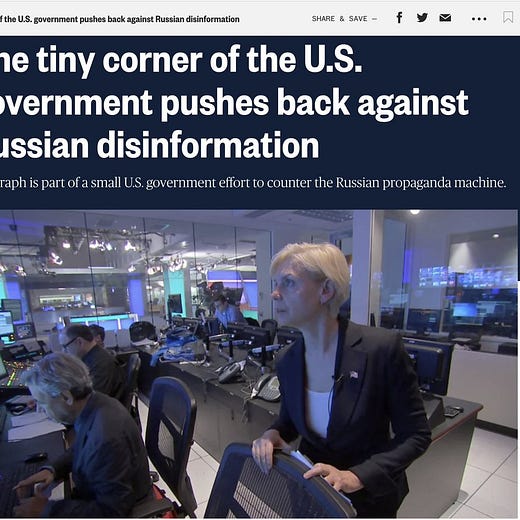
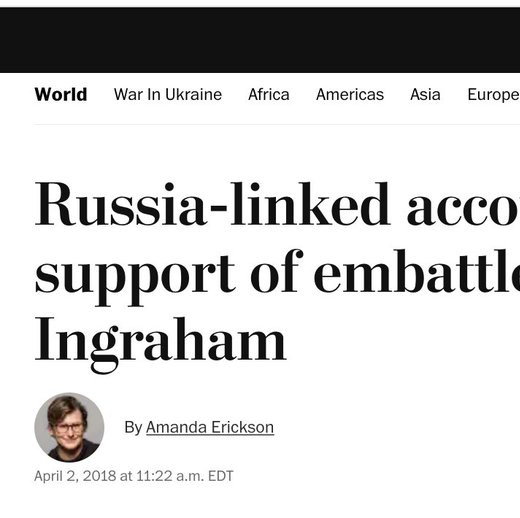
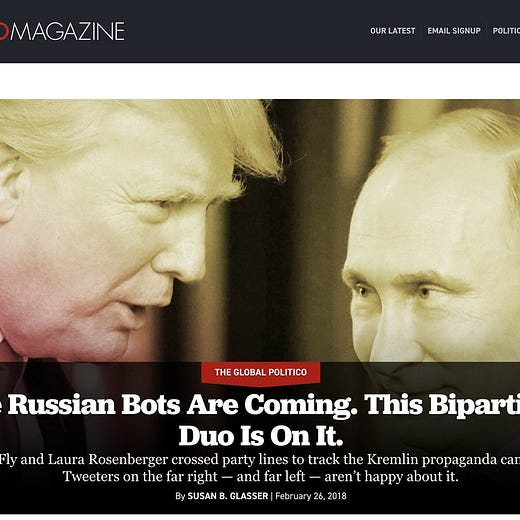
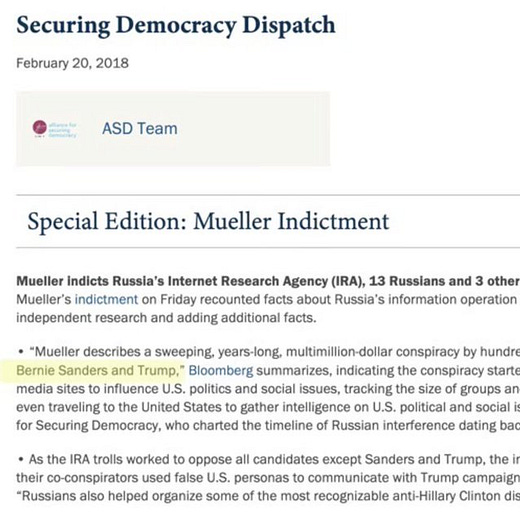
5:49 PM · Jan 27, 2023
122 Reposts · 577 Likes

Matt Taibbi@mtaibbi
9.Hamilton 68 was the source for stories claiming Russian bots pushed terms like “deep state” or hashtags like #FireMcMaster, #SchumerShutdown, #WalkAway, #ReleaseTheMemo, #AlabamaSenateRace, and #ParklandShooting, among many others.
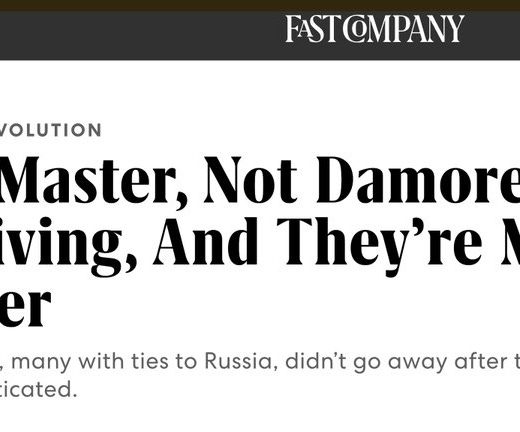
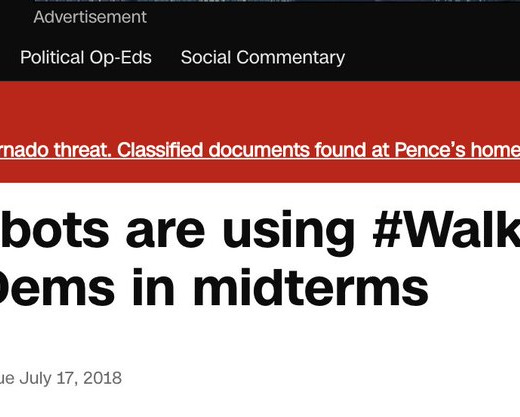
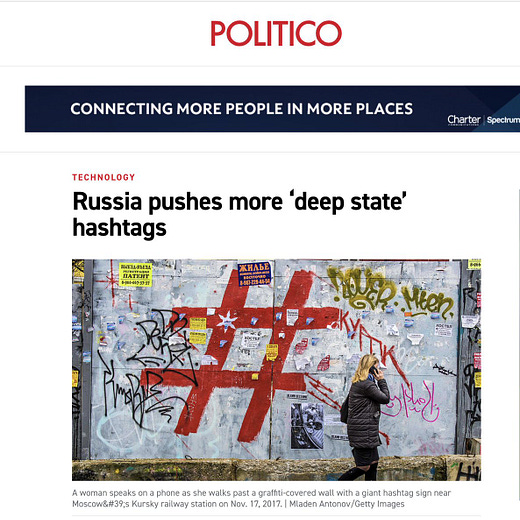
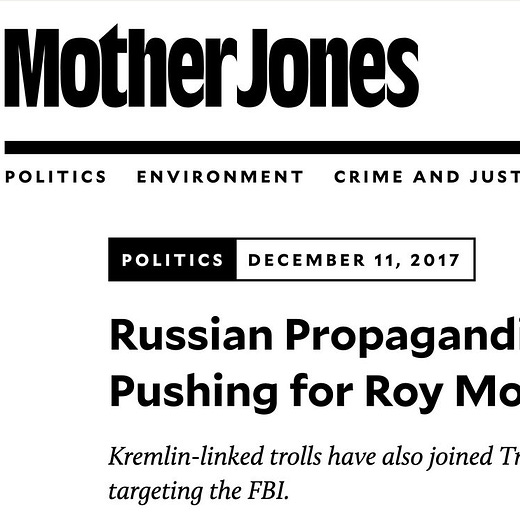
5:49 PM · Jan 27, 2023
121 Reposts · 559 Likes

Matt Taibbi@mtaibbi
10. The secret ingredient to Hamilton 68’s analytical method? A list: “Our analysis has linked 600 Twitter accounts to Russian influence activities online,” was how the site put it at launch.

5:49 PM · Jan 27, 2023
98 Reposts · 508 Likes

Matt Taibbi@mtaibbi
11. Hamilton 68 never released the list, claiming "the Russians will simply shut [the accounts] down." All those reporters and TV personalities making claims about “Russian bots” never really knew what they were describing.

5:49 PM · Jan 27, 2023
109 Reposts · 545 Likes

Matt Taibbi@mtaibbi
12. Twitter executives were in a unique position to recreate Hamilton’s list, reverse-engineering it from the site’s requests for Twitter data.
Concerned about the deluge of Hamilton-based news stories, they did so – and what they found shocked them.

5:49 PM · Jan 27, 2023
119 Reposts · 539 Likes

Matt Taibbi@mtaibbi
13.“These accounts,” they concluded, “are neither strongly Russian nor strongly bots.”
“No evidence to support the statement that the dashboard is a finger on the pulse of Russian information ops.”
“Hardly illuminating a massive influence operation.”
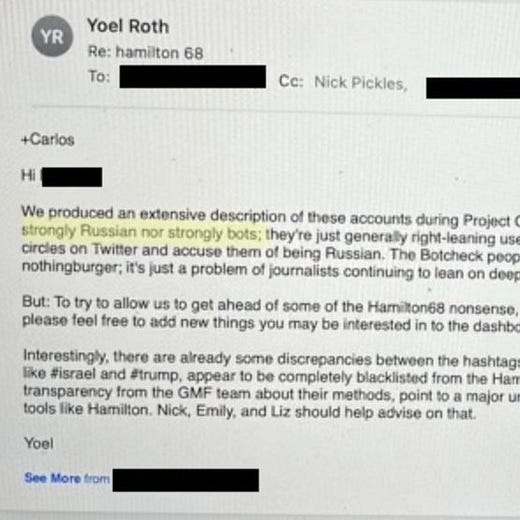
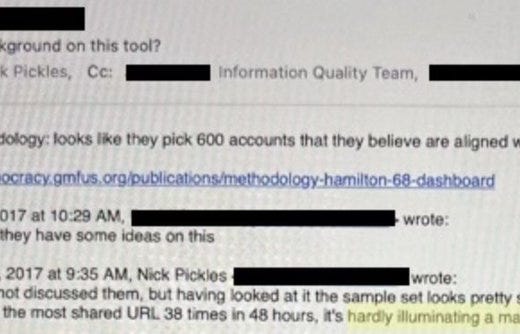
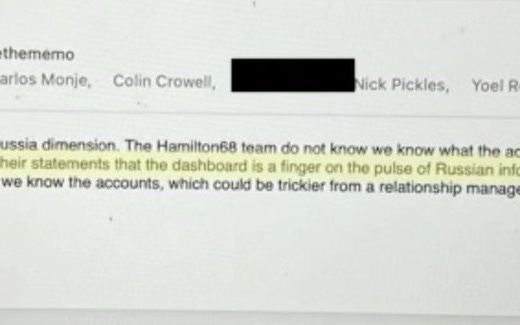
5:49 PM · Jan 27, 2023
127 Reposts · 540 Likes

Matt Taibbi@mtaibbi
14. In layman’s terms, the Hamilton 68 barely had any Russians. In fact, apart from a few RT accounts, it’s mostly full of ordinary Americans, Canadians, and British.
5:49 PM · Jan 27, 2023
128 Reposts · 560 Likes

Matt Taibbi@mtaibbi
15.It was a scam. Instead of tracking how “Russia” influenced American attitudes, Hamilton 68 simply collected a handful of mostly real, mostly American accounts, and described their organic conversations as Russian scheming.
5:49 PM · Jan 27, 2023
151 Reposts · 590 Likes

Matt Taibbi@mtaibbi
16. Twitter immediately recognized these Hamilton-driven news stories posed a major ethical problem, potentially implicating them.
“Real people need to know they’ve been unilaterally labeled Russian stooges without evidence or recourse,” Roth wrote.

5:49 PM · Jan 27, 2023
127 Reposts · 545 Likes

Matt Taibbi@mtaibbi
17.Some Twitter execs badly wanted to out Hamilton 68. After Russians were blamed for hyping the #ParklandShooting hashtag, one wrote:
“Why can’t we say we’ve investigated… and citing Hamilton 68 is being wrong, irresponsible, and biased?”

5:49 PM · Jan 27, 2023
99 Reposts · 517 Likes

Matt Taibbi@mtaibbi
18.Yoel Roth wanted a confrontation. “My recommendation at this stage is an ultimatum: you release the list or we do,” he wrote.
However, there were internal concerns about taking on the politically connected Alliance for Securing Democracy.

5:49 PM · Jan 27, 2023
105 Reposts · 493 Likes

Matt Taibbi@mtaibbi
19.“We have to be careful in how much we push back on ASD publicly,” said future White House and NSC spokesperson Emily Horne.

5:49 PM · Jan 27, 2023
102 Reposts · 472 Likes

Matt Taibbi@mtaibbi
20.“I also have been very frustrated in not calling out Hamilton 68 more publicly, but understand we have to play a longer game here,” wrote Carlos Monje, the future senior advisor to Transportation Secretary Pete Buttigieg.

5:49 PM · Jan 27, 2023
109 Reposts · 470 Likes

Matt Taibbi@mtaibbi
21. So the “legitimate people,” as one Twitter exec called them, never found out they’d been used as fodder for mountains of news stories about “Russian influence.” Because the #TwitterFiles contain the list, they’ve begun finding out.
5:49 PM · Jan 27, 2023
94 Reposts · 465 Likes

Matt Taibbi@mtaibbi
22.“I’m shocked,” says Sonia Monsour, who as a child lived through civil war in Lebanon. “Supposedly in a free world, we are being watched at many levels, by what we say online.”
5:49 PM · Jan 27, 2023
91 Reposts · 465 Likes

Matt Taibbi@mtaibbi
23. “I’ve written a book about the U.S. Constitution,” says Chicago-based lawyer Dave Shestokas. “How I made a list like this is incredible to me.”

5:49 PM · Jan 27, 2023
94 Reposts · 456 Likes

Matt Taibbi@mtaibbi
24. “When I was growing up, my father told me about the McCarthyite blacklist,” says Oregon native Jacob Levich. “As a child it would never have occurred to me that this would come back, in force and broadly, in a way… designed to undermine rights we hold dear.”
5:49 PM · Jan 27, 2023
100 Reposts · 487 Likes

Matt Taibbi@mtaibbi
25. Even Twitter execs were stunned to read who was on the list. Wrote policy chief Nick Pickles about British comic @Holbornlolz: “A wind-up merchant… I follow him and wouldn’t say he’s pro-Russian… I can’t even remember him tweeting about Russia.”
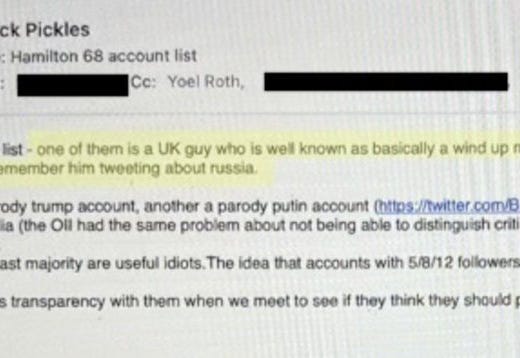

5:49 PM · Jan 27, 2023
102 Reposts · 474 Likes

Matt Taibbi@mtaibbi
26. I’m listed as a foreign bot?” said conservative media figure Dennis Michael Lynch. “As a proud taxpaying citizen, charitable family man, and honest son of a U.S. Marine, I deserve better. We all do!”

5:49 PM · Jan 27, 2023
59 Reposts · 274 Likes

Matt Taibbi@mtaibbi
27. Consortium editor Joe Lauria too was angered to find he was on the list, which targeted voices across the spectrum: “Organizations like Hamilton 68 are in business to enforce an official narrative, which means excising inconvenient facts, which they call ‘misinformation.’”

5:49 PM · Jan 27, 2023
54 Reposts · 270 Likes

Matt Taibbi@mtaibbi
28.What makes this an important story is the sheer scale of the news footprint left by Hamilton 68’s digital McCarthyism. The quantity of headlines and TV segments dwarfs the impact of individual fabulists like Jayson Blair or Stephen Glass.

5:49 PM · Jan 27, 2023
83 Reposts · 292 Likes

Matt Taibbi@mtaibbi
29.Hamilton 68 was used as a source to assert Russian influence in an astonishing array of news stories: support for Brett Kavanaugh or the Devin Nunes memo, the Parkland shooting, manipulation of black voters, “attacks” on the Mueller investigation…
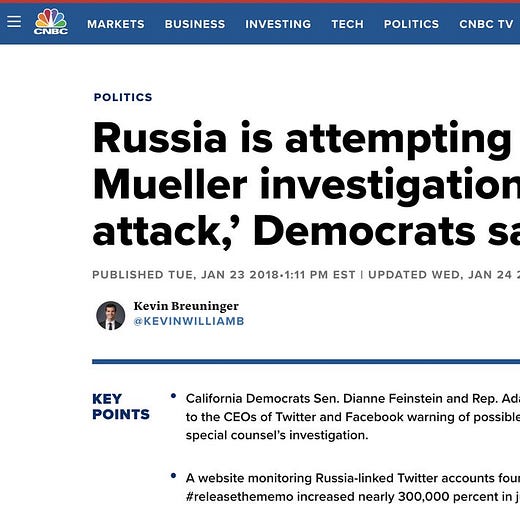
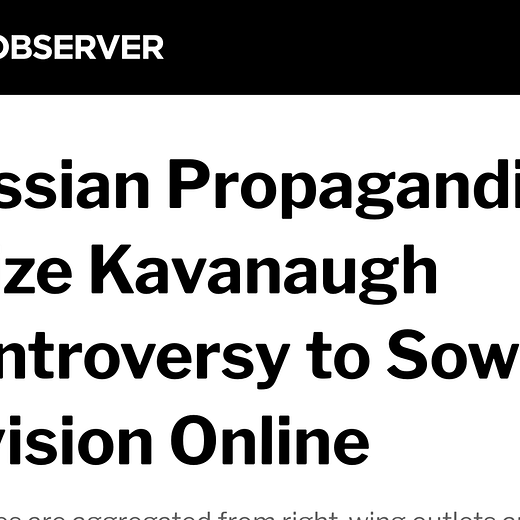

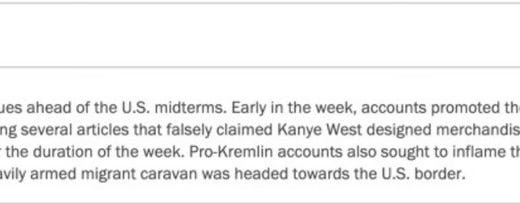
5:49 PM · Jan 27, 2023
71 Reposts · 261 Likes

Matt Taibbi@mtaibbi
30.These stories raised fears in the population, and most insidious of all, were used to smear people like Tulsi Gabbard as foreign “assets,” and drum up sympathy for political causes like Joe Biden’s campaign by describing critics as Russian-aligned.
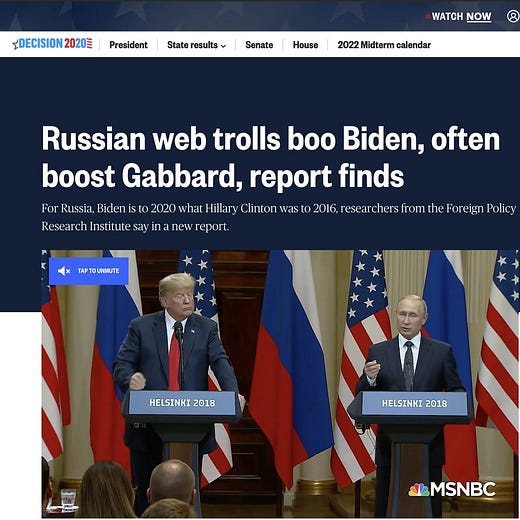
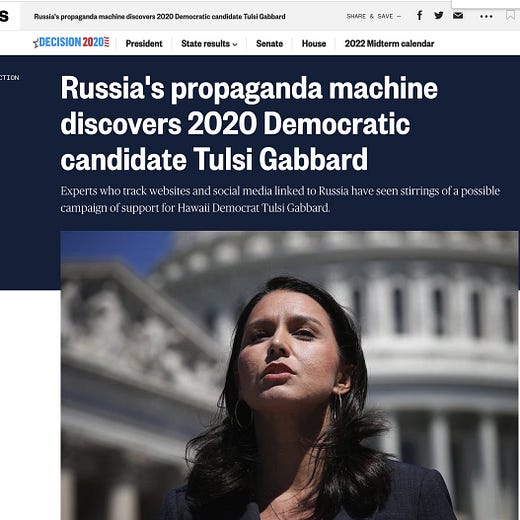
5:49 PM · Jan 27, 2023
69 Reposts · 283 Likes

Matt Taibbi@mtaibbi
31.Incredibly, and ironically, these stories were also frequently used as evidence of the spread of “fake news” on sites like Twitter:

5:49 PM · Jan 27, 2023
59 Reposts · 275 Likes

Matt Taibbi@mtaibbi
32.It was a lie. The illusion of Russian support was created by tracking people like Joe Lauria, Sonia Monsour, and Dave Shestokas. Virtually every major American news organization cited these fake tales— even fact-checking sites like Snopes and Politifact.
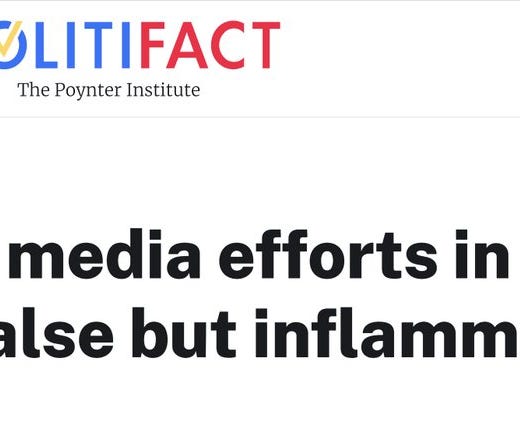
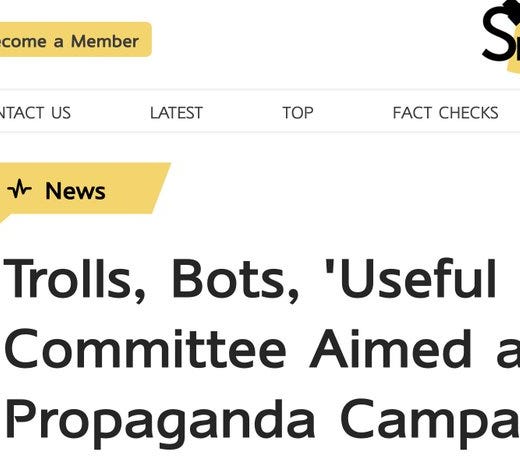
5:49 PM · Jan 27, 2023
83 Reposts · 243 Likes

Matt Taibbi@mtaibbi
33.Twitter didn’t have the guts to out Hamilton 68 publicly but did try to speak to reporters off the record. “Reporters are chafing,” said Horne. “It’s like shouting into a void.”
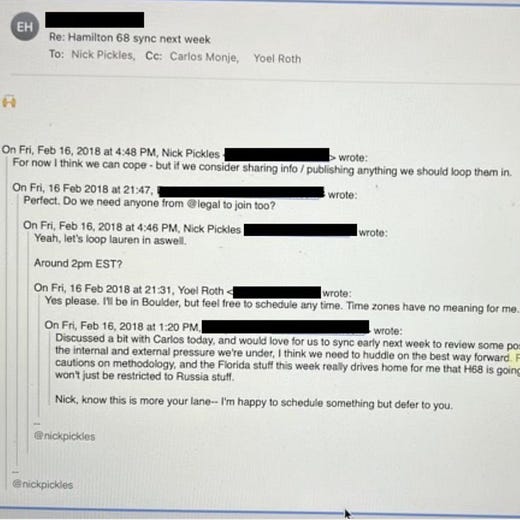
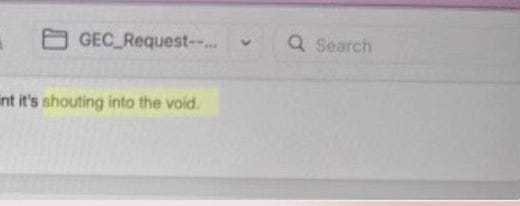
5:49 PM · Jan 27, 2023
61 Reposts · 226 Likes

Matt Taibbi@mtaibbi
34.Roth was offended by the idea that tweets on certain themes suggested subversion. “Can we talk about how incredibly condescending…? If you talk about these themes, you must have been duped by Russian propaganda.”

5:49 PM · Jan 27, 2023
48 Reposts · 215 Likes

Matt Taibbi@mtaibbi
35.Again, even Roth, like most Twitter execs an ardent Democratic partisan, saw that the Hamilton scheme would lead people “to assert that any right-leaning content is propagated by Russian bots.”

5:49 PM · Jan 27, 2023
55 Reposts · 222 Likes

Matt Taibbi@mtaibbi
36.At least two other research institutions that used similar methodologies – and were cited as sources in news stories – were also criticized in Twitter email correspondence.
36.at
36.at (FOR SALE)

5:49 PM · Jan 27, 2023
39 Reposts · 200 Likes

Matt Taibbi@mtaibbi
37.MSNBC, Watts, the Washington Post, Politico, Mother Jones (which did at least 14 Hamilton 68 stories), the Alliance for Securing Democracy, and the offices of politicians like Dianne Feinstein all refused comment, unless this counts:

5:49 PM · Jan 27, 2023
63 Reposts · 236 Likes

Matt Taibbi@mtaibbi
38.This was an academic scandal as well, as Harvard, Princeton, Temple, NYU, GWU, and other universities promoted Hamilton 68 as a source:
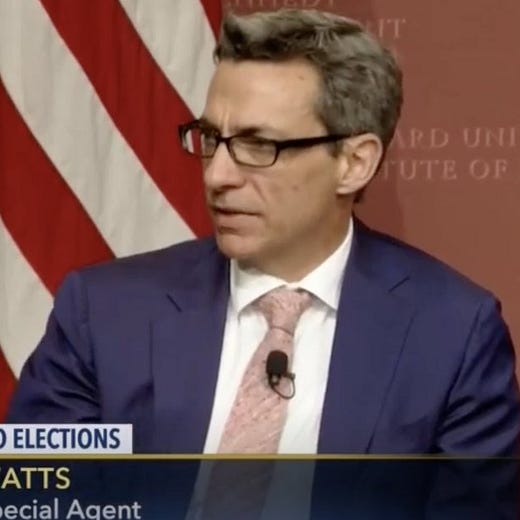
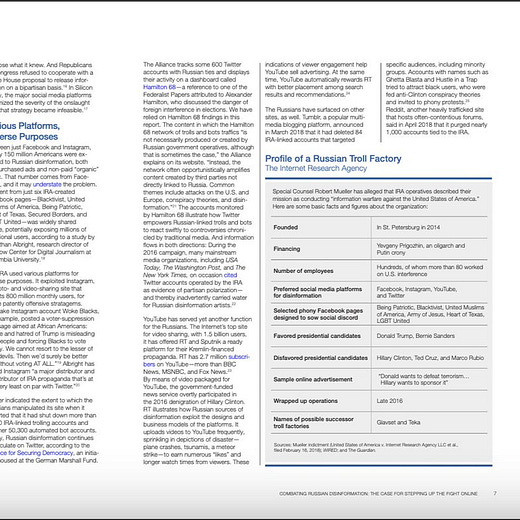
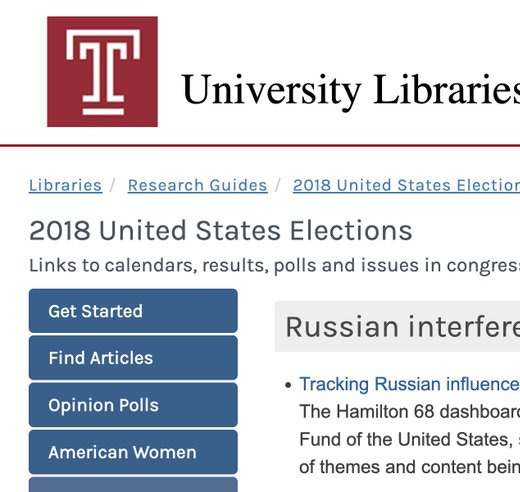
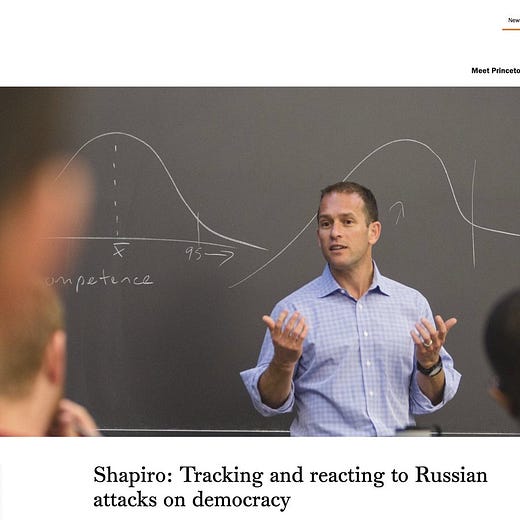
5:49 PM · Jan 27, 2023
79 Reposts · 259 Likes

Matt Taibbi@mtaibbi
39.Perhaps most embarrassingly, elected officials promoted the site, and invited Hamilton “experts” to testify. Dianne Feinstein, James Lankford, Richard Blumenthal, Adam Schiff, and Mark Warner were among the offenders.
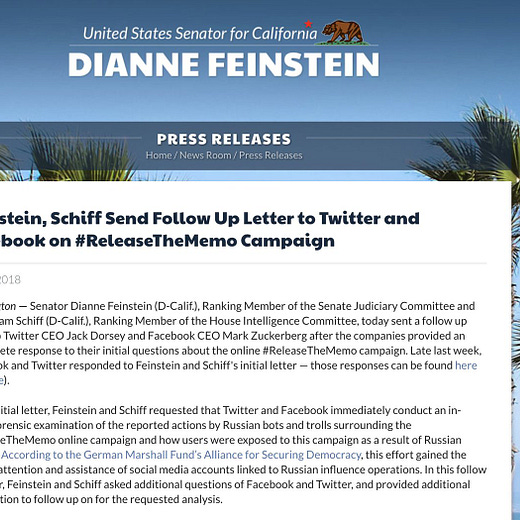
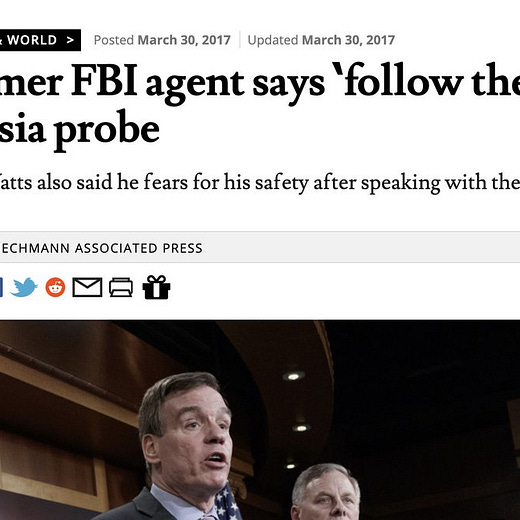
5:49 PM · Jan 27, 2023
71 Reposts · 252 Likes

Matt Taibbi@mtaibbi
40.The mix of digital McCarthyism and fraud did great damage to American politics and culture. News outlets that don't disavow these stories, or still pay Hamilton vets as analysts, shouldn't be trusted. Every subscriber to those outlets to write to editors about the issue.
5:49 PM · Jan 27, 2023
77 Reposts · 291 Likes

Matt Taibbi@mtaibbi
41.For more from the #TwitterFiles, follow @bariweiss, @lhfang, @ShellenbergerMD, @TheFP, and others. Twitter had no input into this story. Searches were conducted by a third party, so material may have been left out.
5:49 PM · Jan 27, 2023
42 Reposts · 257 Likes

Matt Taibbi@mtaibbi
42. For more on this story, read the detailed new story at racket.news
5:49 PM · Jan 27, 2023
43 Reposts · 303 Likes
Part XVI

Matt Taibbi@mtaibbi
TWITTER FILES #16
Comic Interlude: A Media Experiment

12:13 AM · Feb 19, 2023
1.38K Reposts · 2.96K Likes

Matt Taibbi@mtaibbi
2. The #TwitterFiles have revealed a lot: thousands of moderation requests from every corner of government, Feds mistaking both conservatives and leftists for fictional Russians, even Twitter deciding on paper to cede moderation authority to the “U.S. intelligence community”:

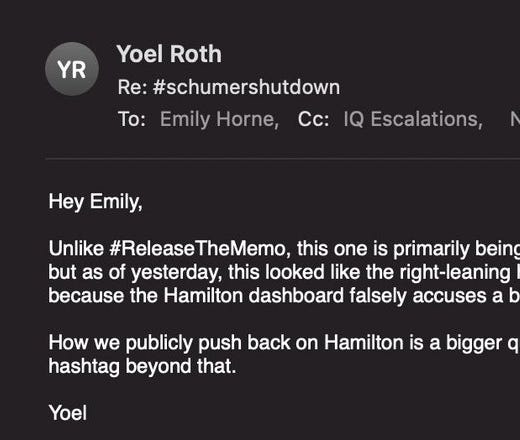
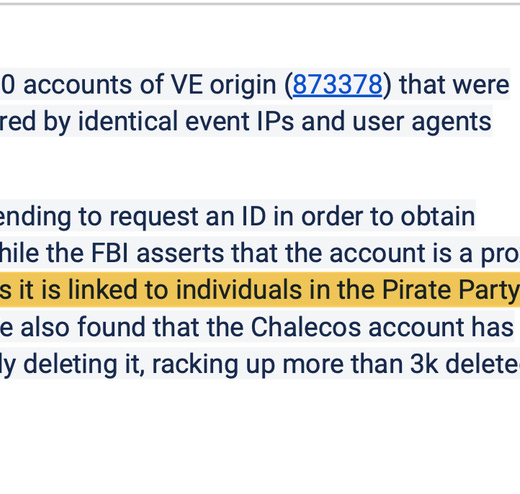

12:13 AM · Feb 19, 2023
269 Reposts · 1.06K Likes

Matt Taibbi@mtaibbi
3. These and at least a dozen other newsworthy revelations produced exactly zilch in mainstream news coverage in the last two months:

12:13 AM · Feb 19, 2023
169 Reposts · 1.01K Likes

Matt Taibbi@mtaibbi
4. Then House hearings were held last week, at which one witness told a story about Donald Trump asking to remove a mean tweet by Chrissy Teigen.
The press went bananas. Now THAT was big news!

12:13 AM · Feb 19, 2023
191 Reposts · 1.13K Likes

Matt Taibbi@mtaibbi
5. Purely to show the bankruptcy of media in this area, let’s introduce a pair of loud new data points, and see if any press figures at all cover either of them.
12:13 AM · Feb 19, 2023
147 Reposts · 958 Likes

Matt Taibbi@mtaibbi
6. If a president freaking out about one tweeter is news, surely a U.S. Senator finking on three hundred-plus of his constituents also must be?

12:13 AM · Feb 19, 2023
242 Reposts · 1.15K Likes

Matt Taibbi@mtaibbi
7. Here’s Maine Senator Angus King writing to Twitter to call a slew of accounts “suspicious” for reasons like:
“Rand Paul visit excitement”
“Bot (averages 20 tweets a day)”
Being followed by rival Eric Brakey
Or, my personal favorite: “Mentions immigration.”

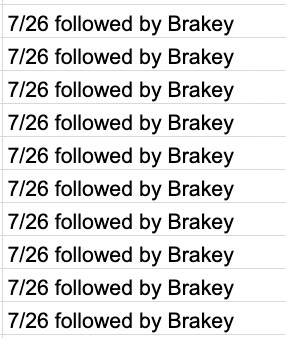


12:13 AM · Feb 19, 2023
270 Reposts · 1.15K Likes

Matt Taibbi@mtaibbi
8. King’s office declined comment. If Dick Nixon sniffed glue, this is what his enemies list might have looked like:
docs.google.com
Suspected Accounts.xlsx - Google Drive
12:13 AM · Feb 19, 2023
175 Reposts · 956 Likes

Matt Taibbi@mtaibbi
9. So as not to focus only on Dems or those who caucus with Democrats, here’s a contribution from Republican Mark Lenzi, a State Department official most famous for offering to donate his brain to science after a claimed brush with Havana syndrome.

12:13 AM · Feb 19, 2023
122 Reposts · 742 Likes

Matt Taibbi@mtaibbi
10. Lenzi wrote to Twitter bluntly asking to remove 14 accounts distinguished among other things by skepticism of Russiagate: “The below are some Russian controlled accounts that I think you will want to look into and delete.”

12:13 AM · Feb 19, 2023
188 Reposts · 818 Likes

Matt Taibbi@mtaibbi
11.A government official, writing from a State department email, asks to “delete” 14 accounts that are engaged in legit speech and for which no evidence is shown they're Russian controlled or bots (in fact, we at Racket know some of these people). A clear First Amendment issue.
12:13 AM · Feb 19, 2023
252 Reposts · 1.11K Likes

Matt Taibbi@mtaibbi
12. I noted before there were many crazy requests in Twitter records from officials wanting foes taken off Twitter, with Californian Adam Schiff’s effort to ban a reporter and stop “any and all search results” about a staffer making Angus King’s spreadsheet gambit look tame.

12:13 AM · Feb 19, 2023
221 Reposts · 800 Likes

Matt Taibbi@mtaibbi
13. The fact that mainstream outlets ignored the Schiff story but howled about Teigen shows what they're about. Responses like this are designed to keep blue-leaning audiences especially focused on moronic partisan spats, obscuring bigger picture narratives.
12:13 AM · Feb 19, 2023
243 Reposts · 1.03K Likes

Matt Taibbi@mtaibbi
14. The real story emerging in the #TwitterFiles is about a ballooning federal censorship bureaucracy that's not aimed at either the left or the right per se, but at the whole population of outsiders, who are being systematically defined as threats.
12:13 AM · Feb 19, 2023
246 Reposts · 966 Likes

Matt Taibbi@mtaibbi
15. Beginning in March, we'll start using the Twitter Files to tell this larger story about how Americans turned their counterterrorism machinery against themselves, to disastrous effect, through little-known federal agencies like the Global Engagement Center (GEC).
12:13 AM · Feb 19, 2023
273 Reposts · 1.09K Likes

Matt Taibbi@mtaibbi
16. Until then, if you found yourself on King's list, please DM or write in to Racket.News. I'm on vacation next week, but we'll mock up "Angus King Told Twitter I Was Suspicious, And All I Got Was This Lousy T-Shirt" shirts when I get back.
12:13 AM · Feb 19, 2023
109 Reposts · 797 Likes

Matt Taibbi@mtaibbi
17. Thanks to #TwitterFiles contributors like @ShellenbergerMD and @lhfang, and thanks also to Racket researchers. Searches were performed by a third party and material may have been left out.
12:13 AM · Feb 19, 2023
98 Reposts · 799 Likes
Part XVII

Matt Taibbi@mtaibbi
1. TWITTER FILES #17
New Knowledge, the Global Engagement Center, and State-Sponsored Blacklists

5:00 PM · Mar 2, 2023
1.3K Reposts · 2.39K Likes

Matt Taibbi@mtaibbi
2. On June 8, 2021, an analyst at the Atlantic Council’s Digital Forensic Research Lab wrote to Twitter:
“Hi guys. Attached you will find… around 40k twitter accounts that our researchers suspect are engaging in inauthentic behavior… and Hindu nationalism more broadly.”

5:00 PM · Mar 2, 2023
148 Reposts · 577 Likes

Matt Taibbi@mtaibbi
3. DFRLab said it suspected 40,000 accounts of being “paid employees or possibly volunteers” of India’s Bharatiya Janata Party (BJP).
But the list was full of ordinary Americans, many with no connection to India and no clue about Indian politics. docs.google.com/spreadsheets/d…

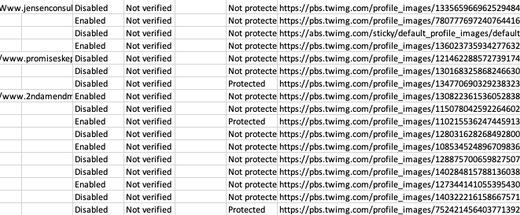
5:00 PM · Mar 2, 2023
158 Reposts · 588 Likes

Matt Taibbi@mtaibbi
4. “I have no connection to any Hindu folks... Just a Reagan Republican here in CT,” replied “Bobby Hailstone.”
“A Hindu nationalist? I’ve never even been out of this country. Let alone the state of NJ,” said “Lady_DI816.”
“These people are insane!” said “Krista Woods.”
5:00 PM · Mar 2, 2023
110 Reposts · 559 Likes

Matt Taibbi@mtaibbi
5. Twitter agreed, one reason many of the accounts remain active. “Thanks, Andy,” replied Trust and Safety chief Yoel Roth. “I spot-checked a number of these accounts, and virtually all appear to be real people.”

5:00 PM · Mar 2, 2023
83 Reposts · 494 Likes

Matt Taibbi@mtaibbi
6. Here’s the list. Are you on it?
docs.google.com/spreadsheets/d…
5:00 PM · Mar 2, 2023
128 Reposts · 469 Likes

Matt Taibbi@mtaibbi
7. DFRLab is funded by the U.S. Government, specifically the Global Engagement Center (GEC).
Director Graham Brookie denies DFRLab it uses tax money to track Americans, saying its GEC grants have "an exclusively international focus.”
5:00 PM · Mar 2, 2023
111 Reposts · 488 Likes

Matt Taibbi@mtaibbi
8. But Americans on DFR’s list, like Marysel Urbanik, are unconvinced its focus is “exclusively international.”
“This is un-American,” says Urbanik, who immigrated from Castro’s Cuba. “They do this in places that don’t believe in free speech.”

5:00 PM · Mar 2, 2023
108 Reposts · 506 Likes

Matt Taibbi@mtaibbi
9. The Global Engagement Center is usually listed as a State Department entity.
It's not.
Created in Obama’s last year, GEC is an interagency group “within” State, whose initial partners included FBI, DHS, NSA, CIA, DARPA, Special Operations Command (SOCOM), and others.

5:00 PM · Mar 2, 2023
193 Reposts · 560 Likes

Matt Taibbi@mtaibbi
10. GEC’s mandate: “To recognize, understand, expose, and counter foreign... disinformation.”
On the surface, it’s the same mission the United States Information Agency (USIA) fulfilled for decades, with a catch. USIA focused on foreign “disinfo.”
GEC’s focus is wider.

5:00 PM · Mar 2, 2023
106 Reposts · 460 Likes

Matt Taibbi@mtaibbi
11. “It’s an incubator for the domestic disinformation complex,” says a former intelligence source. “All the shit we pulled in other countries since the Cold War, some morons decided to bring home.”
5:00 PM · Mar 2, 2023
165 Reposts · 576 Likes

Matt Taibbi@mtaibbi
12.GEC could have avoided controversy by focusing on exposing/answering “disinformation” with research and a more public approach, as USIA did. Instead, it funded a secret list of subcontractors and helped pioneer an insidious – and idiotic – new form of blacklisting.
5:00 PM · Mar 2, 2023
108 Reposts · 478 Likes

Matt Taibbi@mtaibbi
13.Here GEC asks Twitter to review 499 accounts as “foreign” disinformation, for reasons that include using Signal to communicate and tweeting the hashtag, #IraniansDebateWithBiden.
docs.google.com/spreadsheets/d…

5:00 PM · Mar 2, 2023
93 Reposts · 423 Likes

Matt Taibbi@mtaibbi
14. Here are 5500 names GEC told Twitter it believed were “Chinese… accounts” engaged in “state-backed coordinated manipulation.” It takes about negative ten seconds to find non-Chinese figures: docs.google.com/spreadsheets/u…

5:00 PM · Mar 2, 2023
95 Reposts · 424 Likes

Matt Taibbi@mtaibbi
15. GEC’s “Chinese” list included multiple Western government accounts and at least three CNN employees based abroad. “Not exactly Anderson’s besties, but CNN assets if you will,” quipped Twitter’s Patrick Conlon.
"A total crock,” added Trust and Safety chief Yoel Roth.
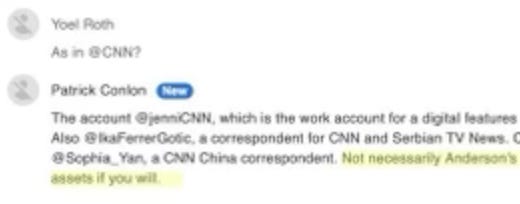

5:00 PM · Mar 2, 2023
99 Reposts · 428 Likes

Matt Taibbi@mtaibbi
16.GEC passed some good information to Twitter, but mostly not. The root problem was exemplified by a much-circulated 2020 report, “Russian Pillars of Disinformation and Propaganda.”
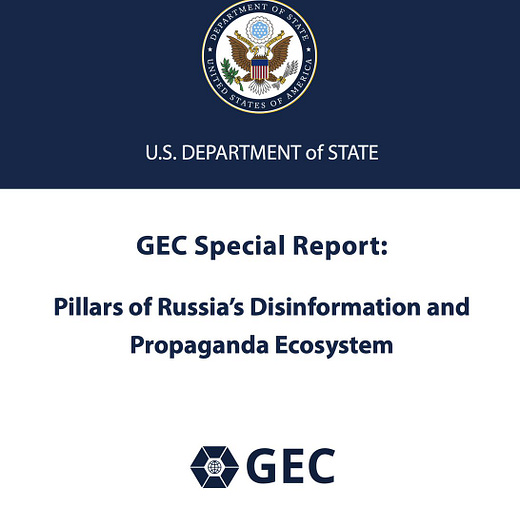
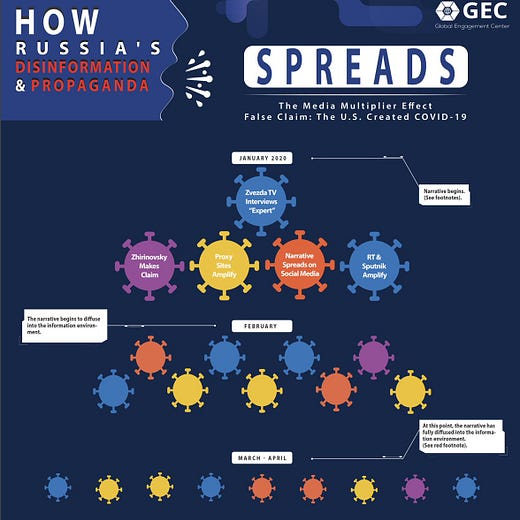
5:00 PM · Mar 2, 2023
87 Reposts · 414 Likes

Matt Taibbi@mtaibbi
17.This GEC report was contradictory. On one hand, it offered reasoned evidence that a specific outlet like the “Strategic Culture Foundation” was partnered with the Russian Foreign Ministry, which would make it a true "proxy site."

5:00 PM · Mar 2, 2023
77 Reposts · 379 Likes

Matt Taibbi@mtaibbi
18.The same report advanced a far lazier idea.
Along with state actors, groups that “generate their own momentum” should also be seen as parts of a propaganda “ecosystem."
Independence, GEC said, should not “confuse those trying to discern the truth.”
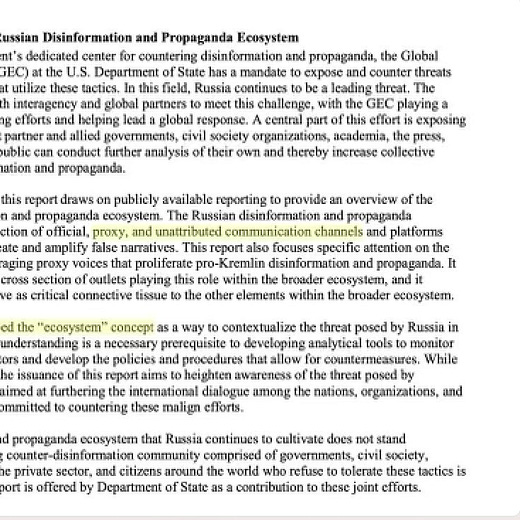
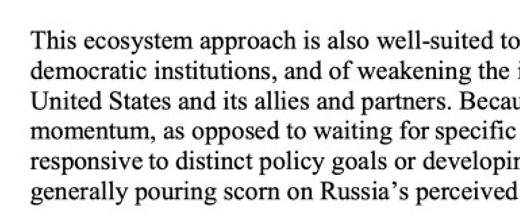
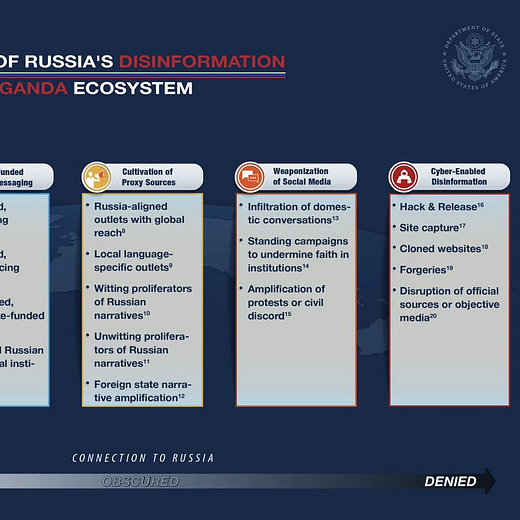
5:00 PM · Mar 2, 2023
80 Reposts · 380 Likes

Matt Taibbi@mtaibbi
19. The “ecosystem” is not a new concept. It’s been with us since Salem: guilt by association.
As one Twitter exec put it: “‘If you retweet a news source linked to Russia, you become Russia-linked,’ does not exactly resonate as a sound research approach.”

5:00 PM · Mar 2, 2023
96 Reposts · 433 Likes

Matt Taibbi@mtaibbi
20.GEC sent Twitter a series of reports on a series of topics, often employing the “ecosystem” concept.
Its report on France “attributes membership in the yellow vest movement as being Russia-aligned,” is how Twitter’s Aaron Rodericks put it.
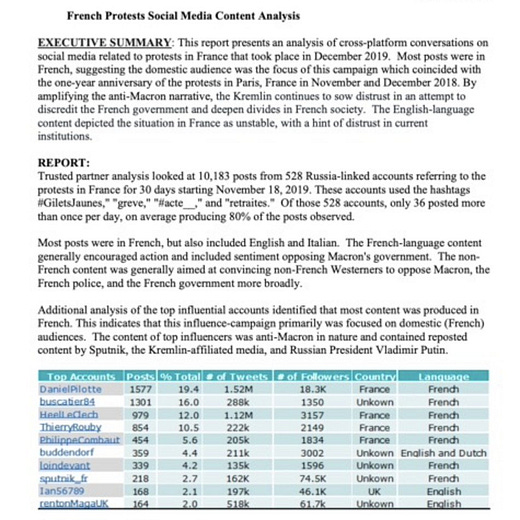
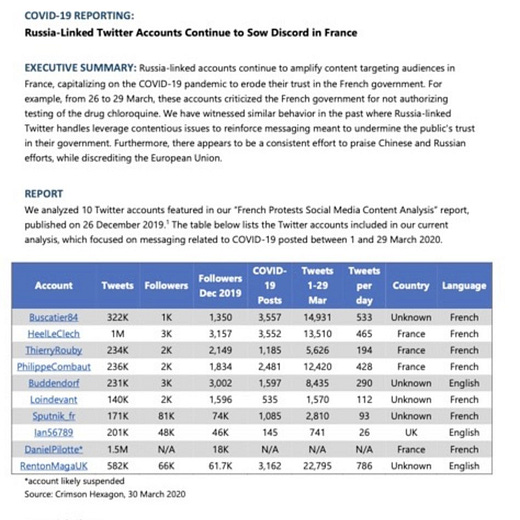
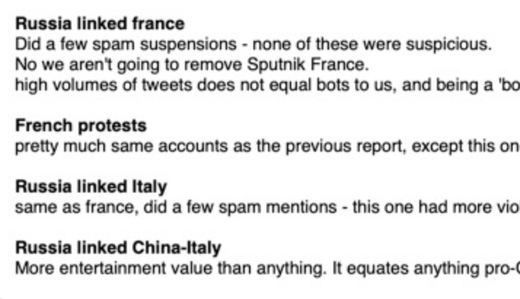
5:00 PM · Mar 2, 2023
85 Reposts · 375 Likes

Matt Taibbi@mtaibbi
21.GEC’s report on China was “more entertainment value than anything,” said Rodericks. “It equates anything pro-China, but also anything against China in Italy, as part of Russia's strategy.”
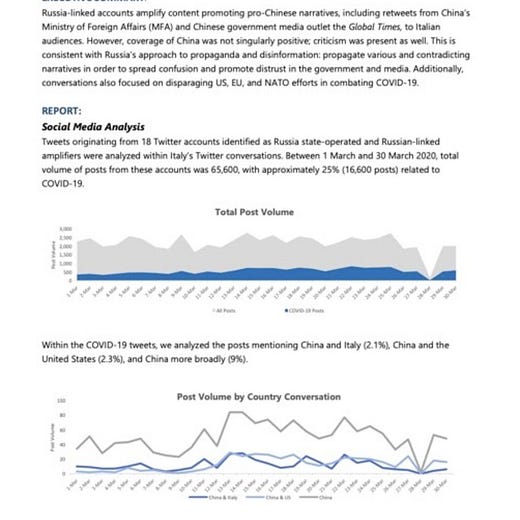
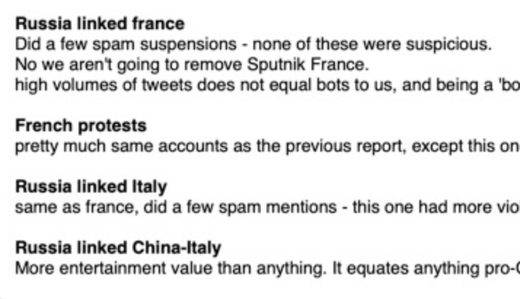
5:00 PM · Mar 2, 2023
70 Reposts · 359 Likes

Matt Taibbi@mtaibbi
22. Twitter staffers had professionalism. They tended to look at least once before declaring a thing foreign disinformation. This made them a tough crowd for GEC.
Fortunately, there's an easier mark: the news media.
5:00 PM · Mar 2, 2023
72 Reposts · 404 Likes

Matt Taibbi@mtaibbi
23.GEC’s game: create an alarmist report, send it to the slower animals in journalism’s herd, and wait as reporters bang on Twitter’s door, demanding to know why this or that “ecosystem” isn’t obliterated.
Twitter emails ooze frustration at such queries. UGGG! reads one.
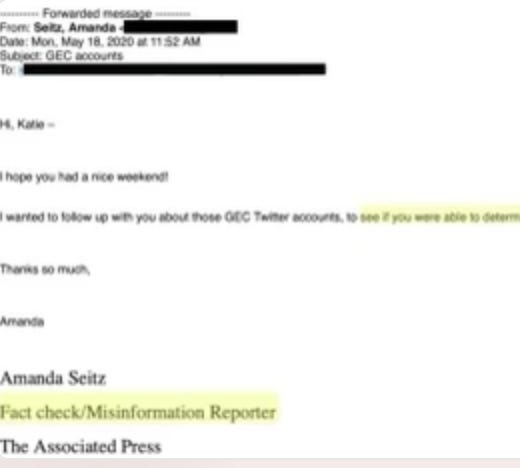
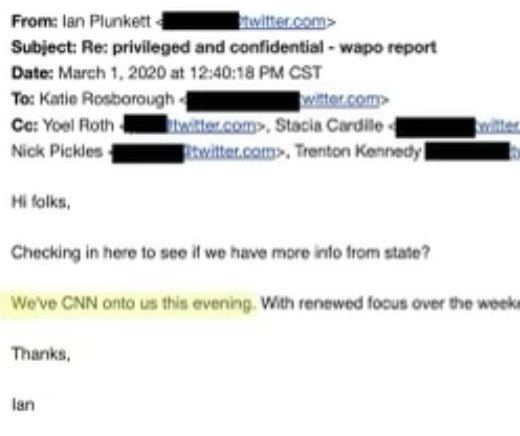
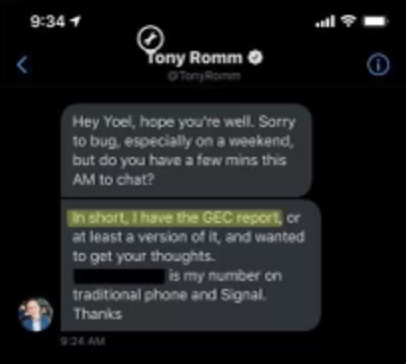
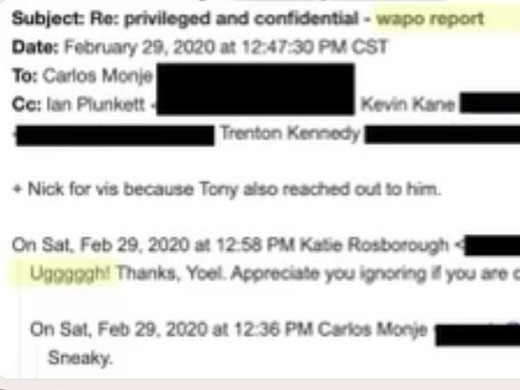
5:00 PM · Mar 2, 2023
106 Reposts · 408 Likes

Matt Taibbi@mtaibbi
25.Twitter disagreed with GEC’s alert about Russian “disinfo” in South America, which appeared to confused cause and effect.
As Rodericks put it, “I believe what they mean is: ‘there was a surge in accounts that agreed with Moscow-aligned narratives' = Moscow controlled.”

5:00 PM · Mar 2, 2023
67 Reposts · 346 Likes

Matt Taibbi@mtaibbi
26. Roth noted Bret Schafer of the Alliance for Securing Democracy was quoted in Frenkel’s story and said: “Seems like ASD are back at their old tricks.”

5:00 PM · Mar 2, 2023
62 Reposts · 337 Likes

Matt Taibbi@mtaibbi
27. Roth was referring to the fact that the ASD created Hamilton 68, another guilt-by-association scheme detailed in Twitter Files #15. The Hamilton “dashboard” claimed to track accounts linked to “Russian influence activities,” but the list was largely made up of Americans.

5:00 PM · Mar 2, 2023
77 Reposts · 359 Likes

Matt Taibbi@mtaibbi
28. The Hamilton 68 dashboard creator, J.M. Berger, was on the GEC payroll until June of 2017, just before the dashboard’s launch. Hamilton claimed the list was “the fruit of more than three years of observation.”
Berger “unequivocally” denies working on Hamilton for GEC.

5:00 PM · Mar 2, 2023
76 Reposts · 351 Likes

Matt Taibbi@mtaibbi
30. The Hamilton 68 dashboard employed digital alchemy to create streams of headlines tying Americans to “foreign” disinformation.
The “ecosystem” reports GEC and many "disinformation" laboratories feed reporters are often just subtler versions of the same thing.
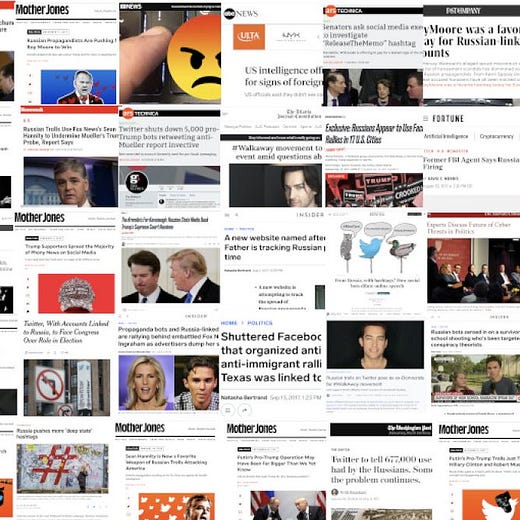
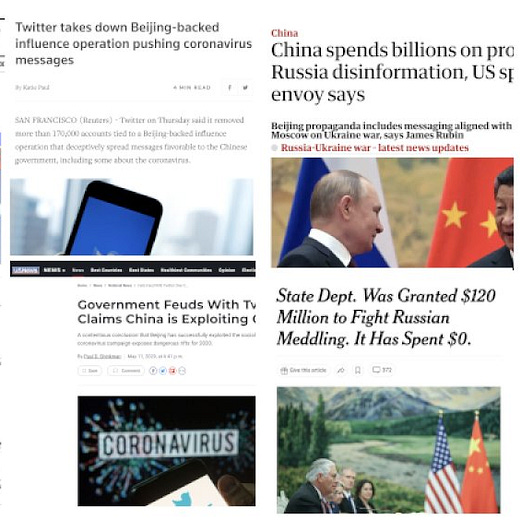
5:00 PM · Mar 2, 2023
80 Reposts · 361 Likes

Matt Taibbi@mtaibbi
31. In a crucial in-house Q&A in mid-2017, Roth was asked if it was possible to detect “Russian fingerprints” using Twitter’s public data. Though “you can make inferences,” he said, “in short, no.”

5:00 PM · Mar 2, 2023
61 Reposts · 332 Likes

Matt Taibbi@mtaibbi
32. Twitter therefore knew from the first days of the “foreign interference” mania that the media zone was flooded with bad actors playing up cyber-threats for political or financial reasons, GEC included.
5:00 PM · Mar 2, 2023
77 Reposts · 372 Likes

Matt Taibbi@mtaibbi
33. “GEC has doubled their budget by aggressively overstating threats through unverified accusations that can't be replicated either by external academics or by Twitter,” wrote Rodericks.

5:00 PM · Mar 2, 2023
71 Reposts · 356 Likes

Matt Taibbi@mtaibbi
34.The same is true of New Knowledge, the scandal-plagued company staffed by former NSA officials that the Senate Select Committee on Intelligence (SSCI) hired to do “expert” assessments of the initial batches of “suspect” Facebook and Twitter accounts.

5:00 PM · Mar 2, 2023
58 Reposts · 244 Likes

Matt Taibbi@mtaibbi
35. When Twitter saw New Knowledge and its reporter-worshipped “disinformation” gurus like Jonathon Morgan and Renee DiResta were making analytical leaps they felt were impossible, they knew something was off.
5:00 PM · Mar 2, 2023
44 Reposts · 234 Likes

Matt Taibbi@mtaibbi
36. After Politico cited a New Knowledge report to the SSCI as evidence for what it called a “sweeping effort to sow divisions,” Twitter dug in. NK pointed to five supposedly Russian accounts it said were “relatively easy to find with the Twitter public API."
Roth scoffed.
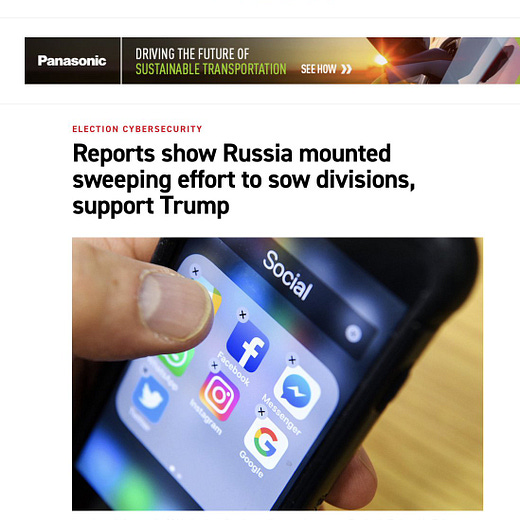
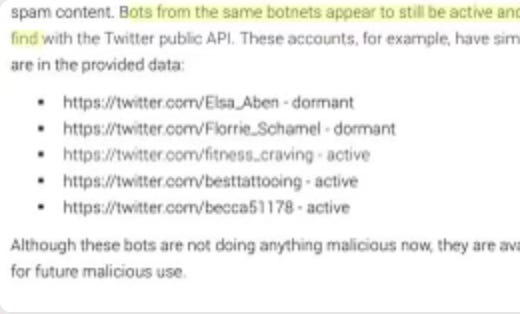
5:00 PM · Mar 2, 2023
40 Reposts · 226 Likes

Matt Taibbi@mtaibbi
37. Roth said two of the five accounts were a “small Indonesian content farm… just commercial spam. (Would suspend but don’t want to throw fire on the NK report by making anyone think they’re correct.) Becca account is an American and not at all suspicious.”

5:00 PM · Mar 2, 2023
44 Reposts · 221 Likes

Matt Taibbi@mtaibbi
38.Twitter’s Nick Pickles: “New Knowledge’s pitch... pick accounts that they have deemed to be IRA controlled, and then spin up bigger macro analysis... stories about ‘2000 Russian accounts tweeting about Kavanagh/Walkway/Caravan’ [were] often based on media activity from NK.”

5:00 PM · Mar 2, 2023
48 Reposts · 222 Likes

Matt Taibbi@mtaibbi
39. Just like Hamilton 68, GEC and New Knowledge littered the media landscape with flawed or flat-out wrong news stories. Exacerbating matters, Americans in both cases paid taxes to become the subject of these manipulative operations.
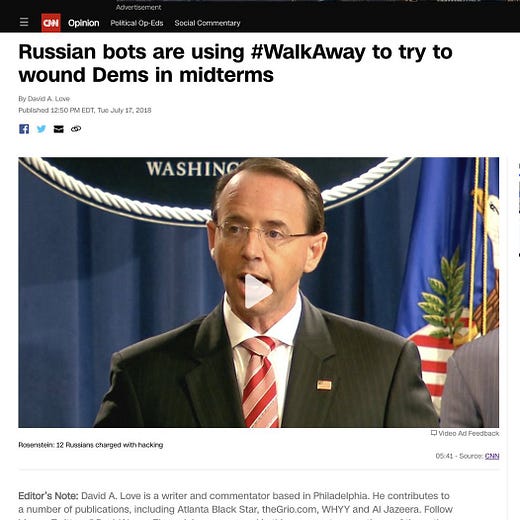

5:00 PM · Mar 2, 2023
70 Reposts · 264 Likes

Matt Taibbi@mtaibbi
40. Particularly egregious: a New Knowledge report to the Senate on Russian interference was leaked just days before it was outed in a scheme to fake Russian influence in an Alabama election, and no media outlets issued retractions.
No SSCI staff have commented, either.

5:00 PM · Mar 2, 2023
67 Reposts · 245 Likes

Matt Taibbi@mtaibbi
41. Foreign cyber-threats exist, and there are sophisticated ways of detecting them. But GEC and its subcontractors don’t use those, instead deploying junk science that often lumps true bad actors in with organic opinion.
5:00 PM · Mar 2, 2023
45 Reposts · 224 Likes

Matt Taibbi@mtaibbi
42.“Disinformation studies” has mostly become a con, where non-experts mesmerize reporters with what one former GEC staffer calls “hairball” charts, usually measuring something idiotic – like who follows two Chinese diplomats, or shares an Iranian “FREE PALESTINE” meme.
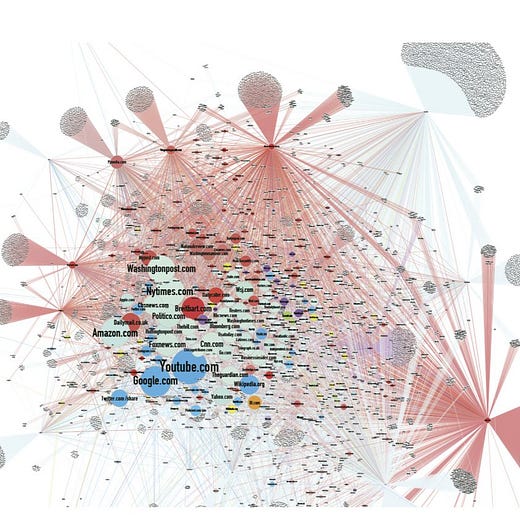


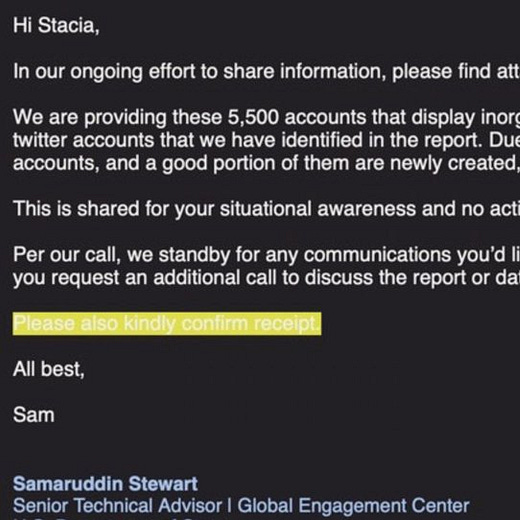
5:00 PM · Mar 2, 2023
58 Reposts · 260 Likes

Matt Taibbi@mtaibbi
43.The Washington Examiner and @gekaminsky just profiled a GEC-funded NGO in the UK that algorithmically scores media outlets by "risk."
How does downranking the Daily Wire to help the New York Times get more ad revenue counter “foreign” disinformation?

5:00 PM · Mar 2, 2023
70 Reposts · 264 Likes

Matt Taibbi@mtaibbi
44.An IG report shows GEC was initially obligated $98.7 million, of which roughly $80 million came from the Pentagon. It reportedly gave to at least 39 different organizations, whose names were redacted.
Why is this list secret?
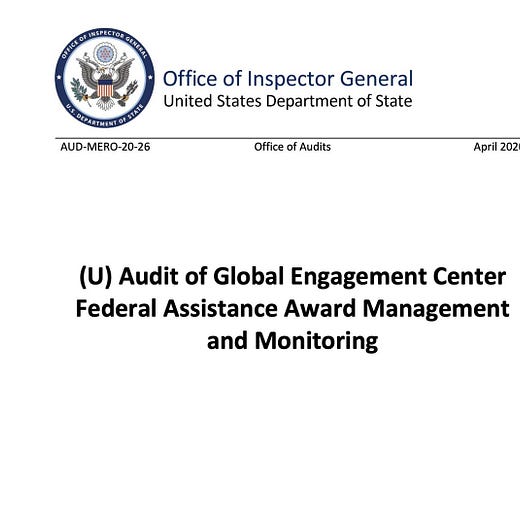
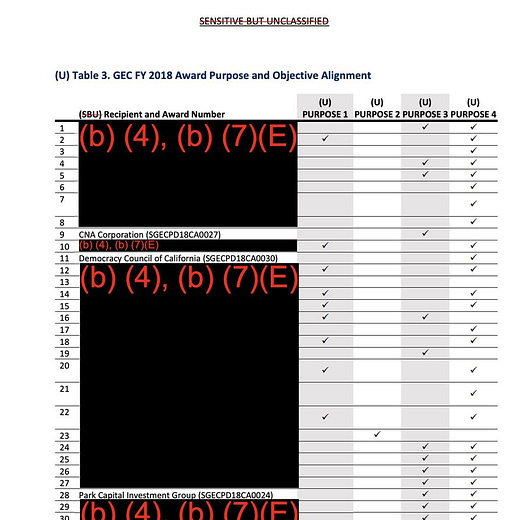
5:00 PM · Mar 2, 2023
96 Reposts · 272 Likes

Matt Taibbi@mtaibbi
45. Twitter comms official Ian Plunkett wrote years ago that “misinformation, like [countering violent extremism, or CVE] before it, is becoming a cottage industry.”
Disinformation is the counterterrorism mission, rebranded for domestic targets.

5:00 PM · Mar 2, 2023
43 Reposts · 215 Likes

Matt Taibbi@mtaibbi
46. Reauthorization for GEC’s funding is up for a vote this year. Can we at least stop paying to blacklist ourselves?
5:00 PM · Mar 2, 2023
86 Reposts · 319 Likes

Matt Taibbi@mtaibbi
47. The #TwitterFiles were prepared by a third party, so material may have been left out. Thanks to @ShellenbergerMD and the team at Racket.News, who’ll have more on this all month.
5:00 PM · Mar 2, 2023
45 Reposts · 244 Likes

Matt Taibbi@mtaibbi
48. NOTE: Just before publication, Graham Brookie of DFRLab wrote to clarify about the 40,000 India names: “We didn’t publish this from a former researcher because we lacked confidence in its findings.”

5:00 PM · Mar 2, 2023
43 Reposts · 206 Likes

Matt Taibbi@mtaibbi
49. I asked Brookie if he’d made this lack of confidence clear to the Reuters reporter whose story based on that research is still live and uncorrected online: reuters.com/article/facebo…
He hasn’t replied.

5:00 PM · Mar 2, 2023
64 Reposts · 322 Likes

Matt Taibbi@mtaibbi
50. For more on these and other #TwitterFiles topics, @ShellenbergerMD and I will be testifying in the House on Thursday, March 9, at 10 a.m. We're humbled and grateful to @Jim_Jordan and @JudiciaryGOP for the invitation.
5:00 PM · Mar 2, 2023
153 Reposts · 565 Likes
Part XIX

Matt Taibbi@mtaibbi
1.TWITTER FILES #19
The Great Covid-19 Lie Machine
Stanford, the Virality Project, and the Censorship of “True Stories”

2:00 PM · Mar 17, 2023
11.6K Reposts · 23.1K Likes

Matt Taibbi@mtaibbi
2.“The release of Dr. Anthony Fauci’s Spring 2020 emails… has been used to exacerbate distrust in Dr. Fauci.”
“Increased distrust in Fauci’s expert guidance.”
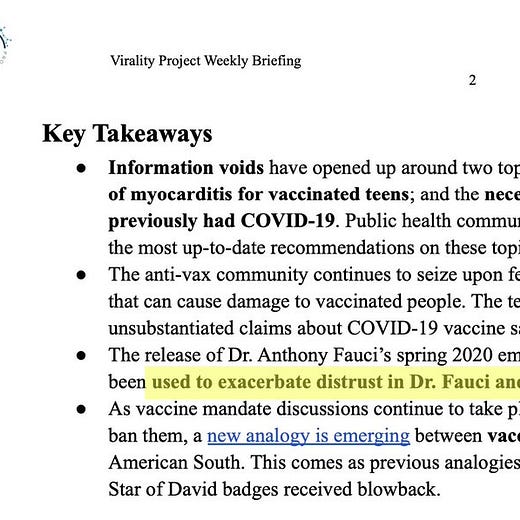
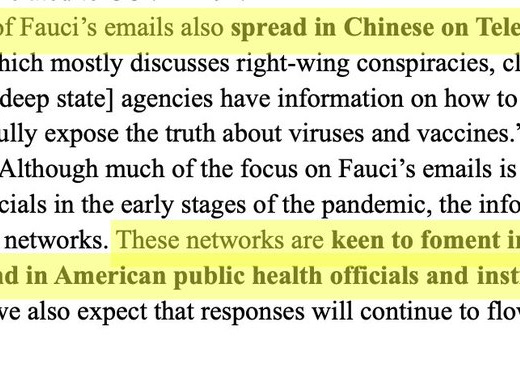
2:00 PM · Mar 17, 2023
1.13K Reposts · 5.11K Likes

Matt Taibbi@mtaibbi
3.“Reports of vaccinated individuals contracting Covid-19 anyway”; “natural immunity”; suggesting Covid-19 “leaked from a lab”; even “worrisome jokes”:
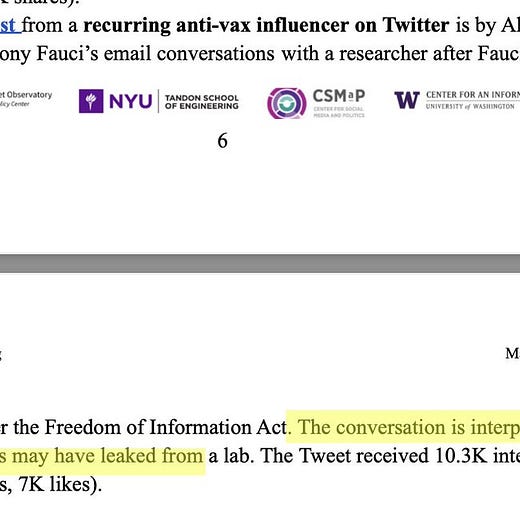
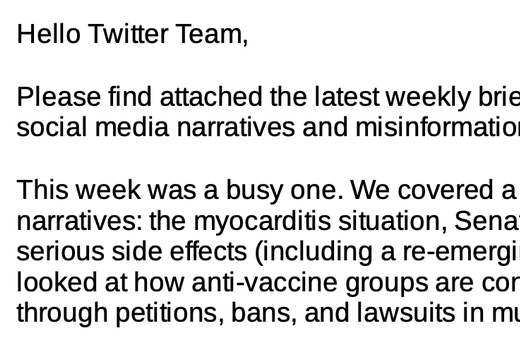
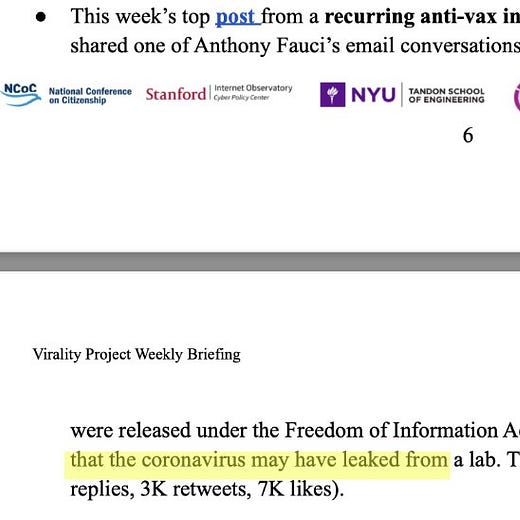

2:00 PM · Mar 17, 2023
1.06K Reposts · 4.85K Likes

Matt Taibbi@mtaibbi
4.All were characterized as “potential violations” or disinformation “events” by the Virality Project, a sweeping, cross-platform effort to monitor billons of social media posts by Stanford University, federal agencies, and a slew of (often state-funded) NGOs.
2:00 PM · Mar 17, 2023
1.02K Reposts · 4.9K Likes

Matt Taibbi@mtaibbi
5.Just before @ShellenbergerMD and I testified in the House last week, Virality Project emails were found in the #TwitterFiles describing “stories of true vaccine side effects” as actionable content.

2:00 PM · Mar 17, 2023
1.37K Reposts · 5.3K Likes

Matt Taibbi@mtaibbi
6.We’ve since learned the Virality Project in 2021 worked with government to launch a pan-industry monitoring plan for Covid-related content. At least six major Internet platforms were “onboarded” to the same JIRA ticketing system, daily sending millions of items for review.
2:00 PM · Mar 17, 2023
1K Reposts · 4.45K Likes

Matt Taibbi@mtaibbi
7.Though the Virality Project reviewed content on a mass scale for Twitter, Google/YouTube, Facebook/Instagram, Medium, TikTok, and Pinterest, it knowingly targeted true material and legitimate political opinion, while often being factually wrong itself.
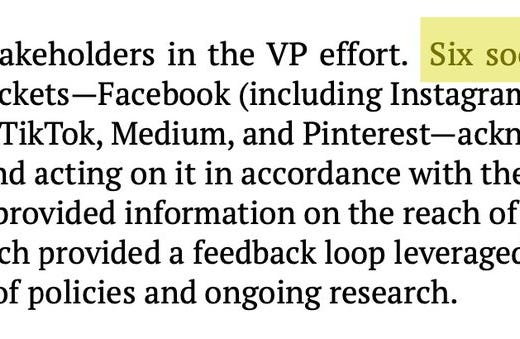
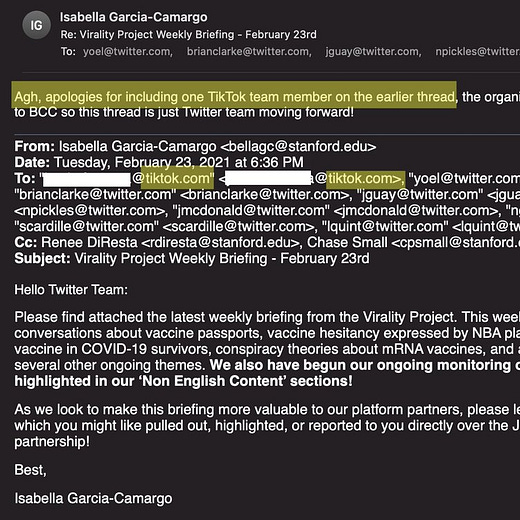
2:00 PM · Mar 17, 2023
1.18K Reposts · 4.61K Likes

Matt Taibbi@mtaibbi
8.This story is important for two reasons. One, as Orwellian proof-of-concept, the Virality Project was a smash success. Government, academia, and an oligopoly of would-be corporate competitors organized quickly behind a secret, unified effort to control political messaging.
2:00 PM · Mar 17, 2023
1.5K Reposts · 5.63K Likes

Matt Taibbi@mtaibbi
9.Two, it accelerated the evolution of digital censorship, moving it from judging truth/untruth to a new, scarier model, openly focused on political narrative at the expense of fact.
2:00 PM · Mar 17, 2023
1.2K Reposts · 5.23K Likes

Matt Taibbi@mtaibbi
10.THE BEGINNING: On February 5, 2021, just after Joe Biden took office, Stanford wrote to Twitter to discuss the Virality Project. By the 17th, Twitter agreed to join and got its first weekly report on “anti-vax disinformation,” which contained numerous true stories.

2:00 PM · Mar 17, 2023
1.19K Reposts · 4.39K Likes

Matt Taibbi@mtaibbi
11. February 22, 2021: Stanford welcomed Twitter veterans like Yoel Roth and Brian Clarke, instructing them on how to join the group JIRA system. You can watch the friendly welcome video here:
stanford.zoom.us
Video Conferencing, Web Conferencing, Webinars, Screen Sharing

2:00 PM · Mar 17, 2023
786 Reposts · 3.75K Likes

Matt Taibbi@mtaibbi
12. March 2, 2021: "We are beginning to ramp up our notification process to platforms.” In addition to the top-7 platforms, VP soon gained "visibility" to “alternative platforms such as Gab, Parler, Telegram, and Gettr” – near-total surveillance of the social media landscape.

2:00 PM · Mar 17, 2023
883 Reposts · 3.75K Likes

Matt Taibbi@mtaibbi
13.Through July of 2020, Twitter’s internal guidance on Covid-19 required a story be “demonstrably false” or contain an “assertion of fact” to be actioned. But the Virality Project, in partnership with the CDC, pushed different standards.
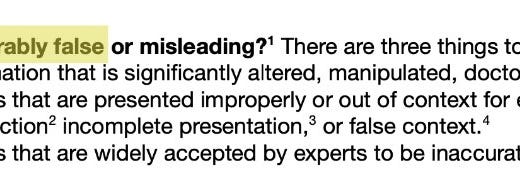

2:00 PM · Mar 17, 2023
773 Reposts · 3.67K Likes

Matt Taibbi@mtaibbi
14.VP told Twitter that “true stories that could fuel hesitancy,” including things like “celebrity deaths after vaccine” or the closure of a central NY school due to reports of post-vaccine illness, should be considered "Standard Vaccine Misinformation on Your Platform."

2:00 PM · Mar 17, 2023
1.52K Reposts · 4.7K Likes

Matt Taibbi@mtaibbi
15. In one email to Twitter, VP addressed what it called the “vaccine passport narrative,” saying “concerns” over such programs “have driven a larger anti-vaccination narrative about the loss of rights and freedoms.”
This was framed as a "misinformation" event.

2:00 PM · Mar 17, 2023
1.02K Reposts · 4.15K Likes

Matt Taibbi@mtaibbi
16.VP routinely framed real testimonials about side effects as misinformation, from “true stories” of blood clots from AstraZeneca vaccines to a New York Times story about vaccine recipients who contracted the blood disorder thrombocytopenia.
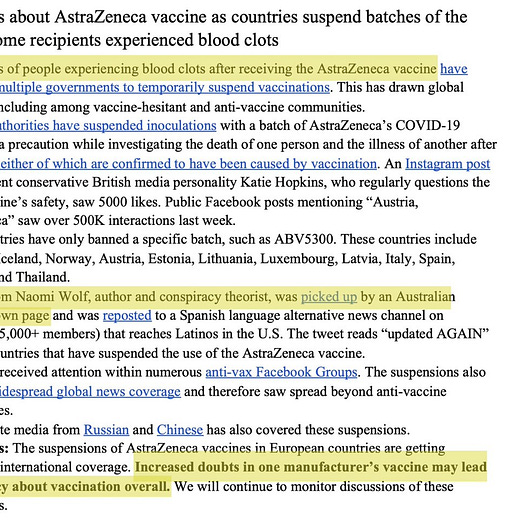
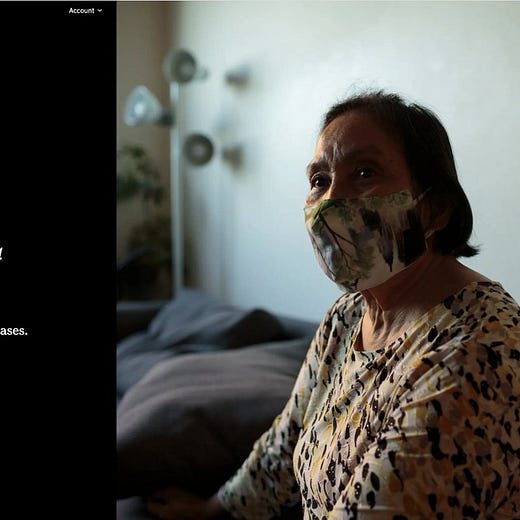
2:00 PM · Mar 17, 2023
1.04K Reposts · 4.1K Likes

Matt Taibbi@mtaibbi
17.By March of 2021, Twitter personnel were aping VP language, describing "campaigns against vaccine passports," "fear of mandatory immunizations," and "misuse of official reporting tools" as "potential violations."

2:00 PM · Mar 17, 2023
787 Reposts · 3.61K Likes

Matt Taibbi@mtaibbi
18. This echoed a report to Twitter by the Global Engagement Center re “Russia-linked” accounts: “While this account posts legitimate and accurate COVID-19 updates... it posts content that attacks Italian politicians, the EU, and the United States.” drive.google.com/file/d/1u2412d…

2:00 PM · Mar 17, 2023
679 Reposts · 3.35K Likes

Matt Taibbi@mtaibbi
19.That same GEC report found in the #TwitterFiles identified former Italian Prime Minister Giuseppe Conte, and former Italian Democratic Party Secretary Nicola Zingaretti (who’s been compared to Bernie Sanders) as “highly connective” accounts in a “Russia-linked” network.
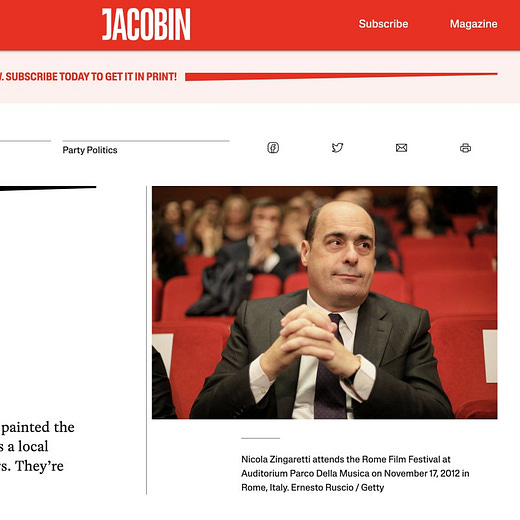
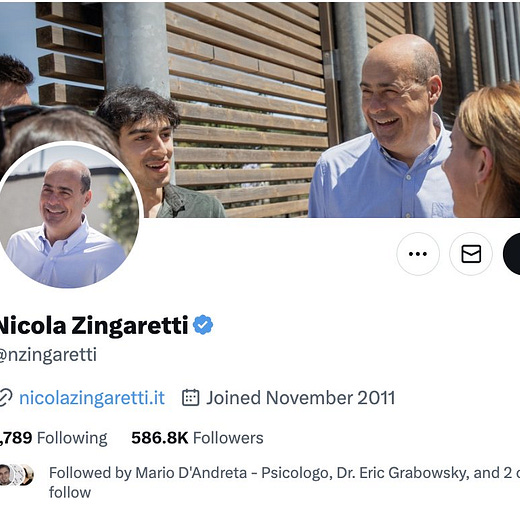
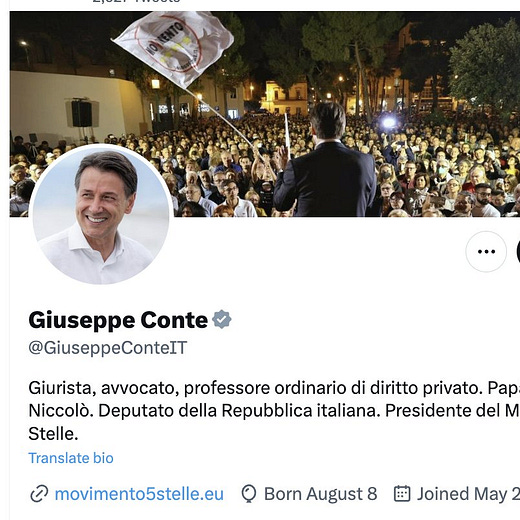
2:00 PM · Mar 17, 2023
587 Reposts · 3.17K Likes

Matt Taibbi@mtaibbi
20.The Virality Project helped pioneer the gauging of “disinformation” by audience response. If the post-vaccine death of a black woman named Drene Keyes in Virginia went unnoticed inspired mostly “anti-vaccine” comments on local media, it became a “disinformation” event.

2:00 PM · Mar 17, 2023
774 Reposts · 3.47K Likes

Matt Taibbi@mtaibbi
21.VP warned against people “just asking questions,” implying it was a tactic “commonly used by spreaders of misinformation." It also described a "Worldwide Rally for Freedom planned over Telegram" as a disinformation event.
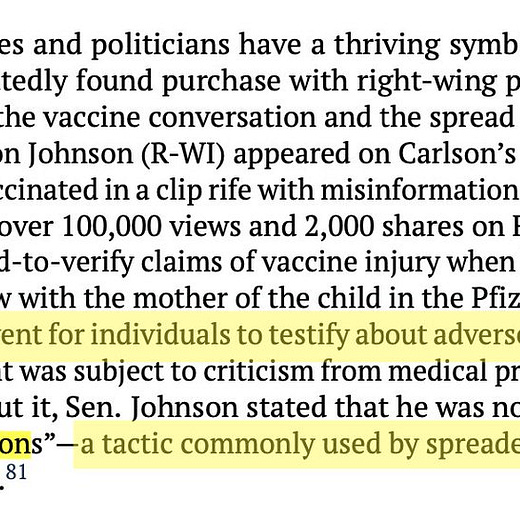
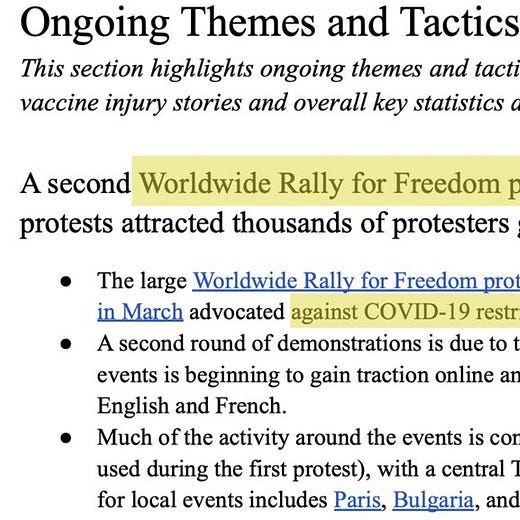
2:00 PM · Mar 17, 2023
883 Reposts · 3.7K Likes

Matt Taibbi@mtaibbi
22."ALMOST ALWAYS REPORTABLE" It encouraged platforms to target people, not posts, using Minority Report-style “pre-crime” logic. Describing “repeat offenders” like Robert Kennedy, Jr., it spoke of a “large volume of content that is almost always reportable.”

2:00 PM · Mar 17, 2023
910 Reposts · 3.74K Likes

Matt Taibbi@mtaibbi
23.VP was repeatedly, extravagantly wrong. In one email to Twitter on “misinformation,” it spoke of wanting to “hone in” on an “increasingly popular narrative about natural immunity.”

2:00 PM · Mar 17, 2023
904 Reposts · 3.69K Likes

Matt Taibbi@mtaibbi
24.The VP in April 2021 mistakenly described “breakthrough” infections as “extremely rare events” that should not be inferred to mean “vaccines are ineffective.”

2:00 PM · Mar 17, 2023
764 Reposts · 3.48K Likes

Matt Taibbi@mtaibbi
25.Later, when “the CDC changed its methodology for counting Covid-19 cases among vaccinated people,” only counting those resulting in hospitalization or death, VP complained that “anti-vaccine” accounts RFK Jr. and “WhatsHerFace” retweeted the story to suggest “hypocrisy.”

2:00 PM · Mar 17, 2023
758 Reposts · 3.4K Likes

Matt Taibbi@mtaibbi
26.A few months later: “Breakthrough cases are happening.”

2:00 PM · Mar 17, 2023
635 Reposts · 3.26K Likes

Matt Taibbi@mtaibbi
27.In a chilling irony, the VP ran searches for the term “surveillance state.” As an unaccountable state-partnered bureaucracy secretly searched it out, the idea that “vaccines are part of a surveillance state” won its own thoughtcrime bucket: “conspiracy.”

2:00 PM · Mar 17, 2023
941 Reposts · 3.73K Likes

Matt Taibbi@mtaibbi
28.After about a year, on April 26, 2022, the VP issued a report calling for a “rumor-control mechanism to address nationally trending narratives,” and a “Misinformation and Disinformation Center of Excellence” to be housed within CISA, at the Department of Homeland Security.
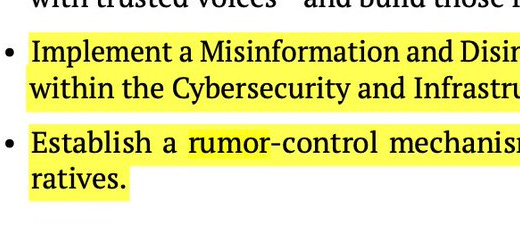
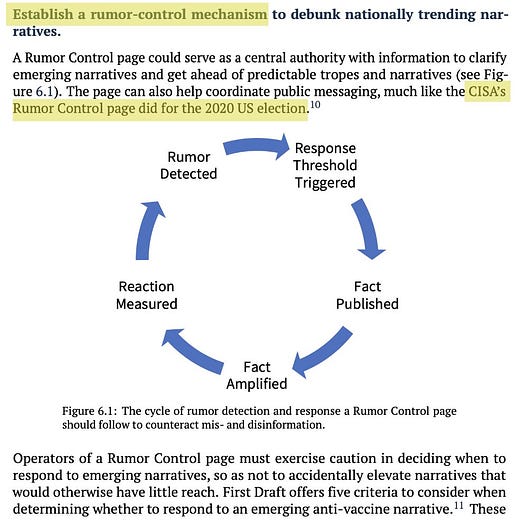
2:00 PM · Mar 17, 2023
802 Reposts · 3.28K Likes

Matt Taibbi@mtaibbi
29. The next day, April 27, 2022, DHS Secretary Alejandro Mayorkas announced in a House Appropriations Subcommittee hearing that a “Disinformation Governance Board” had been created, to be headed by the singing censor, Nina Jankowitz.
youtube.com
“She is the Executive Director of the Disinformation Governance Board”

2:00 PM · Mar 17, 2023
740 Reposts · 3.31K Likes

Matt Taibbi@mtaibbi
30.Even in its final report, VP claimed it was misinformation to suggest the vaccine does not prevent transmission, or that governments are planning to introduce vaccine passports. Both things turned out to be true.
2:00 PM · Mar 17, 2023
907 Reposts · 3.75K Likes

Matt Taibbi@mtaibbi
31.The Virality Project was specifically not based on “assertions of fact,” but public submission to authority, acceptance of narrative, and pronouncements by figures like Anthony Fauci. The project's central/animating concept was, "You can't handle the truth."
2:00 PM · Mar 17, 2023
1.03K Reposts · 4.05K Likes

Matt Taibbi@mtaibbi
32. One of its four core partners, Pentagon-funded Graphika, explained in a report about “Fauxi” that because the public cannot be trusted to make judgements on its own, it must be shielded from truths that might undermine its faith in authority.

2:00 PM · Mar 17, 2023
675 Reposts · 2.35K Likes

Matt Taibbi@mtaibbi
33. “This continual process of seeding doubt and uncertainty in authoritative voices,” Graphika wrote, in a report sent to Twitter, “leads to a society that finds it too challenging to identify what’s true or false.”

2:00 PM · Mar 17, 2023
480 Reposts · 2.1K Likes

Matt Taibbi@mtaibbi
34.For this reason, the CDC-partnered project focused often on disinformation “events” involving Fauci, saying “release of Fauci’s emails foments distrust,” and deriding assertions he “misled the public.”

2:00 PM · Mar 17, 2023
438 Reposts · 2.04K Likes

Matt Taibbi@mtaibbi
35.A Cleveland Clinic study showed previous infection offered the “same immunity” as the vaccine, but VP said discovery was susbservient to narrative: “Whether or not... scientific consensus is changing, ‘natural immunity’ is a key narrative… among anti-vaccine activists.”
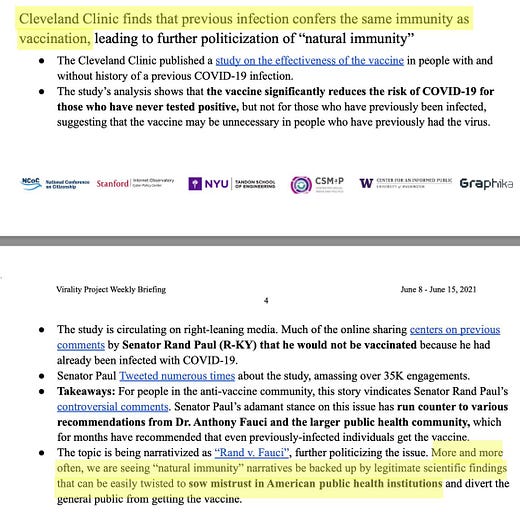
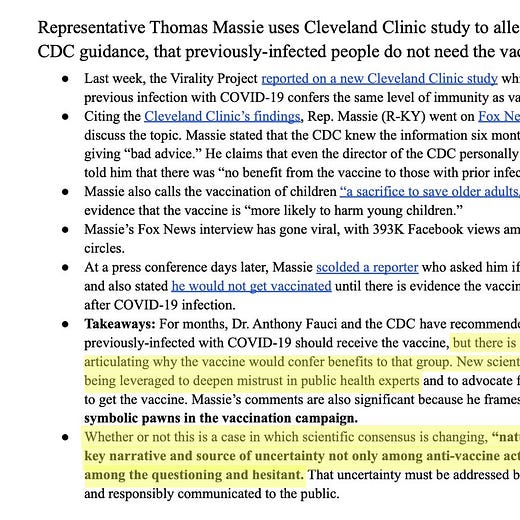
2:00 PM · Mar 17, 2023
697 Reposts · 2.54K Likes

Matt Taibbi@mtaibbi
36."OFTEN TRUE CONTENT" The Virality Project communications mirror those produced in the recent court case Louisiana vs Biden, which showed Facebook admitting to the WHO that it, too, was censoring true content.

2:00 PM · Mar 17, 2023
579 Reposts · 2.16K Likes

Matt Taibbi@mtaibbi
37.From the start, Stanford explained the Virality Project would essentially continue the work of its 2020 Election Integrity Partnership. “The same JIRA system from the EIP is up and running,” they wrote.

2:00 PM · Mar 17, 2023
433 Reposts · 1.93K Likes

Matt Taibbi@mtaibbi
38. In the last #TwitterFiles thread, we posted a video of EIP Director Alex Stamos describing that project as Stanford trying to “fill the gap of things the government couldn’t do” legally. (h/t Foundation for Freedom Online).
youtube.com
StamosEIP

2:00 PM · Mar 17, 2023
509 Reposts · 1.98K Likes

Matt Taibbi@mtaibbi
39.We also showed video in which Stamos introduced EIP Research Director Renee DiResta as having “worked for the CIA.” DiResta in 2021-2022 would be listed as a “Stanford scholar,” “leading” the Virality Project. youtube.com/watch?v=GsooGv…

2:00 PM · Mar 17, 2023
494 Reposts · 2.07K Likes

Matt Taibbi@mtaibbi
40. By October 2020, Stamos was hinting at the direction of the future Virality Project, telling a national cybersecurity conference that the “Anti-Disinformation” mission needed a new focus.
2:00 PM · Mar 17, 2023
337 Reposts · 1.78K Likes

Matt Taibbi@mtaibbi
41.“We talk way too much about foreign…it's sexy, and it's fun, and it's a little bit cold warry,” Stamos said, adding the “vast majority” of problems were now domestic. “We have like an 80-20 breakdown... I think that needs to be flipped.”
youtu.be
CISA Cybersecurity Summit: “I think we talk way too much about foreign influence”

2:00 PM · Mar 17, 2023
395 Reposts · 1.84K Likes

Matt Taibbi@mtaibbi
42.VP’s partners: DOD-funded Graphika, the National Science Foundation funded Center for an Informed Public (CIP), the GEC-funded DFRLab, and the NYU Center for Social Media and Politics, or CSMaP.
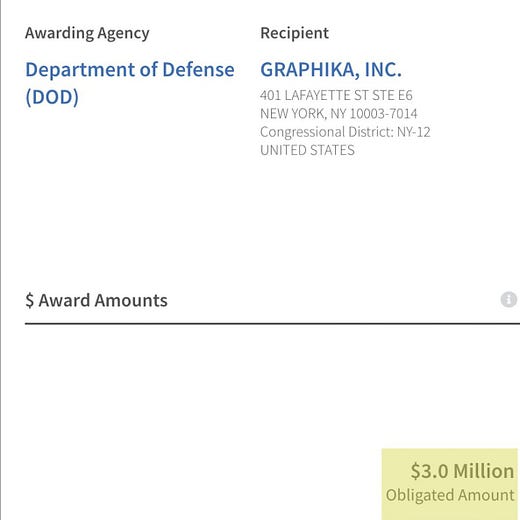
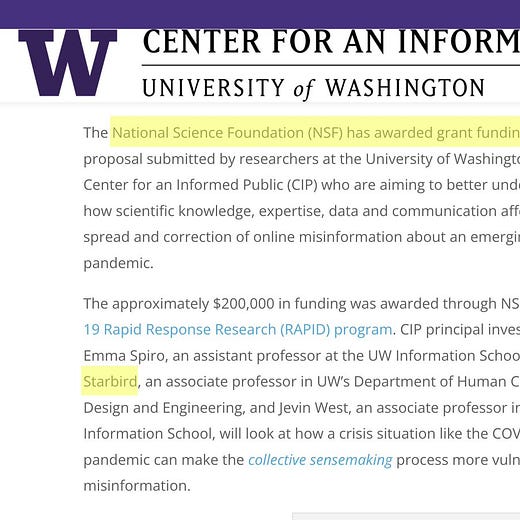
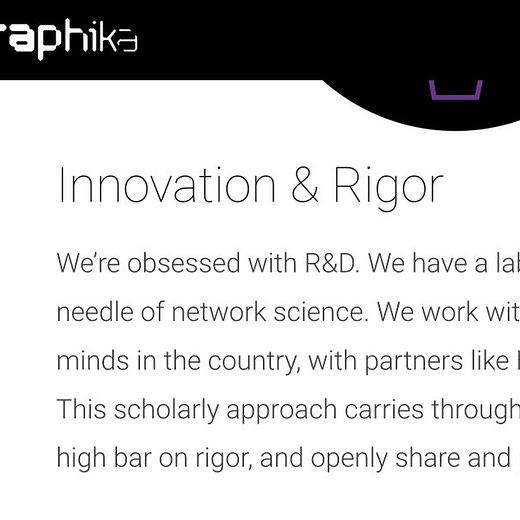
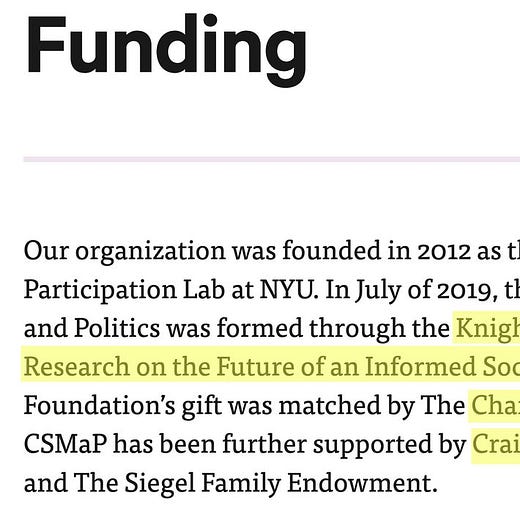
2:00 PM · Mar 17, 2023
391 Reposts · 1.91K Likes

Matt Taibbi@mtaibbi
43.VP would later say it partnered with “several government agencies,” including the Office of the Surgeon General and the CDC. It reportedly also worked with DHS’s CISA (Cybersecurity and Infrastructure Security Agency) and GEC, among others.
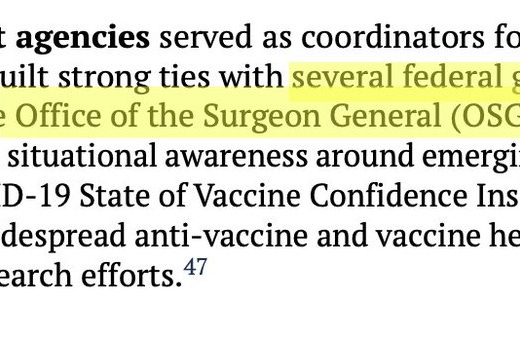
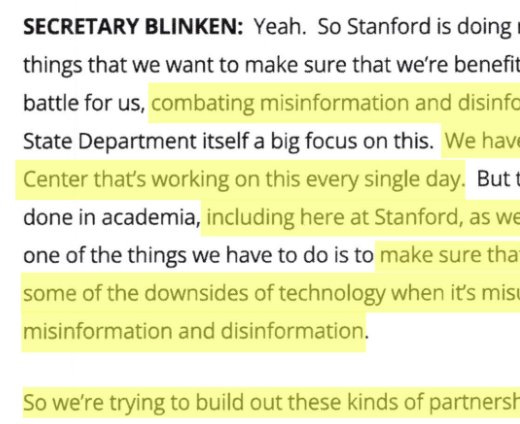
2:00 PM · Mar 17, 2023
442 Reposts · 2.01K Likes

Matt Taibbi@mtaibbi
44.To recap: America’s information mission went from counterterrorism abroad, to stopping “foreign interference” from reaching domestic audiences, to 80% domestic content, much of it true. The “Disinformation Governance Board” is out; but truth-policing is not.
44.to
株式会社ナレッジフロー

2:09 PM · Mar 17, 2023
944 Reposts · 3.32K Likes

Matt Taibbi@mtaibbi
45. Special thanks to @NAffects for hard work on this story, with @Techno_Fog, @ShellenbergerMD, @bergerbell, @SchmidtSue1, @aaronjmate, and the racket.news team. Thanks especially to @MikeBenzCyber. Searches conducted by a third party; material may be left out.
2:09 PM · Mar 17, 2023
442 Reposts · 2.83K Likes





























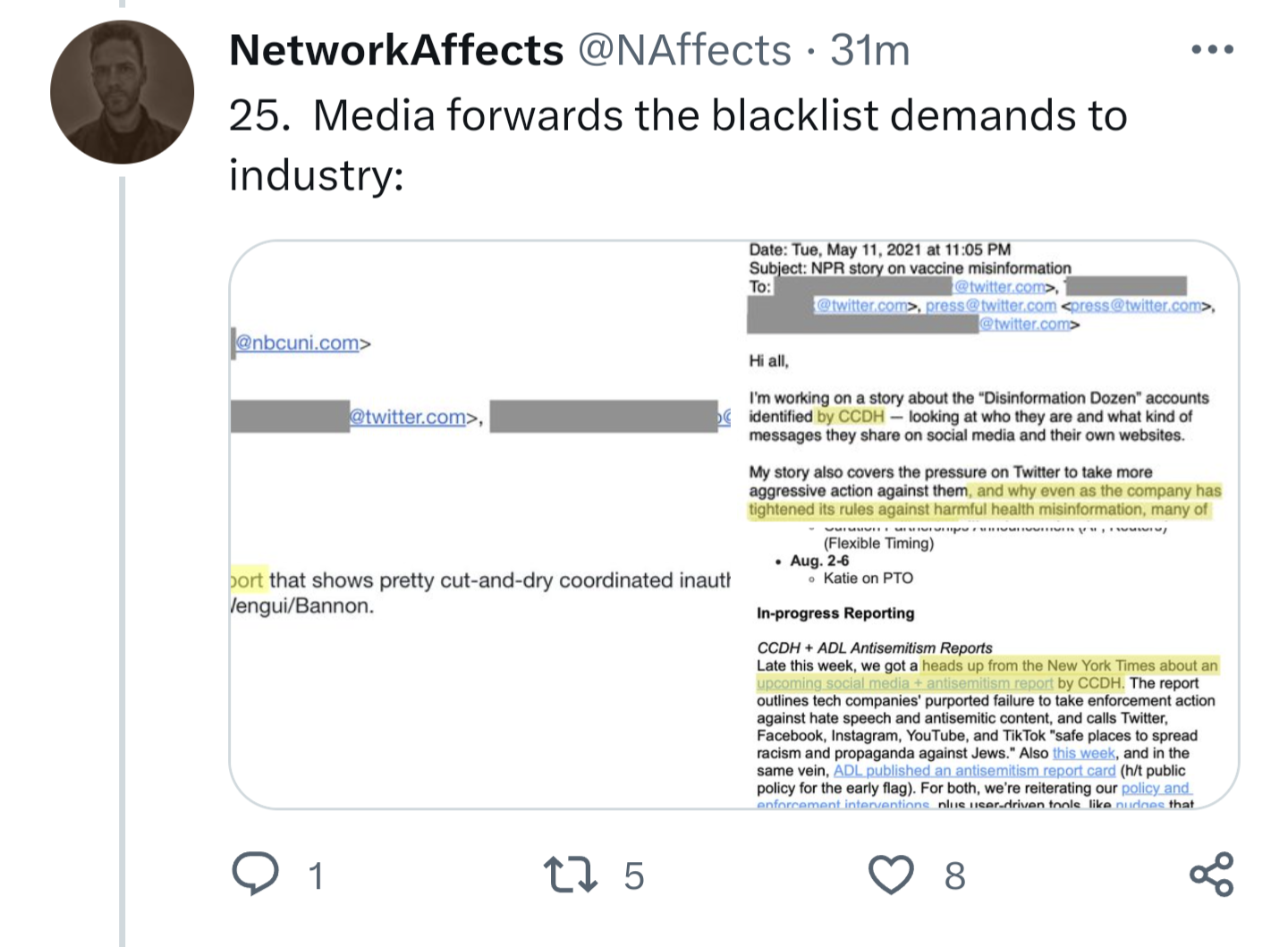







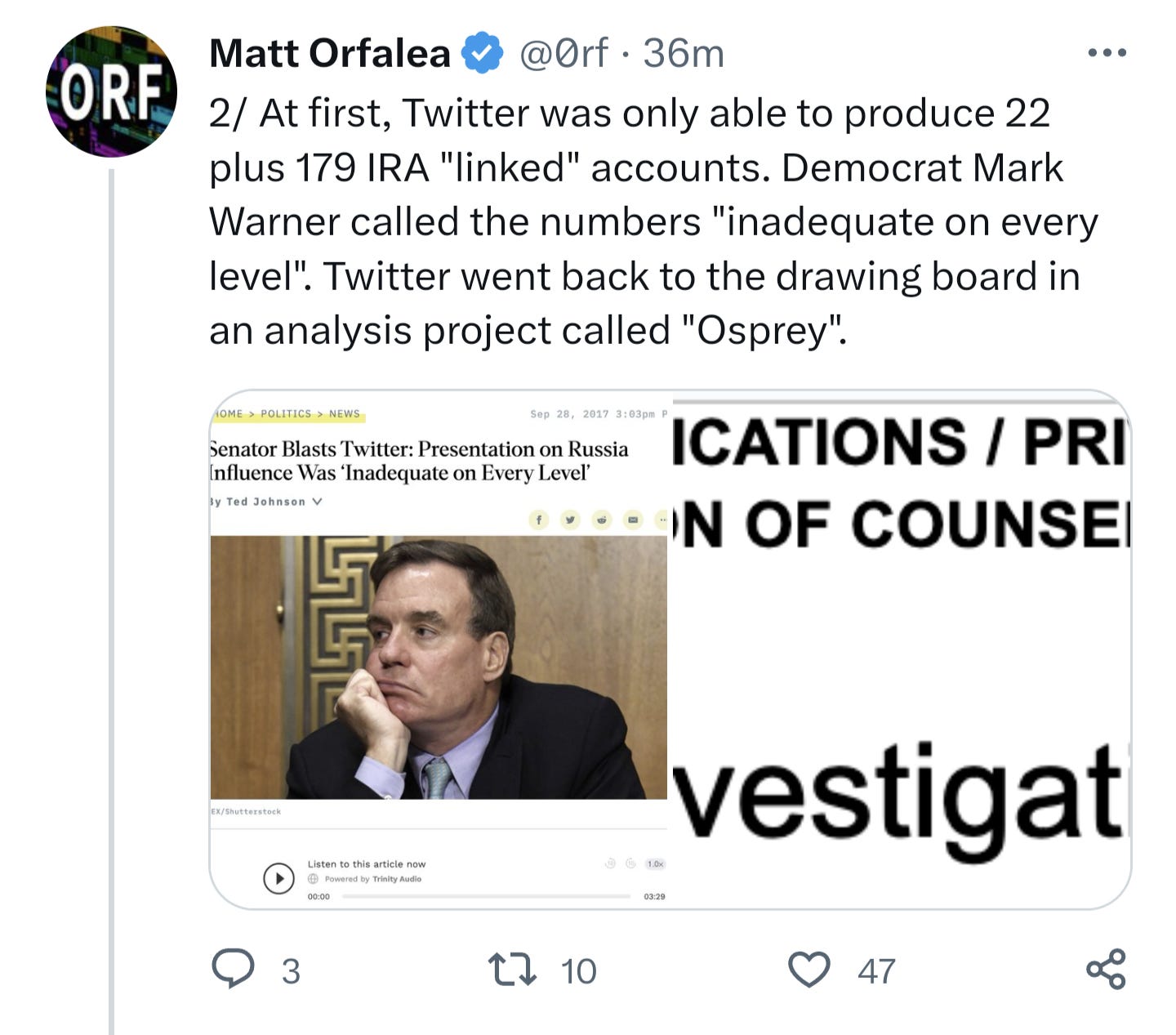














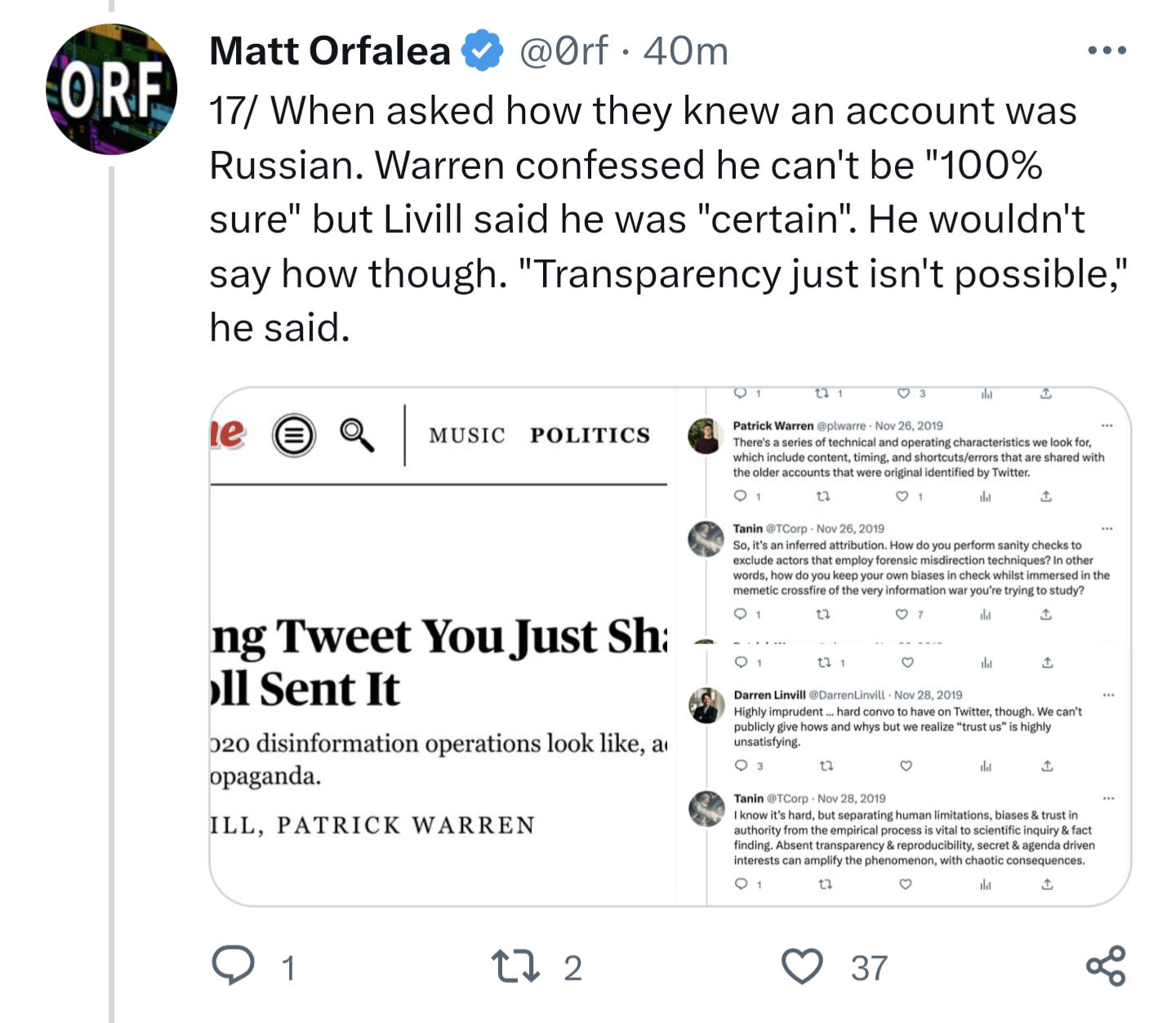








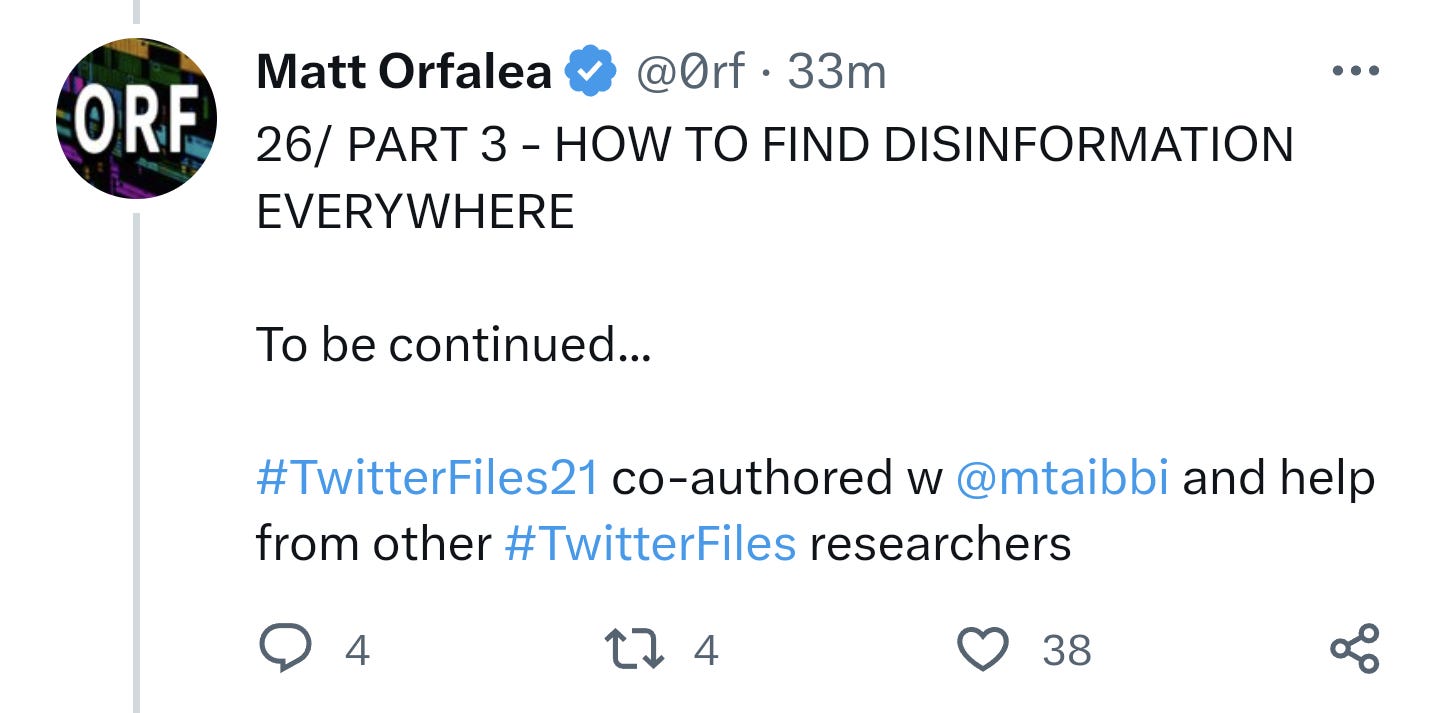
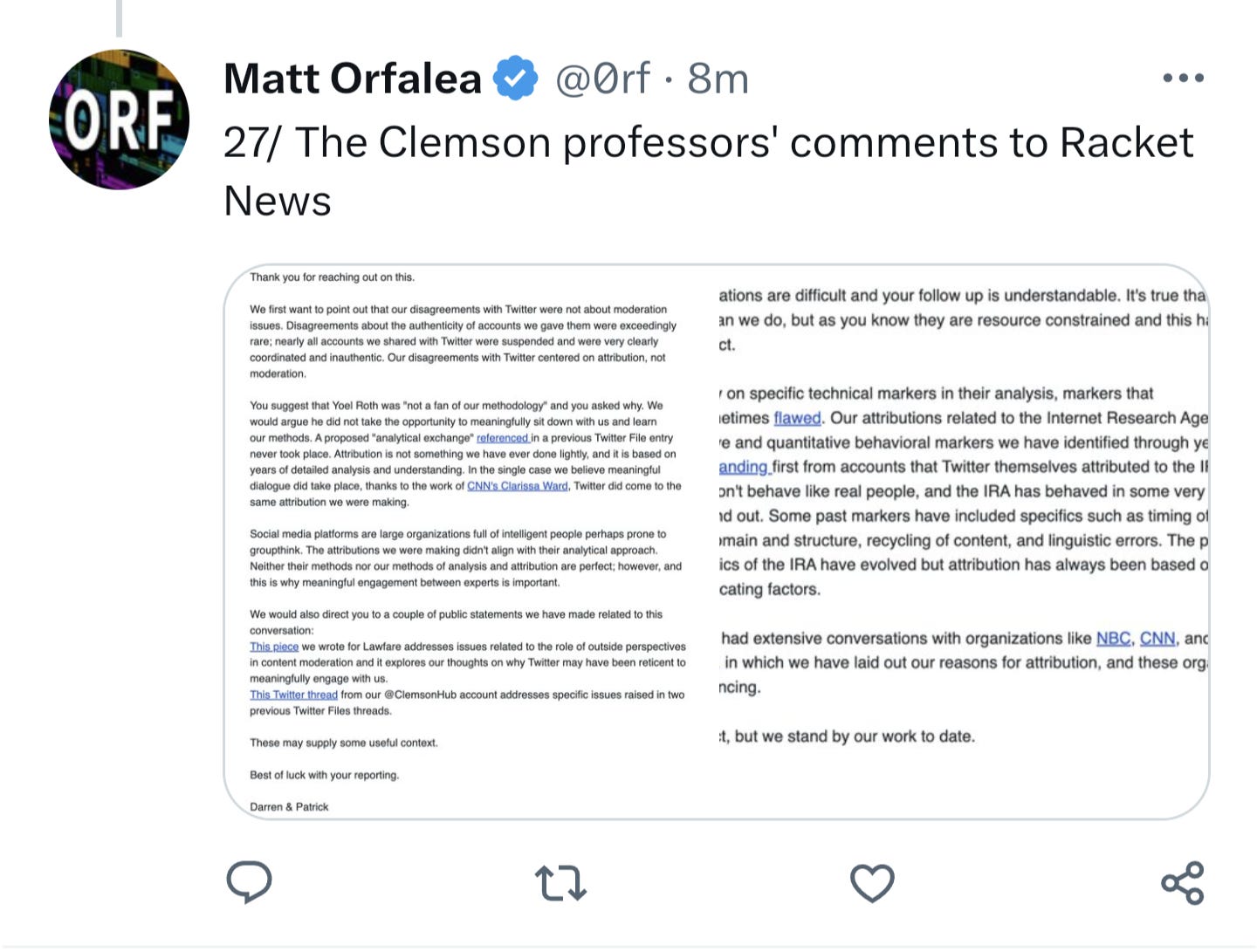



A marvelously useful recap and resource. They tell the story well.
You mention Greenwald. He moved to substack from The Intercept, which he cofounded, when it refused to run anything critical of Joe Biden before the election. That was saying the quiet part out loud: We call ourselves liberal but are in fact partisan.
Brad - Your the best - all SIX parts unrolled in one easy to find location.